
Expansion Of Telehealth To Make It Part Of The Permanent Workflow By CIOs
Over the past two years, hospitals and health systems have quickly deployed several telemedicine systems to look after patients during the ongoing Covid-19 pandemic. But unfortunately, many of these systems were not planned in great detail or designed with a view to sustainability.
Nonetheless, telehealth has taken root, and now healthcare providers face the future with mixed care: personal care and virtual care. As a result, providers are starting to think more about their applications of telemedicine technology.
CIOs and other health IT leaders are thinking about implementing health systems across hospitals and enabling doctors to use technology in their current workflow. Moreover, many officials are considering expanding the scope of technology in the hospital to include all departments.
Hospital’s technological needs have changed rapidly during pandemics, and many patient-facing systems are rapidly operating to meet the demand for video visits.
Hospitals seek permanent designs that are part of their workflow.
In the last few months, what happened across the country has been shocking and has led to telehealth’s emergence from most healthcare systems’ basements. The concept that was once considered a “pleasure” at the use-case level quickly became a “necessity” at the enterprise level throughout the patient’s journey.
Many realize that successful, integrated telehealth solutions are more than just doctors on-screen. Instead, when deployed comprehensively, they act as a digital front door to the health system, delivering clinical experiences and ultimately improving patient commitment.
Integrated care for the individual has been proven to prevent and reduce health risks, and you can use virtual care technology to improve care outside of a hospital setting.
Telehealth is no longer a separate component or competitive advantage for hospitals and health systems – it is a requirement and will provide financial benefits, improved reputation, and care.
Embedding system-wide telehealth technology as part of their ongoing workflow
Streamlining technical and administrative processes related to providing virtual care through modern and unified platforms will simplify the workflow and improve the care experience.
Combining technology and administrative processes reduces the administrative burden on platform users and increases communication and collaboration in the team.
A single platform promotes fewer login, screen, and apps and extended capabilities such as viewing appointments, accessing current patient information, and combining chat and video appointments with colleagues.
It is imperative to access the curated data presented as actionable insights on the same platform- This enables better personal care throughout the patient’s most needed journey.
Virtual access to patient’s room
How can CIOs and their team take advantage of this technology and expand it within the four walls of a hospital? For instance, in every department, or even on every TV screen in every patient’s room.
Equipping each patient’s room with telehealth capabilities and virtual access gives carers instant access to patients for various cases.
Virtual nursing units are an example of this idea. About two-thirds of nursing tasks, such as drug testing and some paperwork, are activities that do not need to be touched, and the caregiver does not need to be physically at the bedside.
By enabling each patient room in a virtual nursing unit with telehealth equipment, bedside nurses can focus on providing high-quality patient care by carrying the burden of non-functional care and administrative tasks. We have seen virtual nursing units that can discharge patients about 20% more than conventional nursing units within two hours of receiving a discharge order.
Furthermore, some of these units discharge patients 44% more in the afternoon than their traditional nursing counterparts. These metrics help increase productivity in opening rooms early to accommodate more patients and improve patient satisfaction.
It is also vital to note that patients often interact with people other than doctors and hospital caregivers. Virtual in-room care, often via a hospital room TV or another in-room device, can enable social workers or family members to communicate safely and efficiently with the patient while in the hospital.
Where to get the best telehealth solution?
DENmaar’s telehealth solution provides a quick and secure way to start a telemedicine session with the ease of a phone call. Whether starting with an electronic medical records system or a provider application, a click of a button prompts a patient to start a session.
DENmaar’s TeleHealth system is HIPAA compliant, providing a safe way for patients to quickly and safely provide treatment or prescribed services.
Telehealth, telemedicine, and telenursing are changing the world of healthcare forever as we know it. DENmaar is part of that change, and so can you. Call us today!
Learn More
5 Credentialing Issues in Healthcare & Their Resolutions
Credentialing issues in healthcare are extremely common. In fact, the process of provider credentialing has to be a prominent compliance issue for medical practices. It is quite normal for providers to have their applications rejected due to omissions and errors. The consequences can be considerably more disastrous without proper data insight and process oversight.
Table of Contents
- 1. 5 Common Credentialing Issues
- 2. Overcoming Issues with Healthcare Credentialing
- 3. We recommend verifying your state’s guidelines for:
- 4. The Bottom Line
Now, mistakes happen in any process. However, the mistakes in credentialing can be especially punishing. For instance, credentialing issues for nurse practitioners can cost a nurse their career. Moreover, mistakes in credentialing can cost healthcare organizations their hard-earned reputation. Suffice to say, no one can afford the legal and financial complications that follow a poorly executed credentialing process.
In this article, we would like to shine a light on some of the most common challenges with the medical credentialing system. We hope that being aware of these challenges will make you better equipped to tackle them.
5 Common Credentialing Issues
1. Keeping Information Up-To-Date
Many healthcare organizations struggle to access relevant applicant information. It is estimated that around 85% of submitted applications suffer from inaccurate, missing, or irrelevant information. It is mandatory to re-attest even minor changes like changes to address and phone number in the CAQH database.
Missing information or outdated details can quickly derail the already complicated and time-consuming credentialing process. The issue becomes even direr when you consider how frequently individual practitioners change the healthcare institutions they work for. Healthcare organizations must keep pace with the changes as they occur to avoid issues during the process.
2. Time-Consuming
It is no secret that the medical credentialing process is a time-consuming one. An application review can take around 90 days to complete. When you consider the involvement of additional stakeholders like contract negotiators and insurance companies, the process can easily go as long as six months. That is a long time and most healthcare organizations find their operations stalled because of it.
3. Staying Compliant
As we mentioned before, compliance issues are most prevalent in the credentialing process. Each state has different standards and policy guidelines that a provider needs to adhere to. Additionally, national organizations like CAQH have their own specific requirements that have to be met as well. This, of course, causes frustrating issues.
Read More: Credentialing Process Checklist You’ll Need in 2022
The rules, regulations, and requirements for medical credentialing vary from state to state. It also doesn’t help that these rules and regulations are volatile and experience frequent changes. It is important to leverage a reliable credentialing service or system to keep up with varying and changing regulations.
4. Challenging to Change Credentialing Program
As your healthcare organization grows and credentialing requirements become inevitably more complex, you will have no choice but to add integrations or switch to a different assessment system entirely. Migrating information in such a scenario, especially when you have a lot of preset prompts and questions that are not standard compliant, can become almost impossible.
You will have no option but to lose one or two components to make the migration possible. It is precisely because of this reason that many healthcare organizations get stuck with outdated platforms that are not capable of efficiently undertaking the credentialing process.
5. Ensuring the Privacy of Healthcare Professionals
Background checks are an integral part of the credentialing process. They are essential to determine that the applicant possesses the skills and qualifications required to provide care to patients. The process entails the submission of crucial documents such as practice license, work history, education qualification, etc.
As such, privacy become of the utmost importance. The credentialing organization will require information about an applicant’s entire history. Not disclosing this important information can result in the practitioner’s application being rejected. You will need a credentialing service or platform that keeps all of this information up-to-date and secure from prying eyes. Sadly, most organizations don’t have adequate platforms to safeguard such valuable information.
Overcoming Issues with Healthcare Credentialing
1. Outsource Your Credentialing Task
When it comes to hiring someone to overtake your credentialing process, there are two options at your disposal. You can try hiring an in-house staff that is dedicated to managing the process from start to finish or opt to outsource the task to third-party specialists like DENmaar.
Out of the two, outsourcing is evidently a relatively more cost-effective and time-efficient way to handle credentialing. With outsourcing, you get access to credentialing experts and their technology. Moreover, you aren’t saving money by not hiring personnel on salaries.
2. Pay Special Attention to Individual State Guidelines
It is important to do your homework with regards to what rules, legislations and policies would be applicable to your healthcare organization. As each state has different requirements, you need help of medical credentialing experts that are aware of policies and can help you with seamless and compliant transition.
We recommend verifying your state’s guidelines for:
- • Licenses
- • Education qualifications
- • Certifications.
3. Leverage Credentialing System Technology that Automates the Process
There are systems and advanced technology available today that can help your business automate the credentialing process to a good degree. We recommend looking for a credentialing platform that can:
- • Reduce Credentialing Workload Affecting Your Staff
- • Reduce Training Time for New Staff
- • Save time to focus on company growth.
Implementing such technology can be expensive. However, you stand to enjoy greater benefits in the long run with these technologies managing crucial aspects of your credentialing process.
The Bottom Line
Credentialing is no child’s play. Most healthcare organizations do not have the staff or resources to handle it with the care deserved. Fortunately, you can save yourself a lot of trouble by simply hiring credentialing specialists like DENmaar.
We understand how frustrating the process can be, and thus offer services dedicated to relieving you of this unwanted burden. We provide a fully automated system that gives you real-time updates of your credentialing application status. Plus, you get automatically notified by our robust system on the imminent expiration of documents, so your practice continues to legally serve patients with insurance. Moreover, we offer medical insurance credentialing services for sole practitioners as well as huge medical organizations.
Learn More
What is Medical Credentialing, and How it Works & Costs?
Medical credentialing is a complex concept to understand. So it is only natural for one to have several questions about it. In this article, we aim to answer some of the most frequently asked questions surrounding the topic, and in the process, help you understand this complicated but fundamental aspect of our medical world even better.
Table of Contents
- 1. How Exactly Does Medical Credentialing Work?
- 1.1. What are the Benefits of Medical Credentialing?
- 1.2. Can a Provider Allowed to Work During the Credentialing Process?
- 1.3. What Kind of Facilities Need Credentialing?
- 1.4. What is the NCQA?
- 1.5. What is TJC?
- 1.6. What is CMS?
- 1.7. What Does Primary Source Verification Mean?
- 1.8. What is the Credentialing Committee?
- 1.9. How Long Does a Medical Credentialing Process Last?
- 1.10. How much will Medical Credentialing Cost You?
- 2. What Do I Look for in a Credentialing Service Provider?
So without much further ado, let’s get started.
How Exactly Does Medical Credentialing Work?
Medical credentialing is a process undertaken with the main purpose of maintaining high standards of quality expected from the medical industry. The process usually entails the verification of a healthcare provider’s competency with regards to their educational qualifications, work history, certifications, etc.
A credentialing authority will contact a provider’s university, certification board and licensing agency to verify whether he or she is capable of providing healthcare. Credentialing is considered to be imperative for all types of providers who engage in providing medical assistance to patients. It needs to be conducted at regular intervals to make sure a healthcare organization or provider is complying with regulatory standards and policies set by bodies like the Centers of Medicare and Medicaid Services, The Joint Commission, National Committee for Quality Assurance, etc.
What are the Benefits of Medical Credentialing?
Medical credentialing has a plethora of benefits in store for all parties involved with the process. Credentialing provides hospital and clinics with the assurance that their hired staff will offer their services at the level of standards expected of them. Insurance companies can keep their costs down by making sure only competent medical professionals pass the credentialing process.
Practitioners also benefits immensely from credentialing as they can expand their services to more patients with access to different types of health insurance. However, patients stand to benefit the most out of credentialing. They can rest assured on receiving the highest quality of care from the most qualified providers.
Can a Provider Allowed to Work During the Credentialing Process?
It is recommended for a healthcare provider to halt their services until the entire credentialing process is complete. This guarantees that all patients receive quality care from only those providers who have verified qualification to offer their services. A healthcare organization is putting itself in unnecessary risk by letting non-credentialed individuals work for them.
That being said, there are a few exceptions to the rule. Medical students, for instance, don’t need credentialing as long as their duties to do not cross the scope of their educational program. They typically don’t need to undergo credentialing as they are working under the strict supervision of superior credentialed providers.
What Kind of Facilities Need Credentialing?
Aside from practitioners, facilities that engage in the act of providing healthcare need credentialing as well. As such, the following services and facilities need to undertake the process to show they comply with the expected standards of care and competence.
- • Dialysis
- • Ambulance
- • Home Health Services
- • Hospice Care
- • Durable Medical Equipment
- • Independent Diagnostic Testing
- • IV Home Infusion Therapy
- • Laboratories
- • Prosthetics
- • Orthotics
- • Lithotripsy
- • Urgent Care Centers
- • Radiology
What is the NCQA?
The NCQA, aka The National Commission for Quality Assurance is an independent non-profit organization. Their job is to evaluate the quality of healthcare provided by medical practices and issues credentials based on their findings. The organizations that go to NCQA for credentialing include managed behavioral healthcare organizations, preferred provider organizations, credentials verification organizations, etc.
What is TJC?
The TJC, or the Joint Commission, is an organization tasked with maintaining high standards of healthcare in the United States of America. They conduct surveys that aim to verify the standards of healthcare provided by the hospitals in USA. Organizations like hospitals proactively answer to accrediting surveys hosted by the TJC every three years.
What is CMS?
The CMS, or The Centers for Medicare and Medicaid Services is a federal agency that serves under the United Stated Department Health and Human Services. It is responsible for performing a number of functions, which include evaluating quality standards of clinical labs and facilities that have been offering care to patients for a long time. The CMS works closely with state governments to administer and monitor Children’s Health Insurance Program, Medicaid, etc.
What Does Primary Source Verification Mean?
Primary Source Verification basically means that a credentialing authority will directly verify a provider or organization’s credentials from the source of that credential itself. For instance, a CVO will directly contact the university to verify a practitioners education qualifications. This is usually done to avoid fraud. As such, documents from third-party sources are not entertained.
What is the Credentialing Committee?
Credentialing committee is responsible for overseeing the entire application review process. They have to make sure that the applicants meet the desired set of quality standards. This committee will include doctors with varying specialties, a liaison with the CVO and a chairperson. If you meet the basic requirements of credentialing, you can appeal a committee’s decision. You will receive all the information needed if it is deemed that you have the right to appeal.
How Long Does a Medical Credentialing Process Last?
The medical credentialing process can be excruciatingly long. It can take anywhere from days to weeks, and sometimes months. Typically, you can expect the credentialing process to take as long as 90 to 120 days. As such, we recommend starting your application process at least 3 months before you begin your duties as a healthcare provider.
How much will Medical Credentialing Cost You?
The costs for medical credentialing will vary from CVO to CVO, organization to organization and specialty to specialty. Generally speaking, you can expect to pay around three to four hundred dollars for your application fee alone. You can also anticipate partial reimbursements after your credentialing process has been completed successfully.
You will also incur costs on periodic and re-credentialing as well. However, you can expect to get this done at a discounted rate.
What Do I Look for in a Credentialing Service Provider?
Experience and a good reputation are arguably two of the most prominent factors you must consider when looking for a credentialing service provider. Such service providers are usually home to credentialing specialists who possess the resources, insight and experience needed to handle the entire credentialing and re-credentialing process from start to finish in a quick, efficient and hassle-free manner.
You will find the above qualities demonstrated perfectly by the credentialing specialists’ right here at DENmaar. With years of industry experience, we’ve helped many providers and facilities get credentialed and can do the same for you.
Reach out to us at 844-727-3627 to learn more about our services.
Learn More
Why Does Patient Scheduling Needs An Upgrade?
Healthcare providers can take these necessary actions for the patients in scheduling appointments.
Patients always look for convenient and flexible access to healthcare, and for many, this means looking for self-care options. In addition, healthcare approaches influence digital experiences in other industries, including hospitality and travel, in many ways.
For example, self-scheduling bypasses common barriers to access, such as working hours and waiting times. In addition, by enabling patients to schedule their services, physicians build commitment, which has been shown to bridge the gap in care.
The experience of digital patient participation has evolved significantly during the Covid-19 pandemic. With asynchronous symptom screening tools that can be deployed with the help of cloud-based platforms like DENmaar, the care experience can start online quickly. Moreover, the patient’s scheduling is particularly strong during the vaccination process.
When the COVID-19 vaccine became available in late 2020, thousands of people were at risk of overwhelming the health system due to the need to vaccinate quickly and efficiently. The automated self-scheduling process reduced the burden on healthcare workers and enabled patients to choose visits for themselves, allowing healthcare workers to focus on other priorities.
According to a study, about 80 percent of patients prefer doctors who offer online scheduling. Also, a 2019 survey found that 70 percent of patients said they would choose providers who would send emails or texts to take preventive or follow-up care.
Healthcare systems need to evaluate their scheduling options to avoid long waiting times and poor patient experiences because it can affect their ability to attract new patients and retain existing patients. Moreover, patients and staff will benefit from investing in better digital solutions, such as scheduling options.
While making scheduling more straightforward and accessible for patients will help fill out calendars, canceling appointments and no-shows can create vacancies at the back-end of the scheduling process. Patients cancel or miss medical visits for various reasons, but good patient participation strategies can help providers move forward and keep up with the scheduling software.
Here are the top four reasons why patients cancel medical visits and what providers can do to address these issues:
1. Anxiety before an appointment due to unknown fears
For many, the fear and apprehension of seeing a doctor can cause visits to be avoided, delayed, or cancelled. Patients fear the bad news, are reprimanded for postponing treatment, and are uncertain about their financial responsibility. Patients may wait for the visit to avoid a blood test or some tests and procedures. Concerns about exposure to Covid-19 have also increased over the past year, resulting in more patients postponing care or cancelling visits.
Helping patients understand what to expect during their visit helps reduce the fear. In addition, offering virtual care services such as video visits and remote patient monitoring is an excellent option for patients in times of global health crisis.
2. Concerns about high financial costs
Out-of-pocket expenses and employer deductions are higher than usual. According to a poll, many say they do not receive the medical care they need because of the cost. Twenty-two percent of those surveyed stopped treating a severe condition because of the cost.
Helping patients understand their financial responsibilities and educating them about payment plans and their financial options can help reduce cancellations. In addition, using automated digital recording and recording software can help medical office staff gather information about early payments on a patient’s journey and help them have a better conversation about financial resources and responsibilities before a visit.
3. No convenient schedule
Studies show that people work longer hours per week. Challenging work schedules, family lifestyles, and personal commitments make it difficult for some to prioritize their health. When the consequences of taking a break from a workday to see a doctor seem more severe than a health problem, it is easier for patients to prioritize meetings and tasks than their scheduled doctor’s visit, especially if they are not seriously ill.
The availability of flexible scheduling options and virtual care can play a role in helping patients prioritize their health, even in their busy schedules. Also, updated integrations in EHR with video conferencing tools can enable seamless and secure digital encounters for patients.
4. Unavailability of appointment
Increased queues and waiting times can significantly affect cancellation rates. Sick patients, frustrated by waiting so long for an appointment, are more likely to have it cancelled and taken care of in an emergency or retail clinic.
Keeping a small percentage of appointments for daily visits and offering virtual care to visually impaired patients make’s it easier for patients to remain loyal to their known providers and reduces the likelihood of intermittent care elsewhere. Automated waiting list software can help medical offices fill out cancelled visits of patients expecting an early visit. Features that allow patients to schedule for several weeks or even months can help keep patients well and promote a good schedule.
Expecting and working with patient barriers can help providers build a system that works for patients and lead to better financial, operational, and clinical outcomes. When appointment scheduling revolves around patient access and convenience, healthcare providers and staff also reap the benefits of efficient processing.
Who can take care of your patient scheduling?
The DENmaar Scheduler offers several key features that you should look for when analyzing the quality of a patient scheduling system. The DENmaar schedule may be available to operating staff, but they may not have access to the patient’s complete medical information. This feature helps reduce the risk of any privacy and security breaches.
DENmaar Scheduler is a one-click system for adding, removing, or editing visits, thus reducing the possibility of human error.
Since DENmaar scheduler providers have remote access to their patient portal schedule, it is helpful for them to adjust visits or availability as needed.
Learn More
How to Handle Claim Denials and Maximize your Reimbursements
It is hard to imagine what the healthcare scene would be like without medical insurance. Medical insurance is, after all, responsible for making health care services accessible to people from all walks of life. That being said, the process that entails claiming insurance and reimbursements can be incredibly frustrating and tedious to undertake with frequent claim denials being a major issue that healthcare organizations and providers face today.
A claim is said to be denied when a health insurance company refuses to pay the submitted claim. Frequent claims denials can affect the financial health of your healthcare organization. We’ve seen practices dissolve because of decreased revenue triggered by high rates of rejected claims.
So it is imperative for a healthcare provider or practice to know how to handle claims. This is precisely what we will be focusing on in this article.
So without much further ado, let’s understand what cause claim denials and how you can avoid or manage them to maximize your reimbursements.
Common Reasons for Claim Denials
The following are some of the most common reasons for claim denials:
- Missing or incorrect information
- Issues with provider network
- Redundant claim
- Inaccurate coding of service
- Non covered services
- No eligibility verification
- Delay in filing claims
- Insufficient medical necessity.
Preventive Measures you Can Take to Reduce Claim Denials
Like we said before, claim denials can diminish a practice’s revenue. Therefore, it is very important to develop a strategic process to identify what may have caused the situation and address it in time to maximize reimbursements.
As such, we believe the following preventive measures can help your practice accomplish that without a hassle.
1. Set up a denial management team
Having a dedicated team that is focused on identifying and resolving claim denials is a great way of handling this problem in an efficient manner. The team can be assigned the role of immediately identifying the cause of a denial, finding a solution to the issue and submitting an appeal on time to make sure the practice isn’t missing out on valuable reimbursements.
Their purpose would be to investigate each cause of a claim denial systematically in a bid to ferret out the root cause. They can then build a process that makes managing claim denials simple in the future.
2. Identify and Sort the Cause of Denial
We highly recommend identifying the root cause of a claim denial and then sorting them into groups. There could be a variety of reasons for a claim being denied. It could be missing information, incorrect billing details, or simple eligibility issues. Whatever the reason, your practice needs to document them and your staff must be appropriately trained to avoid these mistakes in the future.
3. Fast Action
It is recommended to not waste time when you get a notice of claim denial. Instead, you should immediately start working on an appeal that you will submit to make the insurance company reverse their decision. The process of re-submission is a complicated one, and as such, should be undertaken as quickly as possible.
Not submitting an appeal on time will result in your application being rejected for good while your practice suffers massive revenue losses.
4. Monitor Your Denial Management Process
Keeping a record of the denials you’ve received, when you’ve received them and the measures you took to address them, will ultimately help you monitor your effectiveness in dealing with such situations. You’ll know if your team is capable of handling denials, what area they are lacking in and if training would help decrease further errors.
We recommend using visual charts to determine the impact of claim denials on your revenue. You should also work hard to device and implement strategies at every fundamental step of your organization’s revenue cycle.
5. Outsourcing
Finally, if you find the whole process of handling claim denials overwhelming, you can always reach out to DENmaar to handle it for you. DENmaar specializes in end-to-end insurance credentialing, thus helping providers and healthcare organizations get on an insurance company’s panel. We take care of flawless documentation to make sure your submitted claims are clean, compliant, and have little to no chance of being denied.
If the claims are denied, we will immediately submit an appeal to make sure your organization isn’t losing out on hard-earned revenue. Outsourcing to DENmaar will also alleviate the burden of credentialing off of your staff, thus freeing them up so they can focus on providing better care to your patients.
The Bottom Line
All of the preventive measures we discussed above can help your practice avoid the time-consuming and costly denial management process. In fact, you will be able to handle claims more efficiently if you just identify the core reason behind the denial of claims plaguing your practice and use appropriate preventive measures to tackle them once and for all.
These preventive measures can be:
- • Including correct patient information and medical records in your application
- • Filing claims in a timely manner
- • Staying updated on changes in the insurance claim process
- • Training your staff in medical billing and coding
- • Employing a good EMR (electronic medical recording) system to get access to patient information.
- • Verify a patient’s eligibility and insurance before rendering service
- • Monitor your revenue generation cycle regularly.
Need help with claim denials? Contact us at DENmaar now for expert advice and assistance.
Learn More
How to Expand Private Practice Using Telemedicine in 2022
Let’s face it, access to healthcare for millions would have been practically impossible if it wasn’t for telemedicine technology. In many ways, people around the world were blessed with the technological benefits of telemedicine, which allowed doctors to consult and care for their patients while adhering to the strict covid-19 protocols that briefly became the new normal in 2020.
Telemedicine presents a convenient way for patients to reach out to healthcare providers through the internet or via a basic phone call. At the height of the pandemic, the use of telehealth was believed to have increased by 78%. This has made many healthcare organizations optimistic about telemedicine’s role in the future of the healthcare industry.
In fact, experts now estimate that almost $250 billion could be spent on virtual care. Private Practices can learn a lot from this growing trend and benefit immensely by adopting the technology as soon as possible.
The Many Benefits of Telemedicine.
There are countless benefits to adopting telemedicine technology. Some of the most prominent benefits are listed below:
- • Convenient for both patients and doctors
- • Access to healthcare for rural areas
- • Probably lowered premiums as virtual care makes the primary care provider the first point of contact.
- • Improved patient outcomes with remote monitoring
- • Improved access to behavioral healthcare, especially in regions lacking mental health care provisions.
- • Transit between home and clinic completely eliminated, thus saving time.
- • No long wait times
How Private Practices can Adopt Telemedicine
Private practices must first determine what services they wish to offer via telemedicine, after which, they should ensure that the service is provided in a simple, convenient, and secure manner.
1. Securing HIPAA Compliance
HIPAA Compliance can be an ideal starting point for private practices that want to implement telemedicine. This means that typical video conferencing solutions like Zoom and Skype won’t be suitable options as they do not adhere to HIPAA guidelines. Instead, you will have to work with third-party service providers that will develop a secure video conferencing platform specifically for your practice.
It is imperative to keep patient information safe and secure, which is not possible with free conferencing platforms like Zoom. So security should be your topmost priority when developing a telemedicine solution.
2. Outsource
Private practices won’t have the staff or resources needed to develop a telemedicine solution in-house. As such, it would be wise to find and partner up with a third party like DENmaar to design a telemedicine platform that caters to the needs of your practice.
3. Testing is Fundamental
Once you have the software to conduct virtual visits, do not jump the shark and start providing virtual care right away. Instead, test the solution thoroughly, preferably by experimenting with your staff to make sure the app is functioning appropriately. These tests will help you identify bugs and defects before the platform has been deployed and give you a chance to fix them. You can seek out the help of your app development partner to polish the platform before it is finally deployed.
Employing DENmaar’s Telemedicine Technology
If you run a Private Practice and wish to reap the perks of telemedicine, then look no further than the TeleHealth solution provided by DENmaar to satiate your requirements. Our TeleHealth solution offers a fast and secure method of initiating a teletherapy session with the simplicity of making a phone call.
Our TeleHealth System is HIPAA compliant, offering a secure means of providing therapy or medical e-prescription writing services to patients with ease and security. You can learn more about our TeleHealth system by contacting us today.
Error: Contact form not found.
Learn More
Why Is E-Prescribing Essential For Providers & Patients
The introduction of e-prescription in 2003 made it a more convenient, cheaper, and safer alternative to prescription for doctors, pharmacies, and patients.
Through electronic prescribing, or ‘e-prescribing,’ healthcare providers can enter prescription information into a computer – such as a tablet, laptop, or desktop computer – and use special software to transmit prescriptions to pharmacies and connect to transport networks securely.
The adoption of standards to facilitate the electronic prescribing process is a crucial government component in accelerating the adoption of electronic health records and building national health information technology infrastructure.
In short, the goal of increasing e-Prescribing is to improve workflow, increase patient safety, and increase transparency in future drug pricing.
What is e-prescribing?
Electronic prescribing is a process that healthcare providers use to send prescriptions to a patient’s preferred pharmacy.
There are several benefits to e-prescription software (Rcopia), including simplifying obtaining a pharmacy prescription, dispensing medication, and getting a new refill.
Medical software plays a vital role in the adoption and use of electronic prescriptions, as these solutions contain the necessary tools.
Imagine the challenge for a pediatrician looking at a new patient and deciding what medications they can take, exceptionally if the patient’s parents did not prescribe them ahead of time. In such cases, determining what medications the young patient is taking or what may be allergic to them becomes more complex and dangerous.
Electronic prescriptions are just one condition that describes the immediate benefits of electronic medical records (EMR) software. However, these tools are essential features of the best medical software, offering healthcare providers a detailed look at a patient’s medication history, even if they’ve never seen one before.
In 2019, doctors used e-prescription for controlled and non-controlled substances online at a higher rate than in the previous two years. In addition, online prescriptions for uncontrolled substances increased from 76 percent in 2017 to 86 percent in 2019.
While the COVID-19 epidemic affects patients and providers worldwide, a reliable national health information network has never been more critical.
EPCS Technology
Many states enacted electronic prescription requirements, meaning that more prescriptions were written electronically, which helped protect patients’ prescriptions from fraud and abuse. Since 2017, the number of electronic prescriptions written has increased.
Furthermore, the introduction and use of Electronic Prescription for Controlled Substances (EPCS) technology aim to help providers integrate prescription information into EHR (electronic health records), which can increase patient safety and help prevent diversion and fraud. ECPS technology can also facilitate doctors’ workflow and reduce the burden on the patient.
Electronic prescription software options
Some popular software choices for 2022 offer e-prescribing for healthcare organizations without an EMR system.
Other high-performance companies offer electronically prescribed programs that act as standalone applications or integrate with existing EHR platforms. These tools usually make finding prescription drugs easier, checking patient drug records, and obtaining real-time prescriptions. Most potential adverse reactions and drug tests against known patient allergies are also indicated.
Best E-Prescription Software
With DENmaar, you would be able to access all the medication information regarding your patient at a button. The medications prescribed in Rcopia (e-prescription software) are pulled into our EHR, and we provide a very intuitive and easy-to-use access to the medication information. The data is extracted in real-time from the Rcopia portal and made available to provide a seamless experience.
Why is e-prescription essential?
Prevent clerical errors
According to a Food and Drug Administration study, there have been 95,000 prescription errors since 2000. One of the major causes of this problem is that many drugs are similar or have similar spellings. Electronic prescriptions help to illustrate this by showing drug options side by side and allowing providers to customize the prescription of their choice.
Complete the patient’s medical records
The second most important advantage of e-prescription is its data management capabilities. By keeping medical records, other healthcare providers can determine what prescription medications the patient is taking and when their prescription was last filled. In addition, electronic prescriptions can redefine compliance by making it easier for states to track prescriptions in multiple pharmacies and allowing states to integrate them into prescription drug monitoring programs (PDMPs).
Healthcare provider recommendation tools
Electronic prescribing provides instant information on allergies, drug interactions, and duplicate treatments, providing health professionals with the data and professional intelligence needed to ensure patients receive the proper medication. Electronic prescriptions also include system alerts that notify healthcare professionals about potential drug interactions and repeat treatments.
A significant additional benefit of e-prescription is time-saving for pharmacy staff who calls to check orders. Moreover, carefully written prescriptions save time for pharmacy staff and doctors.
E-prescription capabilities allow physicians and healthcare professionals to meet all the challenges and make it easier to determine which medications the new patient is taking – even if they do not remember them before the visit.
Learn More
Nurse Practitioner Credentialing: Why is It Vital for Nurses and Healthcare Organizations?
Credentialing is usually considered to be a process only meant for physicians. This cannot be any further from the truth. In fact, credentialing is equally important for all sorts of practitioners who participate in the provision of patient care, this also includes nurses. There are immense benefits to be enjoyed by a nurse who is credentialed. They can work towards advancing their career with recognized achievements and contribute to their own professional growth.
What is Nurse Credentialing?
Simply put, the nurse credentialing process involves the verification of an applicant nurse’s certifications and qualifications. This includes reference checks, verification of board-earned certifications, licensure, and educational qualifications, among many other things. This is usually done to ensure a nurse or physician is capable of providing healthcare to their patients.
Read More: Credentialing Process Checklist
Furthermore, it is mandatory for a nurse to be credentialed for a hospital or practice to be able to bill an insurance company or government agency.
What are the Benefits of Nurse Practitioner Credentialing?
Like we mentioned before, Credentialing is as fundamental for nurses as it is for physicians and equally beneficial. The following benefits await those nurses who are credentialed:
- • Professional Career Growth
- • Highlight Unique Skillsets
- • Helps employers reduce their administrative burden
- • Assure patients that their nurse is capable of taking care of them.
- • Give nurses a sense of accomplishment
- • Display a nurse’s commitment to his or her job.
Certification is an integral part of nurse practitioner credentialing. CEU credits, for instance, are important if a nurse wants to renew his or her license. Nurses are required to acquire certifications, which are specific to the scope of practice they indulge in. This is important if they want to continue pursuing their education or demonstrate their knowledge and skill set. Certifications are indirectly connected to the improved patient outcome as a certified nurse is better equipped with an expanded set of skills to take relatively better care of the patients they are in charge of.
Needless to say, certifications also improve the chances of a nurse getting employed. It increases their perceived value in the eyes of an employer. There is ample evidence throughout history that proves that nurses with credentials are far more likely to get hired than nurses without any certifications. Credentialed nurses are already assumed by hiring managers to possess the ideal knowledge and skill set needed to operate in complex patient care circumstances.
Aside from improving a nurse’s chances of getting hired, credentialing can also help boost a nurse’s average earned income. Certified nurses are believed to earn $10000 more annually than their non-certified counterparts.
This proves how important credentialing is to nurses. As such, it is important they get credentialed to enjoy an easy career ahead. That being said, getting credentialed comes with challenges of its own. The process can be far too time-consuming and frustratingly complex.
What is the Credentialing Process for Nurse Practitioners?
The credentialing process for nurse practitioners involves the following steps:
- • Select a certification body and apply
- • Send required information for verification
- • Participate in the exam
- • Get official certification
- • Go to the state board of nursing to apply for nurse licensure
- • Wait to receive the licensure for the board of nursing
- • Apply for a DEA and a controlled dangerous substance certificate
- • Apply for an NPI number
The applicant or the employer of the nurse should make sure all information submitted for verification is correct and complete. Any missing or erroneous details in the information submitted could result in the application getting rejected.
Unless the credentialing process is complete, the nurse practitioner cannot receive reimbursements for the services they render.
How long does the Credentialing Process take for New Nurse Practitioners?
The credentialing process can take anywhere between two to three weeks.
So as you can see, acquiring primary source verification for all nurse practitioners currently employed can be time-consuming for employers. The excruciatingly long process could result in delayed reimbursements and even delay the on-boarding process of a much-needed nurse to the staff.
This is why it is only wise to let a reputed third-party credentialing service provider handle the task at your behest. This is where DENmaar comes into play. With years of experience, our credentialing specialists at DENmaar can help your hospital and medical practice with the nurse credentialing process from start to finish.
You can explore our website to learn more or contact us now to get in touch with one of our representatives.
Learn More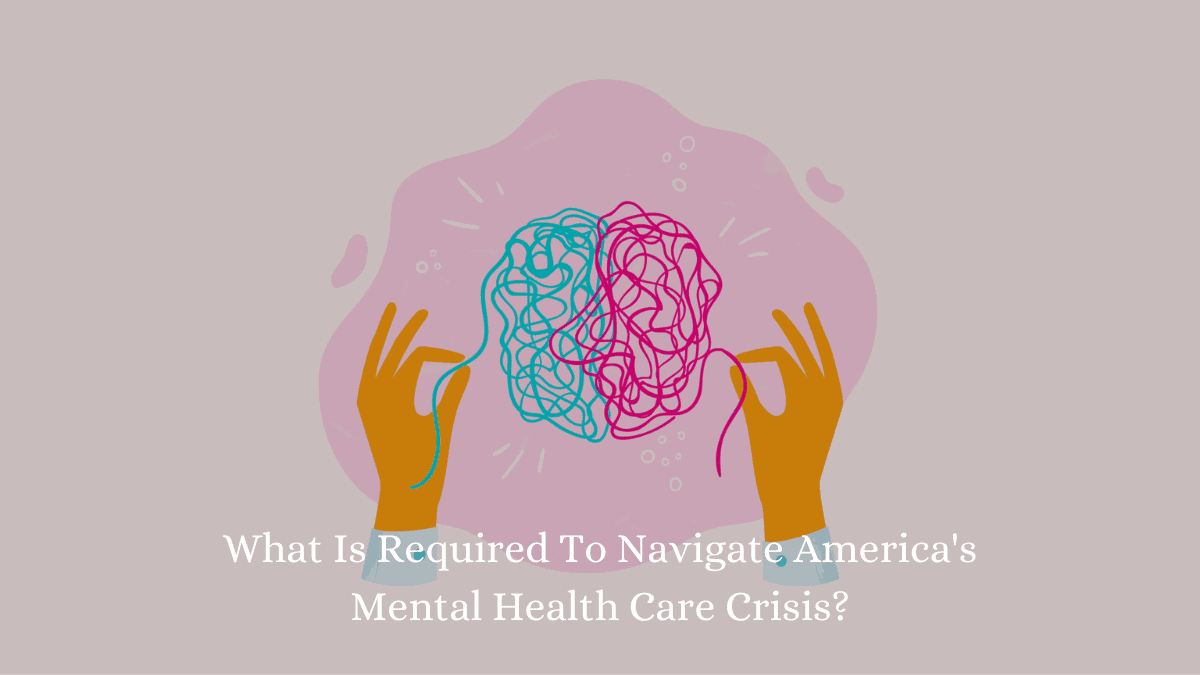
What Is Required to Navigate America’s Mental Health Care Crisis?
The demand for mental health services gets increased rapidly. However, with a shortage of psychiatrists, how can we ensure that providers deliver the best possible care to their patients.
The United States is experiencing an increasingly acute mental health crisis. Between 2017 and 2018, one in five Americans had a mental illness, and the epidemic has exacerbated feelings of anxiety, depression, and isolation. According to Mental Health America, moderate to severe anxiety reached its peak in September 2020, with more than eight out of 10 people showing moderate to severe symptoms at anxiety and depression screening.
The mental health care supply chain is down. More and more people are taking professional care, but it has become harder to get the care they need. They’ve found providers that don’t accept new patients, are out of the network, or just don’t fit.
Today, 37% of the US population lives in areas with a shortage of mental health professionals. For example, there are only 30 psychologists for every 100,000 people compared to 156 primary care physicians for every 100,000 Americans. Moreover, there is a national psychiatrists shortage, but more than half of those who practice therapy accept insurance or Medicaid, making high-quality care prohibitively expensive for many. Because of this lack of access, 60% of adults in the United States do not receive treatment for diagnosable mental illness each year.
The crisis affects all Americans, not just those with mental health symptoms and their loved ones. Mental health symptoms adversely affect physical health, leading to higher costs for insurance companies and employers to care for. For instance, people with the major depressive disorder show a considerable increase in patients compared to the total population.
Examining mental health care deficiencies
There are two major priorities for resolving this crisis: increasing the number of mental health professionals and helping those existing ones to handle their cases better.
The first is a difficult task. It needs an average of eight years of higher education and medical school and four years of residency to become a licensed psychiatrist. Even as new psychiatrists enter the field, more than 60% of psychiatrists are now 55 or older and rapidly retire. The fourth-oldest group in medical specialties will create a potential shortage of 6,000 to 15,000 psychiatrists by 2025.
This deficiency will put more pressure on the practice of psychiatrists. Fifteen-minute visits every three months have become the norm in many places, where there is not enough time to correctly complete the progress record, let alone provide high-quality medical care. The right long-term solution is to enable psychiatrists with technology and appropriate support functions instead of replacing them.
Innovation is needed, not first aid solutions.
There has been tremendous progress in increasing access from the adoption of telemedicine to premium consumer-focused therapy and mindfulness applications over the past decade. However, this is not enough.
Historically, the opportunities for psychiatrists have not presented themselves in a flexible, clinically driven way. High-quality providers are usually only available for hospitalized patients or on an out-of-network basis. Moreover, many find it challenging for
- Opening a private practice with low reimbursement rates for services
- Handling the burden of coordinating with insurance companies
- Working on the subsequent administrative tasks that follow every day
All the above factors can be stressful for psychiatrists, preventing them from giving remedies to their patients.
A blood test cannot diagnose depression, and psychiatrists do not have the right tools to track their patients’ progress. In addition, psychiatry lacks transparency and data for determining outcomes instead of most other disciplines. Research executed by the Centers for Disease Control and Prevention (CDC) found that almost 60% of psychiatrists do not use an approved electronic health records system, and 40% do not use it at all – meaning they are still writing on paper.
Technology can go a long way in more stressful aspects of managing mental health practices, including billing, insurance, and appointment schedules. But these measures have more potential, allowing providers to gain in-depth insights into their patients, track patient progress, enhance psychiatric practice, and achieve high-quality results.
Against the backdrop of the ever-increasing demand for the services of psychiatrists and mental health providers, it has become critical for providers to provide flexibility in treatment methods.
Who can be contacted to get the best mental health billing?
DENmaar provides an improved patient payment system, staff claim tools and quickly resolves the claim issues. Contact us today to do your credentialing using DENmaar’s psychiatric billing process.
Learn More
Mental Health Billing vs Medical Billing
Mental health bills differ from medical bills because of changes in mental health care that are not found in primary or specialist care. Here’s how to handle it.
- Mental health bills differ from medical bills due to some of the variables included in the mental health treatment providers.
- For mental health bills, you should familiarize yourself with medical coding, verify patient insurance, and use the appropriate payer form.
- For best results, always check the benefits, store copies of crucial information, take notes when you talk to payers, and start the billing process as soon as possible.
- Mental health professionals look to improve their existing billing process or start accepting insurance and working directly with fee payers.
Mental health care patients usually have one common complaint: Many providers do not have health insurance, which can be expensive without insurance. As a mental health care provider, your approach may be different. You may not accept insurance because the mental health billing process is complex and frustrating.
However, this guide can assist you in understanding the mental health billing process. In addition, improved mental health billing structures come with more capacity for patients using insurance, which means more revenue.
How are mental health bills different from medical bills?
Mental health bills differ from medical bills in the following ways:
Pre-authorization: Payers must pre-authorize mental health services to patients before submitting medical claims. However, a 2019 report found that mental health visits are five times more likely to be out of network than primary or specialist services. Unfortunately, pre-authorization – even if requested promptly – is rare and complicates billing.
Front Office Staff: Medical practices usually consist of administrative staff handling billing and coding, leaving practitioners to focus solely on patient care. This system is less common in mental health care systems. These practices are usually sole proprietorships or small partnerships, meaning they do not have front office staff. Without additional staff, practitioners should handle the billing themselves.
Standardized billing procedures: While primary care physicians often perform the same tests and examinations on their patients, mental health practitioners provide a very diverse and customized service. The recurring nature of primary care means that medical bills are usually ready to go. The opposite is true for mental health care, making billing more complicated.
Creating an excellent standard: Standardizing primary care means that practitioners can easily combine multiple services into one perfect bill. On the other hand, the more diverse nature of mental health services makes it more challenging to create significant bills. The result is a longer and more difficult billing process.
How standardization affects mental health bills
Standardizing services provided is probably the most significant hurdle of the above factors in mental health care billing. Standardization issues arise from how these factors differ from primary or specialist care:
Session duration: Medical billing assumes approximately the same time for each patient – after all, regular blood tests and physical examinations take a long time. However, the duration of mental health sessions can vary greatly. For this reason, mental health billing codes vary based on session length, which is not heard in medical bills.
Daily or weekly service limits: In general, there are no primary or expert level restrictions on how often a patient can be treated. The same does not apply to mental health services. In hopes of standardizing mental health care bills, taxpayers set the maximum number of treatments a mental health patient can receive in a day or week. These artificial roofs can present billing challenges.
Therapeutic method: Cognitive behavioral therapy requires an entirely different CPT code than psychoanalysis. The result is more billing challenges.
The Bottom Line
The billing process can be frustrating and usually leaves a big sigh of relief compared to treating patients. And if you’re worried about not completing the process yourself, the billing features of DENmaar can be invaluable.
We have assisted many health care organizations in their mental health billing process, thus helping them concentrate on patient care. Call us today!
Learn More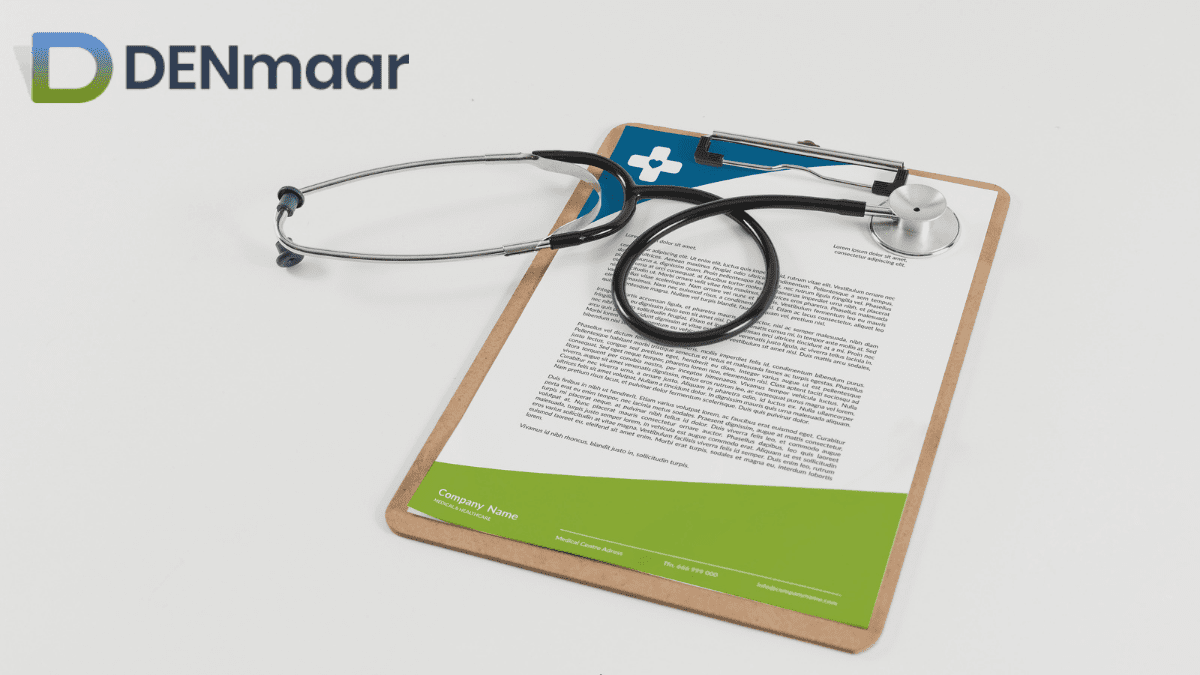
The only Physician Credentialing Process Checklist You’ll Need in 2022
Understanding the process of credentialing is simple. It is a process that entails the procurement and verification of information that ascertains whether or not a physician is capable of fulfilling his or her medical obligations. The process is fundamental for everyone involved with the healthcare industry. This includes the practitioners, nurses, and of course, the patients.
The credentialing process in itself, however, is burdensome, to say the least. A typical credentialing process can take 90 to 150 days to conclude. Hurdles like missing or incorrect information in the applications submitted can result in claim denials, which essentially means you’ll have to undergo the entire process all over again, costing you both valuable money and precious time.
That being said, you can’t simply ignore the process either. Credentialing is important for a variety of reasons.
- • It can help build patient trust
- • It lowers the risk of medical errors.
- • It helps medical organizations from losing revenue
- • It improves a practitioner’s reputation.
- • It can help you save costs
- • It protects healthcare organizations from future lawsuits.
Needless to say, the credentialing process is too valuable to pass. Yes, it can be uniquely frustrating to perform. However, we believe the following checklist can guide you competently for a smoother credentialing process.
So without much further, allow us to acquaint you with the only Physician credentialing process checklist you’ll need for a seamless experience.
Physician Credentialing Process Checklist
The very first thing to do when starting the credentialing process is to make sure you are always one step ahead. The way to ensure that is by starting as early as possible. With that out of the way, you can begin the process.
1. Submit the Pre-Application
It won’t take you time to notice or experience how tedious the credentialing process can be. To begin with, you will need to submit a pre-application based on the healthcare facility or insurance network you want to join. It is at this juncture in the process that insurance companies weed out applicants that are not eligible for credentialing.
This step involves a background check. You will be checked for:
- • Board Certifications
- • Criminal Records
- • Record of disciplinary action taken against you or your practice.
If any issues arise here, you will be asked to submit further information. If there aren’t any issues, then you move on to the next step.
2. Submitting the Applications
This step forms the actual meat of the process. You will be required to submit all information possible that vouch for your legitimacy as a healthcare provider. The most fundamental checklist will be as follows:
- • Transcripts and educational history
- • DEA registration
- • Board certification
- • Medical license
- • Continual malpractice coverage
- • Work history
- • Professional and personal reference
- • Explanation of gaps in work history
- • Personal immunization record
- • Personal health history
- • CAQH Enrollment
- • Hospital affiliation
All of the above information must be backed by solid documentation and relevant letters of recommendation.
3. Receipt Verification
Once the application is submitted, you might feel inclined to take a sigh of relief. However, it will be too early to do so. In fact, we recommend constant follow-ups via call and emails to confirm that your application has been received and is under review. The credentialing board may reach out to you for further information. If that does happen, we recommend submitting the information as quickly as possible. Make sure you have copies of all the documents submitted ready at a moment’s notice.
The above procedure entails the checklist for a traditional physician credentialing process. Medical practices may need to work with a new checklist to assist them in adding new providers. So if you are someone who runs a medical practice and wants to add a new provider to your staff, then the following checklist is for you.
Checklist for adding a new provider
- You will need to provide an updated CAQH profile with a new practice affiliation. Also, make sure the provider’s driving license and DEA are updated with the new state if the affiliation is different from their previous one.
- The group that will be adding the new provider will be required to supplement a list of payers that they are currently affiliated with. This will include Medicaid HMOs, worker’s compensation, Tricare, Medicare advantage, etc.
- Update your practice’s CAQH profile and supply tax companies with your Tax ID.
- You will be required to submit a new and updated malpractice policy and also update it in your CAQH profile.
- You will be required to provide the practice’s primary billing type. This information will be listed on your application with Tax ID.
- Mention Medicare’s PTAN that you plan to be included on. This information will be listed on the Medicare application of the new provider linked to your group.
- The following Documentation will be mandatory.
- • Professional State License
- • Board Certification
- • CAQH Login and Password
- • PECOS Login and Password
- • PLI Certification
- • Professional School Diploma
- • State Medicaid Login and Password
- • Current CV with precise beginning and end date
- • Hospital Admitting Privilege
- • Certification of completing internships, fellowships, etc.
The Bottom Line
Credentialing demands a plethora of information from practitioners. So much so that the whole process might feel a tad bit overwhelming. It also counts that all the information you do gather is complete and accurate. The consequences of failing to ensure that can be disastrous.
So if you are still confused about the process and have no idea what information to carry, then we suggest you give our physician credentialing specialists at DENmaar a call. We are at your service whenever you need us. We’ll assist you with the entire process as well, making sure you make it on a payer’s network without a hassle.
Contact us now to learn more.
Learn More
Provider Re-credentialing – Explained
You would be wrong to assume that the credentialing process is over once a provider has been accepted into a payer’s network. In fact, providers are required to undergo routine screening and license verification to maintain compliance and provide quality care to their patients. This process that involves periodic screening and verification is what we call recredentialing.
Recredentialing process is done to verify the training and qualifications of a provider and notify healthcare organizations if fraud or abuse is found. Now it is no secret that undertaking the credentialing process is no easy task. It can be time-consuming and burdensome. However, the cost of neglecting the procedure can be much direr.
Hospitals and similar healthcare organizations are staring at revenue losses in the upwards of millions on litigation, delayed payments, and civil monetary penalties without recredentialing.
Now that you know how important the process of recredentialing is, we will take a deep dive into the subject to make sure you learn everything there is to know about it.
So without much further ado, let’s get started.
Read More on Importance of Medical Credentialing
How Many Time Does a Provider Need to Be Recredentialed?
The answer to this question will vary from state to state. In most American states, the provider must be credentialed immediately when hired. Later, they must undergo re-credentialing every two years. There are exceptions to this rule, however, as some states like Illinois require providers to be recredentialed every three years.
To know exactly how often a provider needs to be recredentialed, it would be wise to check state laws and regulations that apply to your healthcare organization.
The Initial Requirements for Recredentialing
First and foremost, it is the responsibility of the healthcare organization to notify the doctors and nurses working under them at least 60 days before the recredentialing due date. Providers should be given access to all applications online. Remember, the recredentialing process varies from state to state and can take months to conclude.
To expedite the process, we recommend keeping the necessary documentation on file. We also suggest preparing organization-specific requirements well ahead of time. If the process is too overwhelming to handle, we recommend you give us at DENmaar a call and our credentialing specialists will be happy to shoulder the recredentialing process on your behalf.
Information Verified During Recredentialing
A traditional recredentialing process will entail the verification of the following documents:
- • Drug Enforcement Administration or Controlled Dangerous Substances Certification
- • State Licenses
- • Board Certification
- • Malpractice Claims History
- • Work History
- • Recent Malpractice Insurance Coverage
- • Medicare and Medicaid Sanctions
- • National Provider Identifier Number (NPI)
- • State Sanctions and Restrictions on Licensure and Limitations on Scope of Practice.
What Happens When an Application is denied?
A provider is notified with a written notice that includes the reason for denial in case their application is rejected by the credentialing committee. Providers have the right to submit an appeal contesting the denial. The provider must request reconsideration in writing within 30 days of receiving a denial.
The written request must be submitted along with the necessary documents. The reconsideration will be scheduled within 60 days. Remember, the provider has no further option if his or her claim is denied a second time.
Learn More on How to Avoid Payer Rejection During Enrollment
Getting Recredentialed Without a Hassle
Issues with recredentialing are more common than you would assume. That being said, there are ways by which you can make sure those issues never arise during your procedure. To begin with, healthcare organizations should maintain evidence of a provider’s application in a secure credentials file. They should also adopt a system that keeps all relevant information current.
However, the only guaranteed way to make sure you don’t fail with recredentialing is to seek help from credentialing specialists in the industry like DENmaar. DENmaar has been helping healthcare organizations across the United States with credentialing provider enrollment for decades now. As such, we have the talent, resources, and insight needed to handle the complex process of credentialing at the behest of your healthcare organization.
You can get in touch with us now to learn more about DENmaar’s recredentialing services.
Learn More
Best Practices to Avoid Payer Rejection During Enrollment
Getting enrolled into an insurance company’s network isn’t an easy task. Throughout the process, you’ll find that you have very little control over the outcome of the entire proceedings. You’ll find yourself at odds with the insurance companies whose network you so desperately want to join. Chances are that things might not pan out as you’d hoped.
Payer rejection is a reality that most providers do not want to ever encounter. Sadly, hearing a straightforward ‘No’ from payers after a very lengthy application process is more common than you can imagine. Most of the times providers have no clue what led to the rejection. What exactly went wrong that warranted the denial of an application? You’ll probably never know.
You can take solace in the fact that you are not the only healthcare provider in America that had to go through this ordeal. Getting paneled is not easy. It isn’t impossible either or as complicated as most people spell it out to be. There are a few steps or measures a provider can take to overcome a denial during enrollment.
This article will give you a peek at those tips, but first… let’s understand why application denials even happen in the first place.
Reasons for Insurance Panel Denials
You have to understand that insurance companies have the ultimate power to set and adjust the number of providers they accommodate into their network. Payers want to save costs for themselves while at the same time trying to fulfill the promise of better healthcare that they’ve made to their enrollees. As such, payers have a plethora of reasons to deny applications.
They can reject an application because of an error in the application, wrong or missing information, or if the provider doesn’t meet the dictated qualification criteria. Payers may also reject an application if they are currently not accepting providers belonging to a specific demographic.
Read More: Importance of Medical Credentialing
Other typical reasons for payer rejection maybe because of the following:
- • Failure to meet provider standards as dictated by the payer.
- • Over-saturation of a provider type pertaining to a service area or community.
- • The provider failed to comply with the payer’s conditions of participation.
- • The provider failed to meet requirements pertaining to out-of-state enrollments.
Persistence is Key to Overcoming Payer Rejection
Normally it’s typical of providers to simply give up once their application has been rejected. However, what they aren’t aware of is that they still have time to turn the tides in their favor. There are, in fact, a ton of things you can resort to in a bid to overturn your rejection. We know this can be daunting. As such, we highly recommend hiring a credentialing specialist to advocate at the behest of your case in front of the payers.
To begin with, try to request a face-to-face meeting or a conference call with the decision-makers to clearly convey your case. Remember, persistence is the key. Do not take ‘no’ for an answer. Reach out to the authorized personnel in the payer’s office to understand why your application was rejected and what you can do to fix the situation.
You can use LinkedIn to find the right people to talk to. For instance, go to LinkedIn and search employee titles under the payer’s company name. Try to connect with provider management representatives and initiate a conversation with them.
Most of the time, the reason behind denials has to do with the provider type. In such a scenario, providing more information even though the payers haven’t asked for it can make a lot of difference. Convey the demographic and the patient population you serve as a healthcare provider. This is more important if the demographic is related to any of the following:
- • Non-English-speaking communities.
- • Rural
- • Disabled
- • Geriatric
- • Pediatric
- • Chronic Condition
Steps to Take for Simple Provider Enrollment
You can try several things to get yourself enrolled successfully on the insurance company’s panel. A few of the things you can try are as follows:
- • Get letters that convey support from the community you serve.
- • Seek a second-level appeal from a decision-maker or manager of the insurance company.
- • Suggest a trial period where you will only serve a select number of patients, offering free comparison analysis when that period has concluded.
- • Make use of a phone instead of email or letters to clearly convey your message.
- • Request a face-to-face meeting and set up a conference call.
- • Compose a letter that shines a positive spotlight on the services of your practice or clinic.
- • Host an in-service visit to help payers better understand your services.
Learn more on Medical Credentialing Process
Getting paneled with an insurance company is no child’s play. It is an excruciatingly long process with multiple moving parts. One wrong move and you must undertake the entire enrollment process all over again, which can be both time-consuming and costly. As such, it is in your best interest to seek the help of credentialing specialists to guide you throughout the process.
This is where DENmaar’s provider credentialing services come into play. DENmaar is home to highly qualified credentialing experts that shoulder the responsibility of provider enrollment on your behalf. We do not rest until your place on the payer’s panel is secure.
To learn more about our credentialing and provider enrollment services, we recommend you contact us today.
Learn More
5 Essential Things to Learn About the Process of Medical Credentialing
Medical Credentialing can be defined as a process of verifying whether a healthcare provider is capable of performing his duties. This often complex and long procedure involves checking the credentials of a provider such as his or her education, residency, licenses, certification, training, etc. This makes credentialing a fundamental process, which is undertaken to help medical organizations against revenue losses and patients against poor-quality healthcare.
As such, medical credentialing is integral to the success of a healthcare practice. No healthcare practice, clinic, or hospital can hope to succeed without undergoing the medical credentialing process.
Regardless of whether you are running an established practice or are new to the game. Credentialing is something we at DENmaar recommend all medical practices take care of as soon as possible. To further convince you about the overwhelming merits of credentialing, we would like to shed light on a few facts about credentialing that every medical practitioner and enterprise should know about.
So without much further ado, let’s look at all of them.
1) Credentialing is Important to Prevent Revenue Losses
As someone running a medical practice, you must understand how important credentialing is to your enterprise’s revenue cycle. It is imperative to get credentialed if you expect to treat each and every patient that crosses the threshold of your medical practice. You have to be enrolled with insurance companies to get reimbursed for the care you provide.
It is highly recommended that new providers wait to treat patients until their credentialing process is complete. Moreover, established physicians themselves cannot treat their patients or receive payments from insurance companies for the care provided if their credentials have lapsed. They will have to wait until their credentials are again approved and verified to expect reimbursement for their services from insurance companies.
So both credentialing and re-credentialing are important to maintain the integrity of a healthcare organization’s revenue cycle. Timely credentialing ensures that a medical practitioner or practice is enjoying an optimal influx of revenue for the care they are providing.
2) Boosting Patient Confidence
As we mentioned before, the most important purpose of credentialing is to assure patients that the doctor and nurses in charge of their medical care are qualified to do their job and thus can be trusted with their care. Credentialing gives patients the peace of mind they need as they essentially put their lives into somebody else’s hands.
With credentialing, patients can rest easy knowing there was a rigorous process involved to verify the merit and experience of the healthcare provider taking care of them. The credentialing process can be a great way to identify deceitful providers and prevent them from defrauding patients.
3) Accuracy is Non-Negotiable with Documentation
Even minor errors during the documentation of your credentialing process can cost you dearly. It is extremely important to be careful when filling in important information that is mandatory for credentialing. There is an extensive amount of paperwork involved, which must all be executed accurately and in a timely manner.
Entering the wrong details, missing out on key information can delay the credentialing process for weeks. Worst case scenario, your application is rejected and you have to go through the entire credentialing process all over again. Suffice to say, this can be extremely frustrating. Hence, we recommend getting the documentation part right on your first go itself.
We also recommend having all the necessary paperwork in place as dictated by the National Committee for Quality Assurance. As such, you will have proof of due diligence and records, which can come in handy in the event of a claim’s denial or audit.
4) Follow-Up and Begin Early
Credentialing is an excruciatingly long process. The entire process can take somewhere around 90-120 days to conclude. So we recommend you start as early as possible to get credentialed in order to start inviting patients to your practice. You can hope to expedite the process by making sure all paperwork is taken care of and all details are filled incorrectly.
Make sure you follow up as frequently as possible with your verification sources. Request them to send you verification responses immediately. Follow-up throughout your credentialing process, right up until your application is approved. Do not stop until you’ve secured your enrollment.
5) Credentialing and RCM Go Hand-in-Hand
As Credentialing can help prevent revenue losses, it is only natural to draw a connection between it and a medical organization’s revenue cycle. Poor credentialing will result in delayed payments, claim denials, loss of revenue, and a number of other issues that harm an organization’s revenue cycle. In other words, credentialing helps keep the revenue cycle running, and as such, should be taken seriously.
The Bottom Line
Credentialing is extremely fundamental and no medical organization or practitioner can afford to ignore it, lest they don’t seek success in the ever-volatile and evolving healthcare industry. That being said, the credentialing process isn’t exactly child’s play. It can be time-consuming and dauntingly complex.
Most practitioners simply do not have the resources, time, or skill needed to handle the process efficiently. Fortunately, this is where we at DENmaar become so valuable. Outsourcing your healthcare credentialing burden to us will help your practice save time and money.
DENmaar is home to a team of credentialing experts who handle all the nitty-gritty details of the credentialing process at your behest, making sure you submit accurate claims and secure your enrollment with insurance companies to start treating patients.
From documentation to frequent follow-ups, we’ll take care of it all. You can contact us today to learn more about DENmaar’s medical credentialing service.
Learn More

Essential Steps to Follow in Revenue Cycle Management
The revenue cycle is an integral part of any healthcare organization. The absence of an efficient revenue cycle management system could result in a healthcare practice losing thousands of dollars in inpatient payments, reimbursements, and other promising revenue streams. Suffice to say; a healthcare practice cannot hope to survive, let alone thrive, without a robust RCM system.
Understanding the intricacies associated with patient revenue cycle management is fundamental in handling the process efficiently. Just like any other process, RCM also consists of a few vital steps that must be followed diligently for the healthcare organization or practice to succeed.
Revenue cycle management incorporates the entire revenue cycle, right from appointment to the eventual moment when a patient’s bill is paid in full. So without much further ado, let’s look at the essential steps required to manage revenue cycles effectively and efficiently.
1 – Pre-Authorization/Verifying Eligibility
The very first step in RCM is registration and pre-authorization. You must gather a patient’s insurance and financial information to proceed further. This step can be improved by implementing fully integrated medical billing tools that facilitate pricing transparency and insurance verification.
This step can be further improved by having an automated eligibility verification tool in place. The device can help save time by instantly providing insight into how the healthcare organization will be compensated for its services. The device also helps patients by reminding them of their financial responsibility.
2 – Charge Capture
Charge capture is the second step in RCM, wherein the services rendered to a patient are transcribed into billable charges. This is the moment when a medical billing code is assigned to the claim, thus making it an essential part of claims processing. You can code more accurately by employing credible RCM software that gives you access to imperative coding tools. Accurate coding will result in timely reimbursements. You can also save tons of money on administrative costs associated with claim re-works by simply using a claims scrubbing tool to ensure each claim is coded accurately the very first time.
3 – Claims Submission and Managing Denials
After you are done with charge capture, the very next step is submitting the claim. Accurately coded claims must be submitted to the payer to ensure timely reimbursements. It is imperative to submit clean claims to prevent claim denials. You can improve this process by employing practice management software.
With the help of such assistance, you can track your claims in real-time. You can also stop them before they have a chance of being rejected if you believe the submitted claim has issues. Make sure the accuracy rate of your claims is as high as 99% if you seek faster compensation for your services. This can be achieved by implementing medical billing solutions that identify and notify your team of any coding errors in the claim.
Suppose you can’t afford a practice management software or don’t know how to use it. In that case, you can outsource the RCM process to a reputable vendor who harbors the technology mentioned above and can take care of the claims submission process capably on your behalf.
If a claim is denied, a billing partner and the right software will help you rectify and resubmit the claim as quickly as possible.
4 – Payment
The patient’s insurance provider reviews the submitted claim. Once reviewed, the payment will be released to your healthcare organization. You can improve the payment process by implementing a billing solution that allows patients to view and pay their bills via a robust patient portal. The answer can also send scheduled reminders to patients and prompt them to clear their dues as soon as possible. The hired third-party medical billing partner can also help establish quality collection services to ensure payments are on time and complete.
5 – Reporting
Typically the RCM process is complete once the payment has been recovered. However, it is also essential to have access to quality reports that give insight into the entire revenue cycle management system. These insights can devise strategies to avoid mistakes associated with the RCM process in the future. The reports will help you find out the areas that need improvement in how RCM was performed to ensure you are not losing money. Your billing partner can help you reduce time in A/R by identifying roadblocks in the revenue cycle with comprehensive reporting.
Outsourcing to DENmaar for Hassle-Free Patient Revenue Cycle Management.
It is also important to note that managing a revenue cycle can be tedious and time-consuming. Spending hours sifting through patient data can be frustrating for staff members who are also responsible for other healthcare organization or hospital administrative tasks. An overburdened staff can commit errors that ultimately affect the overall quality of an RCM process.
As such, a fundamental step in revenue cycle management also involves the question of RCM outsourcing. A healthcare organization must decide whether they want to outsource RCM services or take care of them in-house. In hindsight, outsourcing RCM to a reputable medical billing company has proven to be a cost-effective and time-efficient practice that has immensely benefited many practitioners, hospitals, and healthcare organizations.
Outsourcing is a wise practice to consider if healthcare organizations seek to maximize their profits and drastically reduce the burden of patient revenue cycle management. DENmaar is one such medical billing company with an impeccable reputation when it comes to the rendering of quality RCM services.
We at DENmaar are insurance billing experts. Together with our robust RCM software makes DENmaar more than capable of not only managing your entire revenue cycle efficiently but also helping your organization succeed with a fully optimized medical billing system. Get in touch with us now to know how DENmaar can help you with your medical billing processes.
Learn More
Why Is Medical Credentialing So Important?
Medical credentialing has to be the single most important thing that every healthcare practice and practitioner needs to undertake in the United States. It is a process by which the expertise and qualifications of doctors and nurses are verified. As such, this is one procedure that helps patients trust the healthcare provider of their choice.
Simply verifying a healthcare organization of a practitioner’s credentials isn’t where the merits of the medical credentialing end, though. There is an important financial incentive involved in getting credentialed as well. For instance, most healthcare organizations cannot receive payment for the care offered from insurance companies like Medicare and Medicaid if they do not have medical credentialing.
That being said, we’ve barely scratched the surface trying to explain how fundamental a role medical credentialing plays in the success of healthcare professionals and organizations. There is way more to unpack with medical credentialing when it comes to its benefits. That is what we will try to accomplish today with the help of this article.
We will be looking at all reasons why medical credentialing is vital for hospitals, clinics, and healthcare professionals in general.
But first… let’s take a brief detour to understand how ancient this ostensibly modern practice is.
History of Medical Credentialing
Medical credentialing isn’t a new concept. Instead, it is somewhat of a tradition that has lasted for centuries in a variety of forms. Its origins can be traced all the way back to 1000 BC. The first-ever medical credentialing process took place in ancient Persia, where the cult of Zoroaster demanded a physician treat three heretics. If all three survived their treatment, the physician would be qualified to provide care to patients until the end of their life.
We’ve come a long way since then. The process has evolved to become much more regulated. However, the basic gist of the procedure remains the same – to ensure that a doctor or nurse is qualified to administer treatment to patients.
Reasons Why Credentialing is Important
1. Protecting Patients
As we mentioned, medical credentialing is undertaken to determine whether a practice or healthcare professional is qualified to treat patients. Patient care has always been the core purpose of medical credentialing. The process itself is rather complex and involves verifying a practitioner’s credentials against various relevant data points.
For instance, a practitioner is continuously checked against major publications like Death Master File, Sex Offender Registries, National Abuse Registry, OFAC, and many other sources. A provider can be denied credentialing if their name shows up in any of the above data points. Credentialing can also be denied if a provider’s license has expired or defaulted on their student loans.
Credentialing instills confidence among patients. For example, it would be nice to know that a particular doctor in charge of providing treatment to a child is not a registered sex offender or that a psychologist has the qualifications necessary to provide you with sound advice.
Competency and Performance Reviews are an integral part of the credentialing process. Organizations in charge of this process leave no stone unturned in determining whether a practice or healthcare professionals are worthy of being credentialed. As a result, patients can feel safe going for treatment to clinics and hospitals whose staff are all credentialed.
2. Helps Medical Organizations Prevent Revenue Loss
It is important to note that no insurance company will reimburse a hospital or medical practice if they lack medical credentialing. A medical organization has to first get in-network with insurance carriers like Medicare, Medicaid, etc., to be able to cater to patients with health insurance. A non-credentialed medical organization is not complying with state and federal regulations. This alone can open a can of legal issues (more on this later.)
To put it more succinctly, an insurance carrier will deny reimbursement to a healthcare organization if they hire providers that aren’t credentialed. Furthermore, if a refund has already occurred and it is later revealed that the provider did not possess medical credentialing, they will be hit with fines and civil monetary penalties. Therefore, a healthcare organization must make sure a provider’s credentials are verified upon hire. Not doing so only leaves the practice open to a severe financial hit down the line.
Read More: 5 Things to Learn about Medical Credentialing Process
3. Medical Credentialing Helps Providers Avoid Lawsuits
In a lawsuit, Medical Credentialing has proven to serve as a cover protecting healthcare organizations. For instance, the first thing the law will consider when examining a lawsuit against a healthcare practice is whether or not it complies with state and federal regulations. If a medical practice follows best practices and possesses staff with the necessary accreditations and qualifications, the organization is more likely to imprint a good impression on the Justice System.
On the other hand, if a healthcare organization faces medical negligence and patient endangerment charges, its providers are excluded from medical credentialing. As a result, there is no way to win a lawsuit. Moreover, losing the lawsuit won’t be the worst thing that happens to the practice. The organization’s reputation will be destroyed in the media, leading to serious patient mistrust.
The Bottom Line
Medical credentialing does a lot more than just verifying healthcare professionals’ legitimacy as you learn for yourself. Medical credentialing is such an integral part of our healthcare system today that no healthcare practice can thrive, let alone survive, without undertaking the process.
That being said, the credentialing process isn’t exactly child’s play. It can be complex, time-consuming, and overwhelming to undertake. Fortunately, we at DENmaar take care of the often excruciating credentialing process. Our credentialing specialists ensure you have error-free paperwork ready to help you get in-network with insurance carriers as quickly as possible.
Over the years, we’ve helped many healthcare organizations with their credentialing tasks, thus providing them with more leeway to focus on patient care and other core areas of their practice.
Contact DENmaar now to learn more about the medical credentialing process and how we can help your practice.
Learn More
Impact of AI on Medical Billing and Coding
By Healthcare Tech Outlook
For virtually all of the significant health IT vendors, using AI to understand a customer’s behaviors, predict their expectations, and show the correct data at the right time is a top priority.
FREMONT, CA: For several, it is hard to envision the future of Revenue Cycle Management (RCM) in the Artificial Intelligence (AI) era. How does this technology accelerate the business cycle and affect healthcare back-office day-to-day work? It is unknown when AI will be the industry norm at this stage, but there is some speculation about potential advantages that AI can soon bring.
AI Will Simplify Workflows for Medical Billing
Deep learning of the users’ interaction with Electronic Health Record (HER) and billing applications may have the most critical effect on a medical biller’s everyday life. For virtually all of the significant health IT vendors, using AI to understand a customer’s behaviors, predict their expectations, and show the correct data at the right time is a top priority. The ability to retrieve and manipulate information instantly has the power to significantly minimize labor spent on manual billing activities and allow workers to make smarter choices about the next steps to overcome denials.
Enhanced Medical Coding Precision
Its capacity to analyze text and the spoken word would be a core feature of AI. For procedures and diagnosis, systems can learn the language and assign specific codes. After code set updates, this functionality will have a profound effect to ensure the correct codes are used and paperwork is compliant, reducing the change that arises with updates to coding. If AI had been included, think how much simpler the transition from ICD-9 (International Classification of Diseases, Ninth Revision) to ICD-10 (Tenth Revision) would have been.
Immediate Pre-Authorizations
Its capacity to draw assumptions and forecasts will be one of the most critical facets of AI. It can take hours now, or even days, to get a payer’s pre-authorization. Future systems will interpret clinical data from a patient and assess the medical need of treatment within a few seconds. The good news for medical billers is that an automated mechanism will verify that authorization has been received and its related data collected, significantly minimizing (or eliminating) pre-authorization denials due to the absence of an authorization number.
Clinical Data
Learn More
Webinar: Collaborative Care in Behavioral Health
Nearly one in five adults in the United States is affected by one or more mental health conditions. Unfortunately, for those living with common mental illnesses such as depression or anxiety, care is rarely coordinated across the entire care team to yield long-term improvement and mental health outcomes.
Join our webinar to explore the unique challenges in managing behavioral health and the benefits that collaborative care can deliver to your customers.
Collaborative Care: The New Model for Solving the Challenges of Fragmented Care in Behavioral Health
Wednesday, February 24, 2021 |12:00 – 12:30 PM EST
Our host, Colin Banas, MD, MHA, Chief Medical Officer of DrFirst will cover:
- • The importance of uniting the care and family team (CFT)
- • The necessity of marrying care collaboration with telehealth in a single, complete, and secure platform
- • The operational, administrative, and clinical efficiencies that will save your clients time and money

Colin Banas, MD, MHA,
CMO Medical Officer, DrFirst
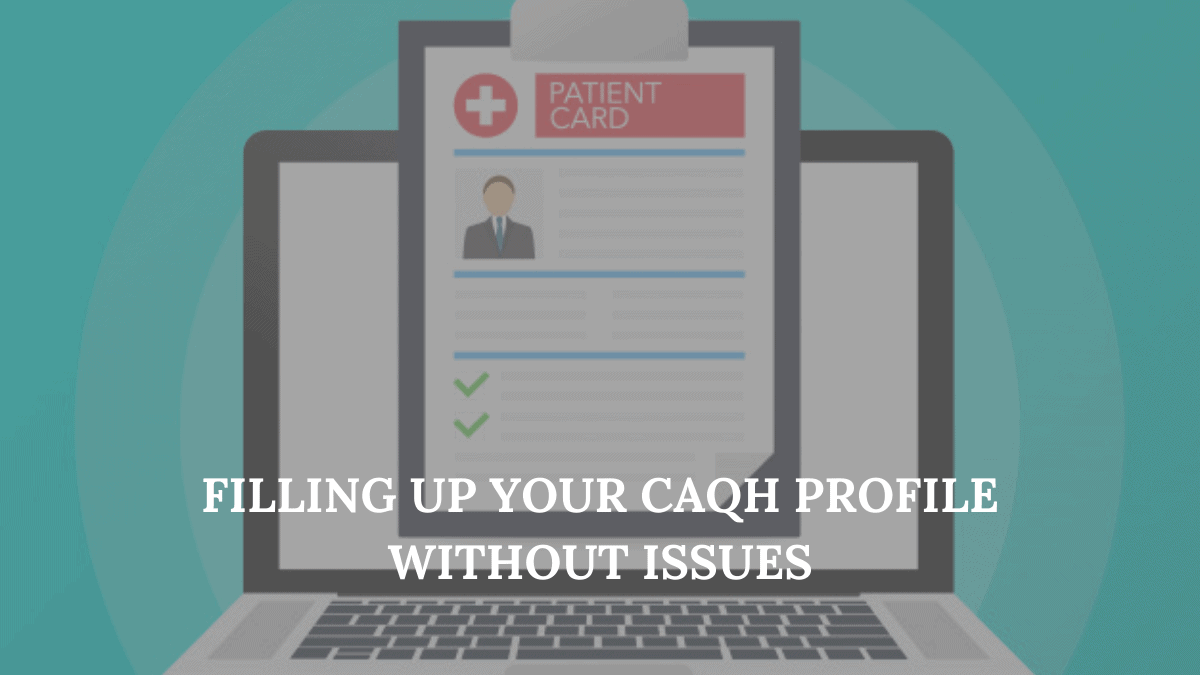
Filling Up Your CAQH Profile without Issues
Getting on insurance panels requires one very crucial step. We are of course talking about CAQH registration. A provider needs to complete his CAQH profile to even entertain the idea of getting onto an insurance panel.
CAQH aka council of affordable quality healthcare is a program that allows insurance companies to use a single application system for all kinds of credentialing. Today, over 900 clinics, health plans and healthcare organization are estimated to be using it. They require a practitioner to complete their CAQH profile by filling up the CAQH attestation form mandatorily in order to submit their application.
The process although very simple in its premise, can be a little confounding for some to follow. That’s why we have decided to guide you through the entire process to avoid any room for doubts, so you can have a hassle free credentialing experience.
1 – Getting a CAQH Number
Many start their credentialing process before even approaching the CAQH profile. Chances are high that your insurance company is already using CAQH. You can check the list of participating organizations on the CAQH website to confirm this. If a particular company is using CAQH, then they send you a CAQH id number, probably in a letter via mail. You should wait for at least 2 weeks to ensure your application is received by the panel. If you still don’t receive it, then it’s time to give your insurance company a call.
Alternatively, you can choose to register yourself on the CAQH website. As such, you will receive your CAQH number via email. Do not lose this number as you will need it throughout the credentialing process. You need it to fill up your application and re-attest your information.
2 – Have all your information ready
The CAQH process is tedious and time consuming. Nobody expects you to finish it in one sitting as it can literally remove hours from your life. One way to speed up the process however is to make sure you have all the information and material you will need for processing ready.
Here’s a list of all the things you’ll need before you start filling up the CAQH attestation form
- • Personal information
- • Education and training information’
- • Practice location information with certification, address, contact detail, practice type etc. mentioned
- • Board certification
- • Disclosure of malpractice history
- • Malpractice insurance information
- • Work history
And the materials you’ll need are as follows
- • Resume
- • State licenses
- • Malpractice insurance policy
- • UPIN, NPI and other ID numbers
- • DEA certificate (if necessary)
- • CDS certificate (if necessary)
Make sure all your information is accurate. Your resume should be formatted with the correct date format, which is MM/YYYY, and there should be no gaps in employment. Failure to abide by any of the above requirements can lead to the rejection of your application. So do not rush into your application. Take your time to make sure everything is in order. Remember, errors can cost you way more time and money. Finally, you need to have scanned copies of all the required material in handy as you will be required to upload it.
3 – Start Working on Your Profile
Once you have all the information you need, it’s time to start completing your CAQH profile. We recommend you only undertake this task online. Doing this physically means tackling a dozen pages long application form that only prints correctly in color and cannot be transferred conveniently without a data entry professional to assist you.
Like we said before, you simply cannot complete the profile in one sitting. So take your time, save your progress and continue later. Once you’ve finished the profile click ‘next’. The website will ask you to verify your information once and ask you to attest whether all the information you provided is accurate.
Once you attest, you will receive a message that your profile is complete. Once you’re done, you have a choice to make. You need to make a decision as to who gets to access your profile, whether you will allow any insurance company that exhibits interest in having you on your panel, or choose manually which insurance company gets to see your profile and which company doesn’t.
In our opinion, the first option is the best as it will open you to more possibilities of being invited on multiple insurance panels. Make sure to never lose your application information as you will be required re-attest to the information once in a while, or on a quarterly basis. Respond to the request to re-attestation quickly as not doing so can result in insurance companies refusing to pay your claims.
Learn More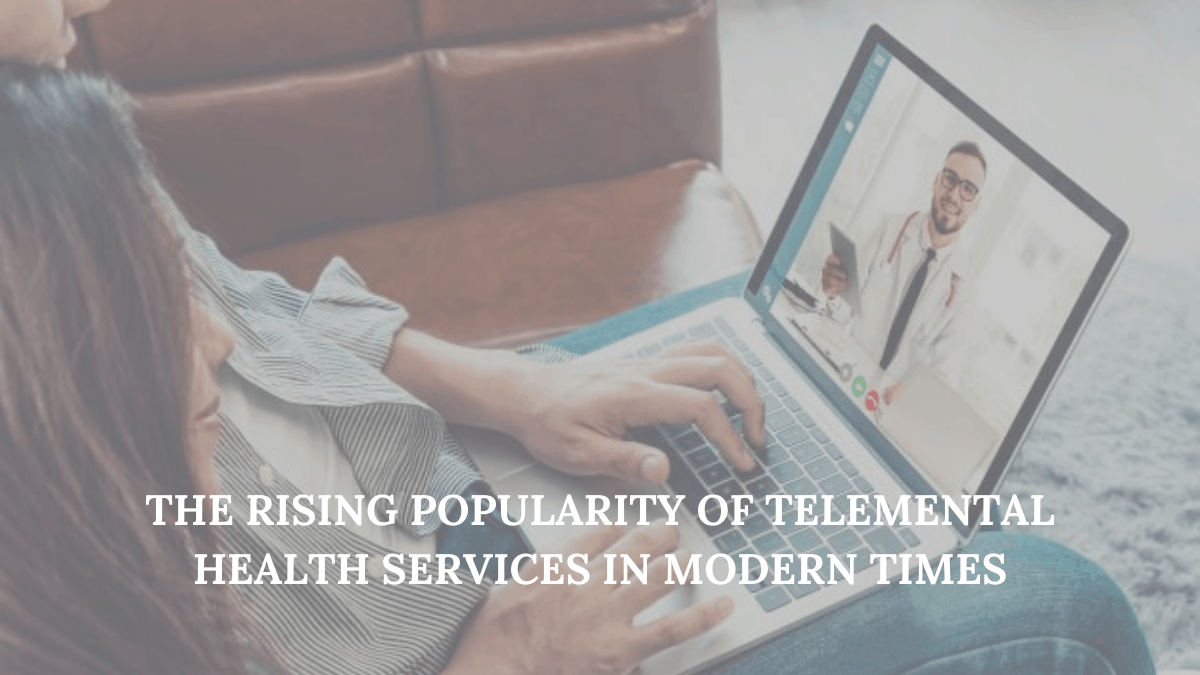
The Rising Popularity of Telemental Health Services in Modern Times
What constitutes the best medical billing software for mental health services? Is it an excellent user interface? Or Is it the ability to perform all tasks like scheduling, appointment booking, tracking payments, and billing automatically? Ask this question to a mental health practitioner, and the answer would be all of the above.
And why not? Why not have software that is not only easy to use but also relieves doctors and practitioners from the hassles of everyday billing and payments.
Keeping this frustration in mind, DENmaar set on a journey to bring the mental health industry a medical billing software that would work to rid mental health practitioners of their payment-related hassles. Our billing software comes with an easy to comprehend user interface that would fit right in with your daily medical choirs.
With a hard-earned reputation, DENmaar specializes in professional and facility billing for insurance claims and patient responsibility. Our clients receive our RCM and Mobile apps to easily create charges, which we later submit to insurance and bill patients. All associated expenses are included when used with our insurance billing services.
DENmaar’s fully automated and highly advanced software was developed to bring our clients the benefits of both professional and institutional billing. State of the art insurance claims processing will keep organizations and providers ahead of the game with automated eligibility verification, claims status updates, claims rejections and denial resolution processes.
Our system also allows for the tracking of your claim status. If due to some unfortunate circumstances, your claim does get rejected and denied, then our experts are at your service to take the necessary actions needed for the approval of your claim.
What makes DENmaar’s Medical Billing Software Special.
Improved Patient Payment System
DENpay is HiPAA compliant and integrates a Virtual Terminal within our RCM to create a conveniently seamless way for patients to make their payments. For providers, it automates the entire payment tracking system and reconciling patient payments. Patients can safely store credit cards and balances automatically billed. Other payment options include emailing a blind statement requesting payment or making a payment with our patient apps. Statements may also be mailed by clicking a button, no printing or stuffing envelopes. How much does this patient payment system cost our clients? $0 It is included as a complimentary feature when using our insurance billing services.
Claim Issues Resolved
Claims which have been denied and rejected are immediately followed up on by DENmaar’s team. We leave no room for such claim issues to occur. Each account has a dedicated Claims Resolution Specialist, a Credentialing Specialist, and an Onboarding Specialist to handle adding insurance panels for billing. That is why DENmaar has a very high first-time claim submission pass through. Payments come in a timely. This allows for cash flows to be maximized, thus making an organization witness its highest revenue generation period.
Staff Claim Tools
All of our software modules, provider and patient apps include Intake and Assessment forms, Telehealth, Electronic Prescription and EMR, Scheduling, Eligibility Verification. Service accounts may use any or all of our features, we provide it as a complimentary product. Our system is cloud based, making transitioning to our platform a breeze.
Choosing DENmaar
DENmaar has been working in the behavioral health industry since 2008 and understands the challenges of a practitioner engaged in within the specialty. Our medical billing software was designed and constructed keeping mental health medical billing in mind. By utilizing our own proprietary RCM system for claims processing we ensure continual advancement in this important financial area. The additional clinical tool for both therapists and medical doctors is a unique feature not typically found in a therapy notes product. We believe we are positioned well now and in the future and would like to take hard working mental health providers with us as we work together to serve the needs of an increasingly needed medical service.
Learn More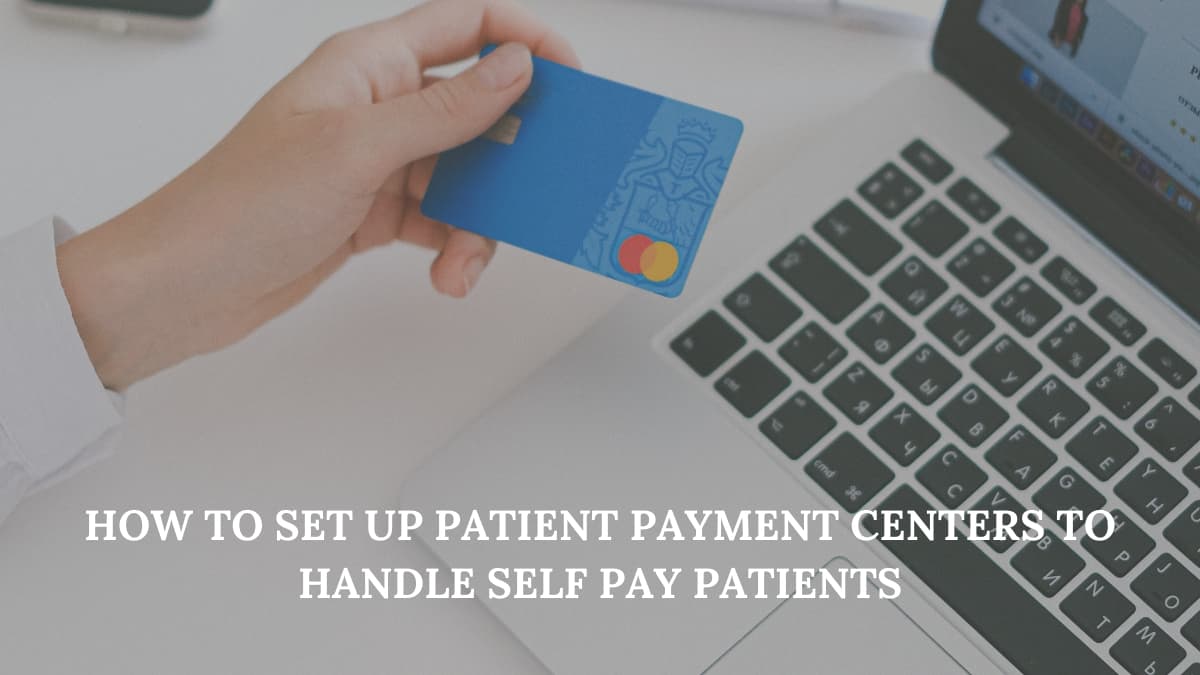
How to Set Up Patient Payment Centers to Handle Self Pay Patients
Even as the Affordable Cares Act gains momentum, many Americans still don’t have access to health insurance. There can be a number of reasons for such a plight. It can be because patients simply cannot afford to purchase health insurance, or they simply fall through the cracks because of residing in states like Florida who didn’t expand on their existing healthcare plan.
As such, self-pay patients are becoming more common. However, many can’t find themselves proper care as practitioners are still reluctant in accepting self-pay patients or don’t have patient payment centers that undertake such practice. So to encourage doctors to accept more patients of such nature, we are going to explore some tips and tricks that can help doctors accept self-pay patients with ease.
But first, let’s understand the reason behind the reluctance of so many doctors in accepting self-pay patients.
The Issues with Self Pay
It is estimated that approximately 81 percent of revenue collected from patients is never really recovered when it is self-paid. Add to this woes, almost 30 percent of patients are said to default on their bills.
Keeping these figures in mind, it is not difficult to understand why doctors are reluctant. Enabling Self-pay sure seems like a recipe for disaster for the functioning of any healthcare organization. However, there are effective ways to ensure there is a perfect patient payment plan in place to avoid the above scenarios of loss.
Establishing an Efficient Policy
Before accepting self-pay patients, it is highly imperative to have some formal payment policies in place. This will protect doctors from losses and payment defaulters. There are 4 factors that must be considered while establishing this policy.
1 – Insurance Co-pays
Set up the office to accept both cash and credit payments, as patients are responsible to fulfill their own co-pays anyways.
2 – Referrals
Referrals are required by insurance companies to recommend patients with specialists they should visit. It forms a big aspect of the primary care providers business.
3 – Payment Responsibility
Providers should set up convenient patient payment centers to allow patients with as much convenience as possible in making payments. Introduce the option of online bill payment to ensure bills are paid on time.
4 – Past Payments
Have a policy to ensure collection of past dues, not a single outstanding payment should be allowed to slip through the cracks.
Creating a formal payment policy will ensure each of these 4 problems are taken care of efficiently. The payment policy should be available on your practice’s website or in print hanging in your practice premises wherever it is visible to your visitors.
Does your Self Pay Patient have hidden healthcare coverage?
Many self-pay patients are opting to pay from their own pockets because they don’t have healthcare coverage. Check their records thoroughly for any past healthcare benefits they can exploit. Also, most self-pay patients do not remain the same as time progresses. They might opt for a health insurance program because they could probably afford healthcare now.
Implement a comprehensive healthcare insurance checklist to ensure a patient isn’t paying more than what he is required to, and that you as a provider are getting paid correctly and on time.
The Bottom Line
As you can tell by now, self-pay patients enjoy a bad reputation in the healthcare industry. However, they are also humans and in need of health care. Care providers can ensure flexible payment options, and clearly communicated payment policies to ensure patients receive the care they need, and providers get paid for the services rendered. Providers can state in their policies that payment is due when services are rendered, thus automatically setting a deadline for payment of dues.
Learn More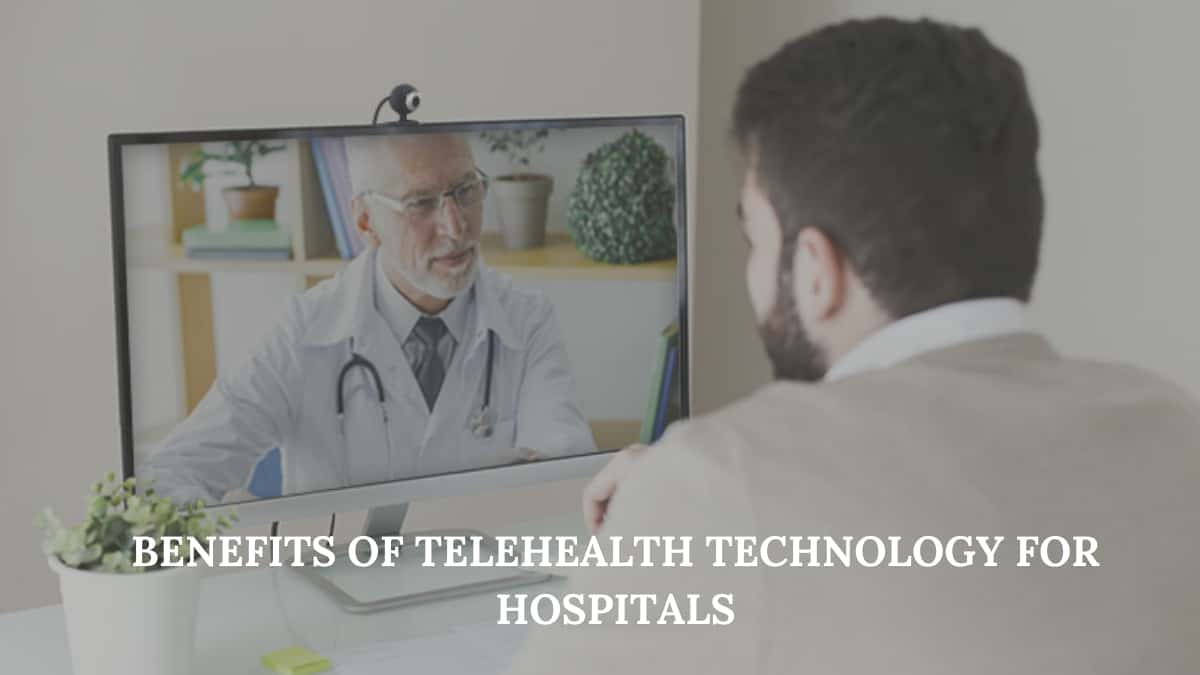
Benefits of Telehealth Technology for Hospitals
We know how important Telehealth technology has been in transforming health care. We know of the benefits it offers to both Patients and Providers alike. Some of which are as follows
- Improved Access to Healthcare
- Cutting Wait Time
- Making Health care affordable
Individuals are already taking full advantage of this revolutionary technology. They have mobile apps installed in their smartphones, and wearables on their wrist or shoulders to track their fitness. We know of the benefits that patients can have with telehealth. However, what are the benefits of telehealth on hospitals, clinics and other healthcare organizations.
In this article, we look at some of the benefits that hospitals and other healthcare organizations can enjoy by using Telehealth technology.
The many uses of Telehealth Technology on Healthcare Institutes and Organizations
Increased Revenue
Access to healthcare, for many American even today, is extremely challenging. Factors like transportation, distance to a nearby clinic etc. all play an important role in being hurdles for the proper access of healthcare. This can be even more inconvenient in cases of senior citizens or people with disabilities.
These individuals can barely make it to a clinic or hospital for proper care. However, with the help of telehealth technology, doctors and other practitioners can still schedule appointment and consult them live via a videoconferencing or live video tool. So, these individuals, who would normally have never become a part of client base, can now become your most valuable clients, thanks to Telehealth.
The same rationale applies to people who don’t have access to healthcare due to them residing in rural or remote regions. They too can be catered to with the help of telehealth technology.
Greater Visibility
It is widely estimated that most people prefer telehealth over physical visits. According to a study done by American Well, it was found that over 65 percent of patients want to see their doctors over video.
The rendering of virtual visits, mHealth apps, and remote patient monitoring solutions, a healthcare organization can attract positive media attention. Positive media attention, then eventually leads to new clients.
Reducing Readmissions
Telehealth technology like RPM solutions can help keep tabs on patients who are considered high-risk. With the help of real-time patient data being provided by this technology, care teams can act immediately before the patient’s condition worsens.
Hospitals are always seeking reduced readmission rates, more satisfied customers and avoiding penalties for subpar healthcare. A robust telehealth technology can help you accomplish that.
Increasing Productivity
Hospitals and Healthcare institutes are busy places. As such doctors and nurses have a lot on their plate, and are constantly on their toes. Telehealth, by imbuing efficiency into the overall functioning of a hospital helps in boosting the productivity of their staff.
Telehealth helps patients schedule their own appointments, which means this burden is alleviated from the shoulders of the staff. Mobile communication also enables staff to collaborate effectively with each other. With so many mundane tasks taken care of, the staff can focus better on their patients.
Better training
The science of medicine undergoes perpetual evolution. As such, people who practice medicine need to be constantly educated and informed of the developments in the world of healthcare. However, this can be very expensive. Some training programs charge exorbitantly high registration fees.
Thankfully, video conferencing technology today can help physicians attend training sessions remotely from the comfort of their own abode, without spending a ton of money. Virtual reality training solutions are also becoming very popular nowadays. They allow physicians to observe recorded surgeries from multiple angles and undergo simulation that offer hands-on experience to learn new techniques and procedures.
DENmaar’s TeleHealth Services
At DENmaar, our telehealth solution offers both patients and providers with a communication technology that allows the access and management of health care services from homes of patients or the practices of doctors. This tele-conferencing feature allows practitioners to attend to their patients, on their computer screens, where-in they can consult and serve their clients without having to make them wait in their clinics or making them transit long distances.
All you have to do to access our feature, whether you are a provider or patient, is to sign up to our app and avail our telepsych feature.
Learn More
The Present and Future of Telehealth Mental Health Care in the Workplace
The ongoing coronavirus crisis has already galvanized people into self-isolation. The isolation has already resulted in great stress among individuals across the US. Over 16 million Americans are estimated to be suffering from some form of depression; this number is likely to go up as the pandemic wreaks havoc on the streets.
As a result, many workers today are relegating to their employer provided mental health plans, widely encouraged by the employers themselves. They have realized the gravity of the disruption caused on their employee’s normal way of life, and how it can lead to unfathomable stress. There has also been a significant increase in the number of therapy sessions.
Telehealth in Workplace
Telehealth Mental health platforms like Ginger have noticed a rise in their user base as well. This shows that employees are now turning to telehealth technology to find reprieve from their mental health problems. Glass – a company that deploys their tool to help users find behavioral health practitioners have reported a 25% increase in their client base. Modern health – a virtual mental health app, on the other hand, has reported a 50 % increase in their user base.
Headspace, a popular meditation app has also found a substantial increase in their users. They say that meditation on their app has become 13 times more often than any previous month. Headspace’s user base is mostly filled with Google and LinkedIn employees. Taking advantage of this opportunity, they have proceeded to create a free content hub to provide guided meditation and mental health exercises as the global lockdown continues.
So as you can see, many telehealth apps are experiencing feats of success that they never dreamed of achieving. Addressing mental health has become a priority amongst businesses, who really want their employees to sail through these troubled seas without any problems whatsoever. Employees too, are relying on the available technology and programs in unprecedented numbers. Although mental health program existed before the pandemic hit, it had never been as popular as it is now.
Many Employers are actively encouraging users to take advantage of the EAP resources at the disposal of their employees. It is in times of such anxiety and uncertainty that behavioral health practitioners like counselors and psychiatrists are needed. However, with social distancing in effect, it is impossible to attend therapy sessions. This is precisely why Telehealth has come out as such a champion.
Employers understand how crucial their staff’s mental health is. In times where conference, meetings and other office practices have halted, mental health care has become a need of the hour for employees to maintain their productivity.
It is estimated that people with mental health issues report 20% drop in their productivity. Companies have no choice but to think about the safety and wellbeing of their employees. Apart from work, the desire for some form of human connection has also lead to such technology gaining momentum, thus helping users connect with their loved ones.
The Future of Telehealth Mental Health Care
Many epidemiologists have delivered warning signs of a yearlong fight with the novel coronavirus. In other words the virus is here to stay. In such a scenario, the work cannot be halted for an extended period of time. People will need to learn how to live with the crisis, and as a result people will need constant counseling. Thankfully, telehealth has never as advanced as it is today. With telehealth, you can rest assured your bread and butter continues while taking care of your mental health. Yes, the virus is here to stay, but so is the omniscient presence of telehealth.
DENmaar’s TeleHealth Services
At DENmaar, our telehealth solution offers both patients and providers with a communication technology that allows the access and management of health care services from homes of patients or the practices of doctors. This tele-conferencing feature allows practitioners to attend to their patients, on their computer screens, where-in they can consult and serve their clients without having to make them wait in their clinics or making them transit long distances.
All you have to do to access our feature, whether you are a provider or patient, is to sign up to our app and avail our telepsych feature.
Learn More
The Popularity of Telehealth in Behavioral Health Care
We’ve come a long way since the early days of telehealth. With constant advancements, innovations, and updates in technology, Telehealth has become relatively potent as opposed to its beginning years. Its relevance has been proven even more fundamental, owing to the current pandemic.
Read More: How to Expand Private Practice Using Telemedicine
Almost all healthcare practices, organizations, and professionals are now implementing technology to not only provide consistent care to their clients but also ensure their practice remains open for business. This is especially true for the behavioral health care sector as well. The implementation of Telehealth in Behavioral health has made mental health care better, more cost-effective, and less stigmatized.
Telehealth’s major selling point has always been its accessibility. It can be a tool that transcends socio-geographical barriers to ensure better care is delivered on time whenever needed. Rural areas have greatly benefited from Telehealth.
How is Telehealth used in Behavioral Health?
Most behavioral health practices are aligned with psychiatry, counseling, and cognitive tests, there is barely any physical involvement in the rendering of behavioral health care. As such Telehealth and behavioral health go hand in hand. Behavioral professionals can still deliver efficient care via a mobile device with the help of telehealth.
Moreover, treating mental health with telehealth is easier, and cheaper as treatment is rendered in a virtual ambiance. There is also a stigma around mental health treatment, which dissuades many individuals from coming forward with their woes. It is estimated that about 42 million Americans have anxiety disorders, and at least 16 million are suffering from some form of depression. Telehealth, by providing a virtual incentive, helps patients get proper mental health care comfortably.
There are multiple research materials claiming that mental health issues come with medical comorbidity. For individuals who deal with multiple conditions like hypertension and depression at the same time, they can get the answers to their queries from a single virtual point, thus allowing for better access to care.
There are other incentives to telehealth as well. Patients no longer have to wait in long lines with patients who might carry contagious flu, which is one of the reasons why telehealth’s stock is up nowadays. There is also no long-distance travel, especially for residents of rural regions. There was a time when rural residents had to traverse on overnight journeys just to see a doctor. Telehealth has changed that.
The adoption of telehealth is already showing results in the behavioral space. According to the popular telehealth service Teladoc’s own research, practitioners have seen an impressive improvement in the mental health of their clients using telehealth. They have reported a 32% reduction in depression symptoms, a 31% reduction in anxiety, and a 20 percent reduction in stress.
DENmaar’s TeleHealth & Medical Billing Services
At DENmaar, our telehealth solution offers both patients and providers with a communication technology that allows the access and management of health care services from homes of patients or the practices of doctors. This teleconferencing feature allows practitioners to attend to their patients, on their computer screens, where-in they can consult and serve their clients without having to make them wait in their clinics or making them transit long distances.
All you have to do to access our feature, whether you are a provider or patient, is to sign up to our app and avail our telepsych feature.
Learn More
Providing Telehealth in Nursing Homes during the COVID-19 Pandemic
So, what are the challenges facing telehealth in nursing homes?
Our older generation is more vulnerable to the novel coronavirus crisis. The stats and figures coming out from many severely affected regions around the planet have made it crystal clear. The symptoms are extremely dire in our elder community. This means nursing homes and other old-age care facilities are also facing significant risks.
Nursing homes are already taking precautionary measures like banning visits, canceling recreational activities, etc. to ensure the elders in their care are safe from this deadly virus. However, this may cause further problems. Isolating the elders from the outside world and canceling their recreational activities can take a heavy toll on their mental health.
Thankfully, psychologists and behavioral practitioners are considered essential workers and can render their services via an array of telehealth technology at their disposal. Medicare and Medicaid services are already allowing psychologists and other behavioral practitioners to use video conferencing tools such as Skype, Zoom, etc. to provide care to our elder community.
Now getting Telehealth to work in such facilities can be extremely challenging. Many clients do not have their own personal devices. Plus, a psychologist also needs to seek cooperation from nursing home staff who are already exhausted due to the ongoing crisis.
There are certain tips and methods that can be employed, to make sure care is provided to the elderly in the confines of their nursing homes or institutes. In this article, we will be exploring some of those tips.
So without much further ado, let’s look at a few tips that can make the Telehealth process run smoothly for nursing home staff and residents alike.
Tips for Smooth Functioning of Telehealth Process
Establish an Onsite Telehealth Liaison
Assign one staff member from the nursing home with the task of setting up and transferring telehealth devices from one client to another. Make him in charge of making sure everybody gets their time on the device. While executing this task, the staff member should ensure that all infection control protocols are being followed diligently.
Contact Staff
Reach out to your point of contact in the Tele-health facility, and collaborate with them to establish a comprehensive telehealth service plan. Check whether the facility has an appropriate device to deploy telehealth services, or whether you would be required to provide it to them. Find out whether they already have a telehealth program being used in association with other medical providers, and ask whether you can jump on-board with them.
Be Flexible with Your Schedule
Practitioners who render telehealth services daily are bound to be exhausted or overburdened by sessions. Conducting sessions across multiple platforms in one day may seem reasonable to neuter the stress of rendering care. Catering to six patients over a period of three hours is more efficient than catering to 10 in an 8-hour shift. This will allow reprieve for both the practitioner as well as the telehealth liaison. So it is wise to consider lesser sessions per site.
Educate the Staff
The nursing staff is present in nursing home facilities to take care of the daily needs of their elderly residents. As such they may not be well versed with understanding mental health needs. So it becomes the responsibility of a practitioner to inform and educate the nurses on the essential nature of mental health care. Explain to them how loneliness, anxiety, fear of the virus can lead to complications of mental health in their residents. Make sure you appreciate them for upholding the fundamental principles of telehealth technology as you need to build an amicable relationship with them. This is all necessary for the telehealth process to work effectively.
Think on Your Feet
We can assume that most residents of nursing homes do not have their own personal devices. This makes rendering of telehealth services all the more challenging. Therefore it is essential for practitioners to think on their feet to ensure these barriers are surpassed without a problem. If the facility you are working with does not possess such technology, then go ahead and provide them one yourself. For residents that do have their own telephonic devices, simply note down their number and connect with them directly via any teleconferencing tool like Skype and Zoom.
Inform the Site about Medicare’s Telemedicine Facility Fee
Medicare administrative personnel have lifted requirements to bill an originating facility fee for conducting telehealth sessions. The facility is now allowed to bill facility fees for the duration of the ongoing public health emergency. So the originating facility is now eligible for payments of originating site facility fee, which is independently billable under Medicare Part B.
The fee can easily cover payment of an hourly rate employee, who can be used to deploy and manage telehealth services in such institutions. Inform the sites of this benefit, and it will make your job of getting telehealth care available in such facilities a tad bit easier.
Funding
You can always consider funding a telehealth program in such facilities by applying for finance for technology and telehealth devices under the CARES ACT. Nursing facilities are already eligible for funding under this act, so why not exploit it for the greater good.
The Future of Telehealth Nursing amidst a Pandemic
As you can see, being more engaging and understanding of the regulations around telehealth in nursing facilities can make the implementation of telehealth easier in LTC sites.
As the crisis reaches its zenith, the need for telehealth only becomes more and more prevalent. We have to assume that the threat of this pandemic won’t be over soon. Therefore reliance on telehealth technology might very well become a norm.
As a psychologist or mental health practitioner, you should do everything in your power to ensure the elderly get the care they need pertaining to mental health. The above tips ensure you do just that.
DENmaar’s TeleHealth Services
At DENmaar, our telehealth solution offers both patients and providers with a communication technology that allows the access and management of health care services from homes of patients or the practices of doctors. This teleconferencing feature allows practitioners to attend to their patients, on their computer screens, where-in they can consult and serve their clients without having to make them wait in their clinics or making them transit long distances.
All you have to do to access our feature, whether you are a provider or patient, is to sign up to our app and avail our telepsych feature.
Learn More
How Conventional is Online Child Therapy
Most folks have a very Hollywood image of what psych therapy or counseling is. They picture adults talking to their psychiatrists while resting on large couches or laid-back comfortably on sofas. However, there is so much more to that concept. Today online therapy has successfully replaced physical consultations, thanks to conferencing via smartphones and computers.
Therapy, however, is equally common if not more frequent with children. Many parents are reasonably cynical about signing up for online child therapy or counseling. They have doubts on what impact it might have on their child.
To clear the air around the topic, we will look at how exactly online child therapy works its pros, cons, and its implications on the future of therapy.
So How Does Online Therapy works
Thanks to the advancements in technology, there are many licensed practitioners and behavioral experts who conduct child therapy online. The process is similar to the treatment they would have received in physical sessions.
These appointments usually take place via video, live chat, phone, or simple messaging. Smartphones, tablets, computers are all effective players in the dissemination of therapy. If there are parents involved, then the therapist may request parental input into the matter affecting their child. Parent-child online therapy sessions may be conducted to find out more about the child’s history or history of the mental illness in the family.
Treatment options are discussed, once a thorough assessment of the child is conducted. Rest assured there is confidentiality between the practitioner and the parents regarding the diagnosis of the child.
The most popular form of Online Therapy
Cognitive-behavioral therapy is one of the most popular therapies provided online today. It helps individual practitioners identify and change destructive thoughts in children. Researches have proven that online sessions are just as effective in conduct as their physical counterparts.
There are many other therapies as well that are equally important but cannot be provided online. Play therapy (Used to express emotions and act out situations) for example, cannot be done without physical presence.
Similarly, Sand tray therapy and other such interactive therapies are better performed in-person rather than online.
The Pros of Online Child therapy
- • Kids can meet their therapists from the comfort of their homes
- • Kids already comfortable with technology will find online therapy no big deal.
- • Appointments can be scheduled more conveniently, according to the convenience of both the therapist as well as the child
- • Online therapy is more accessible, reaching out to rural areas as well
- • Online therapy is cheaper than its counterpart
Cons
- • Technological problems can hinder the delivery of seamless therapy
- • Parents may feel as If they are being left out
- • Online therapy isn’t appropriate for all conditions, Therapies like Play therapy, sand tray etc. can only be delivered with in-person intervention.
- • Online therapists might reject insurance
The Bottom Line
Online therapy provides children with a much more convenient way to communicate with their therapists. Depending on the child age, preferences and needs, a child can be allowed to communicate to his/her therapist in a way that best suits them.
Response to online therapy for children is quite mixed today. While some reports are positive, others claim that their experience was too impersonal. So while some children may struggle, others find it easier to cope with the technology. It depends and varies according to the conditions of the children.
DENmaar’s TeleHealth Services
At DENmaar, our telehealth solution offers both patients and providers with a communication technology that allows the access and management of health care services from homes of patients or the practices of doctors. This teleconferencing feature allows practitioners to attend to their patients, on their computer screens, where-in they can consult and serve their clients without having to make them wait in their clinics or making them transit long distances.
All you have to do to access our feature, whether you are a provider or patient, is to sign up to our app and avail our telepsych feature.
Learn More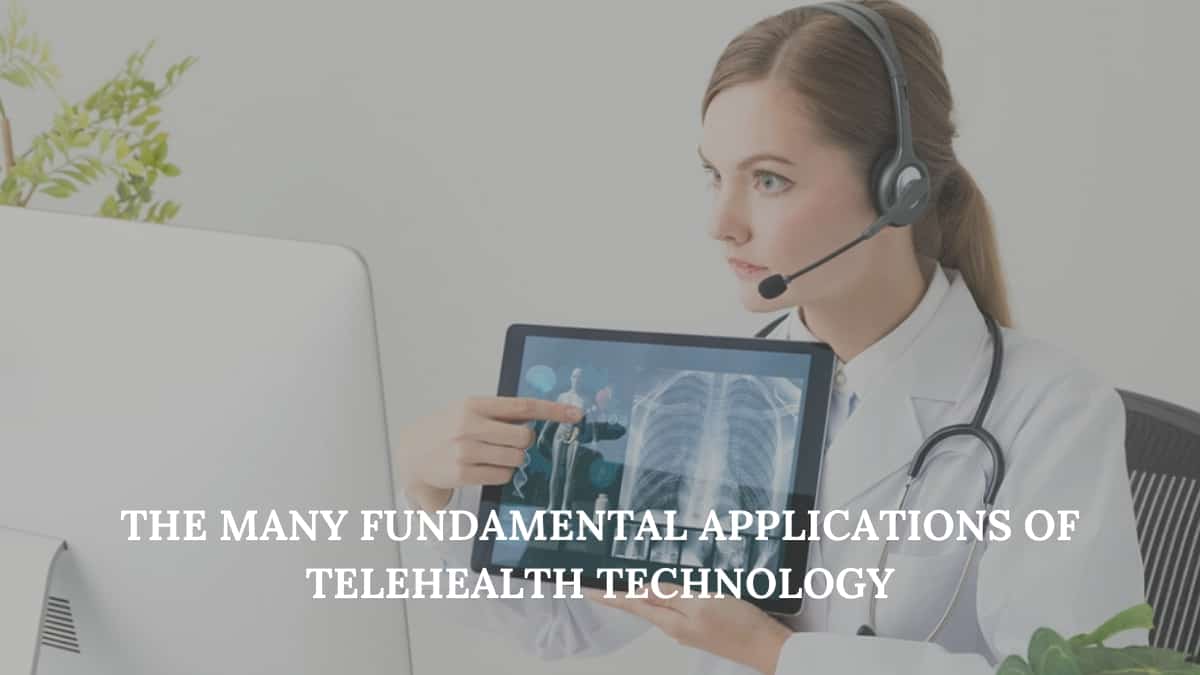
The Many Fundamental Applications of Telehealth Technology
As the world struggles to recover from the tragedy of an ongoing pandemic, Telehealth technology has emerged as a critical messiah that is not only helping save lives but is also determined to save our way of life pertaining to the impending economic crisis.
Telehealth technology has allowed patients to continue availing healthcare, while simultaneously making sure practitioners and their clinics stay operational and financially viable as the world faces an uncertain future in lockdown.
What is Telehealth technology?
Telehealth can very simply be defined as technology that facilitates the delivery of health care, health information and health education via remote technologies like computers or mobile phones. Telehealth provides patients with the tool to consult with their doctors from the comfort of their respective abodes. If recent times are taken into consideration, it allows for face to face communication without compromising on the concept of physical distancing.
The Benefits of Telehealth include:
- • Making Healthcare accessible for rural and isolated communities.
- • Access to behavioral and other medical specialists
- • Making services available for communities and people with limited mobility, or transportation options
- • Improved communication between doctors and patients
- • Improved self-management of health care practice
The below article is focused on how pervasive telehealth technology has become in our healthcare industry. We will be specifically focusing on some of its key applications in terms of providing efficient and adequate care.
So without much further let’s get started.
Telehealth Technology Applications
Today, many technologies are being pumped into the industry with the promise of forever associating telehealth with the service of healthcare. These technologies include mHealth – smartphones and tablets for telehealth, remote patient monitoring, digital photography, audio and video technology, forward and store technology and many more.
Remote Patient Monitoring (RPM)
Remote Patient Monitoring, aka RPM is technology that involves collection, reporting, transmission and evaluation of crucial patient health data via electronic devices. RPM technologies require patients to measure their health data and then transmit it to their physicians for further evaluation. RPM technologies in the form of wearable electronic devices are now being used to collect an array of crucial patient health information like cardiac stats, oxygen levels, and respiratory rates.
(mhealth) Mobile health Telehealth technology
You would be hard strung to find an individual today who does not own and use a smartphone. Smartphones have become tools that have defined human civilization at the turn of the 21st century. Smartphones can now be used for entertainment, calculations, business, education, financial purposes, and so much more.
So it is only fair that it be used to make healthcare convenient. mHealth basically refers to mobile apps and tools that patients use on their smartphones or tablets to avail healthcare. These applications allow users to set medications, appointment reminders and share information with their dedicated practitioners, just like DENmaar’s mental health medical billing application.
Thanks to mHealth, patients can now use asthma or diabetes management tools or talk face to face with their doctors via video conferencing.
Video Conferencing
Perhaps the most relevant, considering the times we are living in; video conferencing has been such a sweet gift of science to mankind. Loved ones can now interact with each other daily and quite conveniently from anywhere around the world, path-breaking trade deals can be closed immediately without any communication barriers, and of course, doctors can advise their patients without making them wait in the clinic or travel long distances.
Real-time video communication platforms are helping doctors and clinicians take better care of their patients without meeting them in-person. This technology has facilitated healthcare for rural inhabitants and soldiers and militants stuck away from civilization.
Store and Forward
Store and forward technology refer to the usage of storage and transmission technology to capture, store and transmit patient health information for asynchronous healthcare delivery. Information like CAT scans, MRI’s, photos, videos, etc. are captured from patients and sent to assigned specialists and practitioners to assist with their healthcare. Technology like secure email platforms, servers, and routers are used to temporarily store this information and send it to the appropriate recipient in time.
Future of Telehealth technology
With many big players jumping in to meddle with this technology, you can bet Telehealth technology will be a key healthcare player in times to come ahead. Big names like Amazon and Wal-Mart have already begun operations on introducing their own version of telehealth technology. We can hope that telehealth technology can work effectively in bringing down healthcare costs and make healthcare more accessible to all.
DENmaar’s TeleHealth Services
At DENmaar, our telehealth solution offers both patients and providers with a communication technology that allows the access and management of health care services from homes of patients or the practices of doctors. This teleconferencing feature allows practitioners to attend to their patients, on their computer screens, where-in they can consult and serve their clients without having to make them wait in their clinics or making them transit long distances.
All you have to do to access our feature, whether you are a provider or patient, is to sign up to our app and avail our telepsych feature.
Learn More
Understanding Autism Spectrum Disorder
It’s the month of April, also widely celebrated a World Autism Month among other events. However, given the severity of this condition, awareness about autism should be pervasive all year-round and not only for a single month. The awareness for autism commands a great amount of empathy from everyone as ASD’s vary among individuals suffering from it.
Certain therapies and treatments can do wonders for some while being completely futile for others. Caregivers like parents and nurses can also harbor different opinions on how to best deal with a condition of ASD.
This article is focused on not only spreading awareness about Autism but also helping parents and other caregivers better manage the conditions in their loved ones.
What is Autism Spectrum Disorder?
Autism Spectrum Disorder, or as it is popularly known as ASD is a complex developmental condition that saddles individuals suffering from it with challenges like inept social interaction, speech problems, non-verbal communication, and repetitive behaviors. The severity of ASD’s varying from person to person.
ASD is quite frequently first diagnosed in childhood, with signs first becoming noticeable around 2-3 years of age. Some children with autism may develop normally before ultimately losing all their previously gained skills.
The CDC estimates that at least one in 59 children have autism. It is also more common in boys than in girls, and the girls who do have ASD exhibit less obvious signs than boys. Although ASD is a permanent condition, many children who are diagnosed with the condition go on to live normal and independent lives.
The Characteristic of People suffering from ASD
Like we said, no two people will show the same behavioral signs when dealing with autism. Symptoms can mild or severe and change as time passes by. Some of the common characteristics are as follows:
Social and Communication Problems
This includes exhibiting difficulty in having a straight forward normal conversation, not showing interest, or sharing emotions. Issues in trying to understand social cues like eye contact or facial expressions.
Difficulty in Empathizing with People, things and events
Trouble in making friends, interacting with people and not making eye contact
Repetitive behaviors
This can include a number of things, mainly pertaining to hand flapping, flipping objects, lining up toys, speaking in gibberish or atypical manner, exhibiting interest in unusual activities, toe walking, etc.
It is important to note, that while many children with ASD have normal intelligence, some have very mild and significant intellectual delays.
Diagnosis
Early diagnosis of ASD is crucial in parents and caregivers being able to manage this condition. It is the only way by which a child’s symptoms can be reduced and his life ultimately improved. Like we said there is no definitive cure-all for autism spectrum disorder. It is mainly diagnosed by the obstinate observance of the child’s behavior like he talks and interacts with other children his age.
Trained practitioners can easily diagnose the condition by talking to the child and enquiring with his/her parents and caregivers. It is in compliance with federal law that any child suspected of having any kind of developmental disorder should be given a free evaluation. It is highly recommended that the child undergo all sorts of screening procedures to identify developmental disorders, if any, by age three.
If you have doubts about whether or not your child is developing properly, then bring it to the attention of your practitioner immediately. Every second is precious in handling the condition of autism wisely.
The CDC (Center for Disease Control and Prevention) identifies the following red flags as possible signs of ASD:
- • Not responding to his/her name by 12 months of age
- • Not pointing out to objects to display interest by 14 months of age
- • Getting upset very easily
- • Spinning in circles, flapping their hands incessantly
- • Having unusual and intense reactions to sight, smell, taste and feel
- • Avoiding eye contact
- • Preferring loneliness
- • Not playing ‘pretend’
As of now, no expert has clear answers on what actually causes autism. It can be due to genes, or the condition and environment in which a child is born and raised. A child is also at a greater risk of having autism, if there is a close family member who is already suffering from the condition.
How Autism is Treated
As of now there is really no cure for the condition of Autism. However, there are many therapies and treatments that can help people alleviate their symptoms and feel much better.
Some of those treatments are listed below
- • Behavioral Therapy
- • Play therapy
- • Occupational therapy
- • Speech therapy
- • Physical therapy
Alternative Treatments
Many alternative treatments are also in effect today, some of them include the following:
- • High dose Vitamins
- • Hyperbaric oxygen therapy
- • Melatonin to handle sleep issues
The research on these treatments is mixed, and results may vary from person to person. It is highly advisable to weigh the research and financial costs of such treatments before considering them for you or your loved ones.
Tips for Parents and Caregivers
Parents can really help their child overcome the problems posed by ASD by following the below simple tips:
- • Learn and be well informed about Autism Spectrum Disorder
- • Provide consistent structure and routine
- • Seek professional help
- • Build a rapport with other parents who are raising children with autism
- • Take your time and be patient while dealing with your child
DENmaar Partners with Autism Lizard to Offer Efficient Autism Management Program
A child with autism can be extremely stressful for the entire family. Handling it can be a headache, very time consuming and break your savings. DENmaar knows how important it is to take into account the emotional and physical health of the entire family, and thus have partnered with premier behavioral training service providers who offer legit, tried and tested autism solution for your family at an affordable price. DENmaar clients and subscribers can now avail tempting discounts for Autism lizards Family Autism Independence System program. Offer is available for a limited time only, so HURRY!!
Learn More
The Major Difference between Telehealth and Telemedicine
At first glance, both telehealth and telemedicine seem very similar terms, that however, cannot be any further from the truth. Today the fields of Mobile IT health, digital health and telemedicine are changing so rapidly, that it is hard to settle on one accurate definition for these terms, hence you will see both Telemedicine and Telehealth being used interchangeably.
Both terms consist of very similar services which include patient monitoring, e-health, medical education, patient consultation etc. If you really want to get to technical with the terms then Telemedicine is a subset of Telehealth.
Telehealth, on the other hand is much broader term in scope which includes all telecommunication services that offer or engage in health care. Telemedicine refers only to clinical services.
Here’s a definition that could clear your mind on the concept:
Telemedicine refers to traditional clinical diagnosis and screening provided by technology, whereas Telehealth encompasses many different types of diagnosis, management and education. Telehealth concerns itself with many different range of telemedicine services which include both clinical and non-clinical services.
Telehealth being the more popular term can be found in general health care services, while Telemedicine deals specifically with a clinician that provides a very specific kind of health service.
Examples of Telehealth
- A video conferencing platform for consultation and education
- A health app that alerts people of impending outbreak
- Fit Bits that monitor your pulse and heart rate
Example of Telemedicine
- An app that helps physicians treat their patients remotely via video conferencing
- A software that allows patients to send photos of a rash or a mole that has been bothering them to their doctors.
- An app that schedules appointments with doctors within minutes.
As you can see Telemedicine is simply a small part of telehealth. Telemedicine has become even more popular and is being widely consumed thanks to the recent COVID-19 outbreak. If anything, it has proved its worth in times of emergency and will gain further validity once the pandemic is defeated.
DENmaar’sTeleHealth Services
At DENmaar, our telehealth solution offers both patients and providers with a communication technology that allows the access and management of health care services from homes of patients or the practices of doctors. This tele-conferencing feature allows practitioners to attend to their patients, on their computer screens, where-in they can consult and serve their clients without having to make them wait in their clinics or making them transit long distances.
All you have to do to access our feature, whether you are a provider or patient, is to sign up to our app and avail our telepsych feature.
Learn More
Pros and Cons of Tele-Nursing
We all want our healthcare to be both effective in its treatment and affordable in its cost. When telehealth is implemented efficiently, both of the above aspects become easier to achieve. We can see improvements in patient satisfaction as well as management of healthcare amidst your own organization.
An advance in communication technology is only making things better for the telehealth industry. Smartphones today are faster and actually smart. Stronger internet connections are ensuring care is rendered uninterrupted. Today, telehealth is so much more than simply calling up your nurse to explain your symptoms.
In this article, we will look at Tele-nursing, its pros, and its cons. So without much further ado, let’s jump right into the meat of this article.
Pros and Cons of Tele-Nursing
Better management of Chronic Conditions
RPM aka Remote patient monitoring has replaced traditional clinical visits today to manage chronic conditions like diabetes and COPD. In RPM there’s less fragmentation of care when a patient lapses with their responsibilities. With fewer contact, there are less clinical visits and readmissions. In one study, participants of the ‘behavioral health intervention telehealth program’ experienced less hospital admissions than the patients who did not participate.
Increased Access to Care
Patients who live in rural areas are the most significant beneficiaries of telehealth. Rural areas have always received the harsh end of a stick when it came to accessing to health care. Tele-health changed all of that. Now, rural areas, thanks to the strong internet connection and better smartphones have access to healthcare.
Avoid Risk
In the context of the recent COVID-19 outbreak, Telehealth provides a great opportunity for doctors to still consult their patients via videoconferencing while adhering to the mandatory discipline of social distancing.
Save Time
With telehealth, patients don’t have to travel long distances to meet their doctors. They don’t have to wait in long lines as well. Tele-health saves time which is precious to both doctors and patients.
Cons
Some Visits are Necessary
Although telehealth is crucial in providing convenient health care to patients, it still cannot make up for physical consultation which is necessary for most situations. Doctors cannot feel your stomach through telehealth, they cannot swab your throat, or listen discerningly to your lungs or heartbeat.
Licensing issues
Licensing issues restrict nurses from providing health care to patients that do not fall in their state. Nurses can only practice and provide care in the states that permit them to practice health care.
Reimbursement
Insurance coverage for telehealth services is still shoddy and needs a lot of work. Only 21 states today require private insurers to cover telehealth services. Medicaid programs vary from state to state in paying for services offered by nurses through telehealth.
DENmaar’s TeleHealth Services
At DENmaar, our telehealth solution offers both patients and providers with a communication technology that allows the access and management of health care services from homes of patients or the practices of doctors. This teleconferencing feature allows practitioners to attend to their patients, on their computer screens, where-in they can consult and serve their clients without having to make them wait in their clinics or making them transit long distances.
Learn More
Cigna Embraces Telehealth Technology
Cigna has finally launched its own Telehealth services to offer its 12 million members access to primary health care services. The insurer has partnered with Florida based Telehealth service provider MDlIVE to bring its services to their insurers.
This isn’t the first time MDlIVE has partnered with an insurance company, Humana and Blue Cross Blue Shield, came before Cigna. They have however, partnered with Cigna before to provide urgent care through their Telehealth services.
The move has pushed Cigna into a newly popular arena of advanced healthcare technology. Amazon and Walmart are also rumored to be bringing in their own telehealth services in the market. The telehealth service means to improve access to rural areas for better healthcare, and provide specialty care without any hassle. If recent stats are anything to go by, then the younger generation are already ignoring traditional methods of physical consultations and opting for such online services instead.
What is Telehealth technology?
Telehealth provides patients with the tool to consult with their doctors from the comfort of their respective abodes. It allows for face to face communication without compromising on the concept of physical distancing. Videoconferencing, Fit bits, Apple watches are all examples of telehealth technology
The Benefits of Telehealth include:
- • Making Healthcare accessible for rural and isolated communities.
- • Access to behavioral and other medical specialists
- • Making services available for communities and people with limited mobility, or transportation options
- • Improved communication between doctors and patients
- • Improved self-management of health care practice
For many traditional health care professionals, Tele-health is still an uncharted territory. Venturing into something this unknown to them can seem intimidating. However, most Tele Health services today are easy to use and can be implemented with only minor level training.
DENmaar’s TeleHealth Services
At DENmaar, our telehealth solution offers both patients and providers with a communication technology that allows the access and management of health care services from homes of patients or the practices of doctors. This tele-conferencing feature allows practitioners to attend to their patients, on their computer screens, where-in they can consult and serve their clients without having to make them wait in their clinics or making them transit long distances.
All you have to do to access our feature, whether you are a provider or patient, is to sign up to our app and avail our telepsych feature.
Learn More
How Telehealth Technology is Transforming Modern Healthcare
Most people are not even aware, but Telehealth technology has been around since the 1980’s. Yes! That’s how old the technology is. Since then Telehealth has grown to become a revolutionary tech that can convey medical information throughout the globe in real-time. Medical professionals can now provide services to individuals and areas that previously had no access to health care.
Now that the entire world is reeling in the face of an unexpected pandemic outbreak, Telehealth has become more important than ever. It has already proven its mettle in saving countless lives by making individuals abode by the golden rules of social distancing that our current situation demands.
In this article, we will be looking at the 5 ways in which Telehealth technology is transforming modern healthcare.
So without much further ado, let’s get started
Spreading Expertise in All Areas
Telehealth has graced rural areas with its presence. These areas have suffered a lot due to inadequate health care. Usually, these areas have their own community doctor to take care of an entire community. However, he might not have the expertise to deal with all kinds of medical conditions. Telehealth act as a convenient assisting tool in this regard.
Let’s say a community doctor is dealing with a patient with stroke, with very little expertise in the field. With the help of Telehealth, he can consult an expert over video calls and take better care of the patient suffering from a stroke.
Helping People with Limited Access to Care
A majority of the world we inhabit still lives in conditions of great suffering and lack the basic privilege of proper healthcare. Before telehealth, deaths and aggravated medical conditions were typical in rural and underdeveloped regions of our planet due to the absence of expert medical personnel. Thanks to telehealth, there is no excuse anymore for healthcare professionals to transmit care over the internet, which can lead to many lives being saved.
It is Inexpensive
With telehealth, patients are rewarded with the benefit of affordable healthcare. Telehealth technology like Fit bit and Apple watches are now relatively affordable and can provide great health benefits to users. Insurance companies along with Medicare and Medicaid are also now reimbursing the use of telehealth, which has made Telehealth more trustworthy amongst insured individuals.
Pervasive Adoption
With the current pandemic, telehealth is likely to be adopted by all forms of healthcare channels, making it even more popular than it was before. Remote home care will quickly replace long wait times at clinics. More telehealth treatment options will be reimbursed by our healthcare system.
DENmaar’s TeleHealth Services
At DENmaar, our telehealth solution offers both patients and providers with a communication technology that allows the access and management of health care services from homes of patients or the practices of doctors. This tele-conferencing feature allows practitioners to attend to their patients, on their computer screens, where-in they can consult and serve their clients without having to make them wait in their clinics or making them transit long distances.
All you have to do to access our feature, whether you are a provider or patient, is to sign up to our app and avail our telepsych feature.
Learn More
The Fundamentals of Telehealth for COVID-19
The recent novel coronavirus outbreak has cemented the fundamental nature of Telehealth in our health care system. It has quickly proven to be a lifesaving innovation in health care technology and many providers are making sure they facilitate their patients with TeleHealth services for continued, safe provision of health care.
The federal government has already expanded on the concept of TeleHealth services, deeming it to be the perfect tool in the face of COVID – 19. Tele-Health succeeds in the practice of healthcare provision by implementing the principals of social distancing and isolation, both of which are important to decimate the super contagious virus.
Telehealth provides patients with the tool to consult with their doctors from the comfort of their respective abodes. It allows for face to face communication without compromising on the concept of physical distancing.
Apart from social distancing, TELEHEALTH also offers the following benefits to both providers and patients.
The Benefits of Telehealth include:
- • Making Healthcare accessible for rural and isolated communities.
- • Access to behavioral and other medical specialists
- • Making services available for communities and people with limited mobility, or transportation options
- • Improved communication between doctors and patients
- • Improved self-management of health care practice
For many traditional health care professionals, Telehealth is still uncharted territory. Venturing into something this unknown to them can seem intimidating. However, most TeleHealth services today are easy to use and can be implemented with only minor level training.
As of now, there are no legal certifications required by practitioners to provide TeleHealth services to their clients. However, there are many professional behavioral health associations that demand some level of competence in the part of providers to better implement the new service.
As some states are relaxing licensing requirements, that is not the case with all states. Be sure to check with your local licensing boards on the formalities and rules that apply to your practice. Make sure that telehealth and cross-state services are covered under your policy before rendering the service.
DENmaar’s TeleHealth Services
At DENmaar, our telehealth solution offers both patients and providers with a communication technology that allows the access and management of health care services from homes of patients or the practices of doctors. This teleconferencing feature allows practitioners to attend to their patients, on their computer screens, where-in they can consult and serve their clients without having to make them wait in their clinics or making them transit long distances.
All you have to do to access our feature, whether you are a provider or patient, is to sign up to our app and avail our telepsych feature.
Telehealth for Patients
Our telehealth feature offers patients with the following benefits
- • Easy communication with doctors and nurses online
- • Prescription refill requests
- • Schedule appointments
- • Review Test Results
Telehealth for Providers
- • Counseling Patients Online
- • Provide healthcare advice and services in remote and rural areas
- • Schedule appointment or post-appointment reminders
- • Review and deliver test results

Understanding Claim Denial and Claim Rejection – They are Not the Same!
At first glance, both claim denial and claim rejection can seem the same exact thing. Many practitioners use the term interchangeably. We are here to tell you how to grave a mistake that can be. This ostensibly simple misunderstanding can be detrimental to your practice and push your revenue cycle into disarray. It is extremely imperative to understand the differences between these two terms if you are to stabilize your practices cash flows.
The Difference
Claim Denial
Claim denial can be defined as claims that were received and processed by the insurance companies, but a negative determination was made. You simply cannot resubmit such claims; they need to be researched to understand why this particular claim was denied and then write an appropriate appeal for its resubmission. If this claim is resubmitted without an appeal, then the chances are that it will be rejected as a duplicate, thus costing you more time and money.
Claim rejection
Claim rejection is altogether a different concept. These are claims that do not meet specific data requirements or are formatted inappropriately, which ultimately resulted in their rejection. These medical claims cannot be processed as they were never received by the insurance companies and entered into their computer database. This type of claims can be easily resubmitted if the errors are rectified. The errors can be as simple as a missing alphabet in the name or a transposed digit from the patient’s user I.D
The Reason for Denial and Rejection of Claims
There are 5 major reasons for medical claim rejections, and they are as follows:
- • Missing information, for e.g. missing address, pin code or phone number.
- • Duplicate claim for service – claims that were mistakenly submitted more than once
- • Service is already adjudicated
- • Service is not covered by the payer
- • The limit for filing has expired
Improving claim rejection and denial rates
Whether you are someone who has a dedicated in-house staff, or outsourced coding and billing to a third-party service provider, you need to follow some crucial steps to ensure your claims aren’t rejected or denied.
- • Track and analyze patterns in payer denial and rejections. Once you have categorized these denials and rejections, you can devise a strategy to cut their rates.
- • Train your billing staff on how to handle claim denials appropriately.
- • Schedule routine audits to identify problems before claims are sent to the payer.
- • Work with payers to avoid denials by discussing, revising and eliminating contract requirements.
- • Use billing software or hire a vendor to take care of claim denial and rejections efficiently.
The Bottom Line
Claim denials and rejections are some of the most prevalent challenges that practitioners face today. A lot of care needs to be taken to avoid denial and rejections. Thankfully, we at Denmaar are here to clear the air surrounding medical billing and help you submit strong claims that have very low chances of denial and rejection.
Here at Denmaar, we partner with concerned practitioners to offer pre-authorization, third party billing, claims follow-up, and to assist with appeals for any denied insurance claims. With Denmaar, you get the assistance of our behavioural health billing specialists to make your billing process easier than ever.
Learn More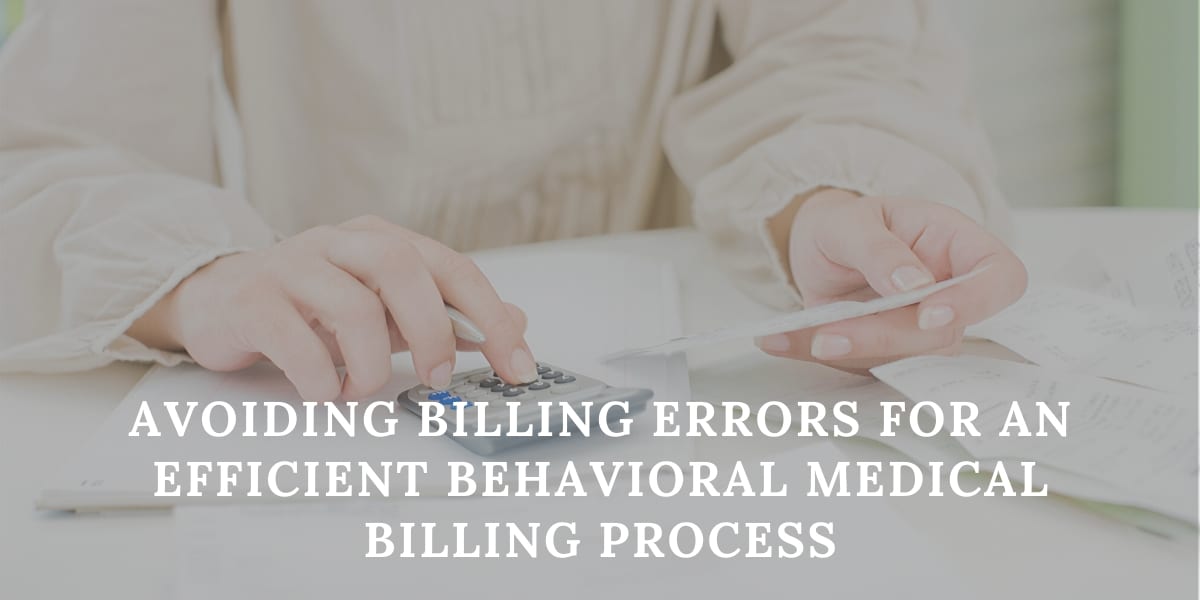
Avoiding Billing Errors for an Efficient Behavioral Medical Billing Process
Medical billing can be a crucial, but complicated process. It constitutes one of the most vital components of the health care industry, especially the behavioral healthcare sector. What makes the behavioral medical billing process concerning is the frequent billing errors that are pervasive throughout the industry.
Errors in coding are frequent sights to witness, especially when it comes to behavioral health, as such the diagnosis, treatment and coverage for a patient can be extremely messy. This, in turn, makes the claim submission process messy, resulting in most cases with denial of the claim.
Prominent Billing Errors
If we have any chance of combatting the issue of billing, we must first try to understand its cause. Some of the most common errors are listed below.
Clerical Errors
Errors such as incorrect spellings, typos in insurance ID’s are a major reason for insurance firms denying claims. The name, contact, and address of both the provider and insurance company could be entered incorrectly. This is because the medical bills can be influenced and changed by dozens of people, hence such errors are common
Outdated Information
Apart from incorrect information, outdated or obsolete information can also put a wrench in your claim approval ambitions. Outdated information may come from the patient themselves. Claims can be rejected if data is found to be outdated; hence keeping data up-to-date is crucial.
Incorrect Quantities
An incorrectly entered quantity can end up charging the patient extra. Even erroneously adding a zero at the end of a number might widely exaggerate the cost of the treatment. Such errors should be avoided at all costs.
Messy Documentation
Most physicians have illegible handwriting. At this point, this has developed into a cliché amongst various medical professionals. However, this can also result in claim rejections as the handwritten documents are simply too messy to be comprehensive.
Double Billing
Double billing, unfortunately, is a common Behavioral medical billing mistake that has been going on since time immemorial. A patient might be charged twice, once by the doctor and once by a nurse who wasn’t aware of the doctor’s actions. A patient might also be charged twice for both drugs prescribed and drugs administered.
Undercoding
Undercoding occurs when the act of behavioral medical billing for a service is less expensive than the treatment provided, or leaving out codes altogether. Patients might be undercoded by providers to minimize patient’s costs or avoid any audits. Unlike other errors, this error affects the provider more than the patients.
Upcoding
Upcoding occurs when the act of billing for a service is more expensive than the treatment provided. This happens when a billing code is incorrectly changed to represent a more severe treatment or diagnosis. Upcoding has been deemed illegal and can also inflate a medical bill.
Incorrect or Mismatched Codes
Incorrect or mismatched codes can occur when a provider upcodes a patient’s diagnosis without changing his billing code. Mismatched codes can also inflate claims due to upcoding.
Unbundling
Unbundling is an act of billing for individual services that can be covered under a less expensive treatment plan. This basically means that charges which were typically falling under one code are now being listed separately.
Best Practices to Avoid Billing Errors
With the above causes now crystal clear, let’s look at some of the best practices that can help you avoid billing errors, and thus prevent claim rejections.
- • Double Check Patient’s Personal Information
This is probably one of the easiest ways to avoid medical billing errors-simply verify and re-verify your patient’s personal information. Make sure all the information submitted by them is correct and devoid of any silly mistakes and omissions. - • Double Check Patient’s Insurance Information
Make sure to call your patient’s insurance company before you provide them with your services. Check whether their policy number and coverage are the same and that you have updated billing contact information. - • Establish a policy to compile billing information
Establish a clear and precise policy that communicates accurately how billing information needs to be handled and managed by your staff. You have to ensure your patients aren’t being charged twice, hence make one person-in-charge of monitoring and managing the staff that handles billing. - • Follow up on your claims
You can avoid errors by simply being diligent in your follow-ups with insurance companies. A representative working on your claim might be able to inform you of errors, allowing you to rectify and re-submit a polished claim again. - • Establish Clear Communication and Co-ordination
Everyone working on a claim in your staff should be well aware of their roles and responsibilities. They should also be well organized and coordinated to know how to communicate with each other effectively. Stay up-to-date It is crucial that you stay up-to-date with your claim process and avoid the entry of any kind of obsolete information from your documentation.
DENmaar’s Mental Health Medical Billing Service
As you can guess from the article, behavioral health medical billing is not a walk in the park. A lot of effort, blood, and sweat goes into the entire process. It can be time-consuming and really frustrating for mental health practitioners who just want to tend to their client’s needs.
Here at DENmaar, we partner with concerned practitioners to offer pre-authorization, third party billing, claims follow-up, and to assist with appeals for any denied insurance claims. With DENmaar, you get the assistance of our behavioral health billing specialists to make your billing process easier than ever.
Learn More
Behavioral Medical Billing VS Conventional Medical Billing
Behavioral medical billing is one thing that mental health practitioners simply wish to do away with. It is a special kind of frustration that is conjured when you try to file insurance claims for mental and behavioral health benefits.
Due to the types of services offered, or the pre-authorization needed, the challenges that mental health practitioners face are unlike any their contemporaries have to deal with.
What Makes Mental Health Billing so Complicated?
Lack of a standardized process as compared to other practices would be a simple answer to this question. In a Behavioral health practice, there are a number of variants when it comes to types of services offered. Major time in behavioral healthcare is spent on therapy sessions. Insurance companies take note of how long the duration of these treatments can go for, as well as how many of these sessions can take place in a day. Both counselors and psychiatrists simply have a very different way of dispensing their services.
These make it very difficult for them to balance their treatments with an adequate billing system. Another area that clearly distinguishes mental health billing from other conventional billing plans is the fact that the problems with behavioral medical billing are only amplified by office budgets.
Counselors will often try to process their own bills, to cut down on operation costs for their private practices. The lack of dedicated staff to update billing codes for behavioral health, changing regulations, and billing practices for each of the respective insurance companies, will result in rejection rates skyrocketing.
If you want to process your claims quicker, then the following can help:
File within the time allotted by the insurance company
Use only the billing format required by your client’s insurance company
Use the appropriate code for the delivered treatment
Limit the bill’s total to the fee allowed by your client’s insurance policy
Use the appropriate policy number for the bill claim
Submit the claim to the right address
Receive pre-approval for treatment as needed by the insurance plan
On average, only 85 percent of claims for behavioral healthcare is approved. Improving these approval rates is the biggest challenge facing behavioral healthcare providers today.
Make it a habit to double-check your client’s insurance plan before each and every visit. Sudden policy changes and lapses in coverage are common in the world of health insurance. Try to stay ahead of the game for your own benefit.
Be up-to-date on each of your client’s insurance company filing methods. Paper and fax have become a thing of the past, and are now being replaced by email, and online filing services. Stay in touch with the insurance companies, as you don’t know when they will change their billing method.
DENmaar’s Behavioral Health Medical Billing Services.
As you can guess from the article, medical billing for mental health is not a walk in the park. A lot of effort, blood, and sweat goes into the entire process. It can be time-consuming and really frustrating for mental health practitioners who just want to tend to their client’s needs.
Here at DENmaar, we partner with concerned practitioners to offer pre-authorization, third party billing, claims follow-up, and to assist with appeals for any denied insurance claims. With DENmaar, you get the assistance of our behavioral medical billing consultants to make your billing process easier than ever.
Learn More
Guidelines for a Convenient Behavioral Health Medical Billing Process
Medical billing on its own is a seriously complicated process. However, medical billing for mental health is a whole new level of the headache-inducing choir. It comes with its own set of unique and complex challenges. When you take into consideration the size and time availability of office staff, unbundling concerns, pre-authorization, etc., behavioral health practitioners are always at a disadvantage compared to their contemporaries in other fields
Understanding the process of behavioral health medical billing is the only way for mental health practitioners to achieve salvation. As then and only then can practitioners spend more time and money on something that matters to them beyond everything else – their patients.
Having emphasized the importance of comprehending the process, we at DENmaar have designed an intricate and precise behavioral health billing software that aims to lift the unnecessary weight of medical billing off your shoulders, thus allowing you to focus on what you are good at, which is tending to your patients.
What Makes Medical Billing for Mental Health So Difficult
The variety in the types of services, the time, scope, and restraints put on mental health treatments, all of them work in conjunction to make the medical billing very difficult. For practices other than mental health, the process is easily standardized; hence the medical billing process remains fairly easier to understand and implement.
However, the very volatile and diverse nature of behavioral health treatment doesn’t allow the luxury of convenient medical billing to those who practice it. Behavioral health treatment differs vastly. The session length, the therapeutic approach, the location in which services are rendered – all contribute to the complex nature of behavioral health medical billing.
Behavioral Health Billing Guidelines
So how can you, as a Mental and behavioral health practitioner, combat the tedious nature of medical billing? Read on for the answer.
1. Double Check Each Patient’s Insurance and Coverage
The very first thing you need to do as a responsible mental health practitioner is to learn about each of your patient’s insurance plans and coverages before each visit. Although this may sound like a time-consuming choir, knowing each and every patient’s insurance plan will reap greater returns in the end.
You can check all of your prospective client’s coverages by conducting verification of benefits for each of your patients before you begin treatment or serving the client in any manner.
Verification of benefits allows providers to unearth important information that is not available in the patient’s insurance card. By checking the VOB, you can rest assured knowing that they are insured for the services they are getting from you and will know how much the insurance company is willing to pay for the services of a client.
Many insurance companies provide online provider portals that can be used to perform verification of benefits by the provider. If a portal is not available, then you can directly call the insurance company to gather the needed information.
To conclude, it is very important to know the coverage and insurance plan of all of your patients, so you don’t end up with rejected claims and unpaid bills.
2. Understand CPT Codes
CPT or ‘common procedural technology’ are codes used by insurance providers to determine the amount of reimbursement to be delivered to healthcare facilities. When dealing with billing, it is imperative to know the associated behavioral health codes for billing. It is extremely crucial to understand the services your facility offers and its respective CPT codes.
Some mental health practitioners use the same CPT codes for all their services. This is illegal, and we recommend our clients never to do such a thing. There are two types of CPT codes available for behavioral health practitioners – E/M Codes and Psychiatric Evaluation Codes
E/M Codes are used to evaluate new medical issues and must have three documentation elements provided. They are:
- History
- Medical Examination
- Medical Decision Making
On the other hand, Psychiatric Evaluation Codes are used for diagnostic assessment. It can include E/M services, but the time associated with E/M services is not counted.
3. Submit Claims Properly
For you to get reimbursed for a claim without a hassle, not only do you need to file the correct code in reference to the correct insurer, but also submit the claim in the correct billing format. Make sure that you are well aware of the insurance companies filing method, and that you do file within the time allotted to you by the insurance company.
Learn More: How to Handle Claim Denials & Maximize Reimbursements
DENmaar’s Mental Health Medical Billing Service
As you can guess from the article, medical billing for mental health is not a walk in the park. A lot of effort, blood, and sweat goes into the entire process. It can be time-consuming and really frustrating for mental health practitioners who just want to tend to their client’s needs.
Here at DENmaar, we partner with concerned practitioners to offer pre-authorization, third party billing, claims follow-up, and to assist with appeals for any denied insurance claims. With DENmaar, you get the assistance of our medicare behavioral health billing specialists to make your billing process easier than ever. Call us on 844-727-3627 to get started!
Learn More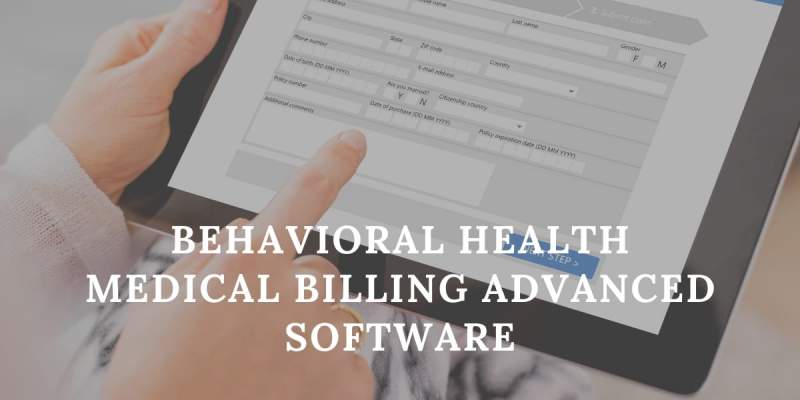
Behavioral Health Medical Billing Advanced Software
Behavioral Health Medical Billing Software has become a necessity in today’s age of mobile technology. A behavioral health expert tends to a lot of clients, hence keeping track of payments and the process of billing and getting paid can become a headache.
On the other hand, Every healthcare provider is required to enroll in an insurance credentialing process to accept patients with insurance. Without credentialing a medical practice simply cannot exist. Behavioral network providers usually enroll with different networks than medical providers. And, that is just the icing of their billing related hassles.
Keeping this frustration in mind, DENmaar set on a course to bring the mental health industry a billing software that would work to rid mental health practitioners of their payment-related hassles. Our billing software comes with an easy to comprehend user interface that would fit right in with your daily medical choirs.
DENmaar’s Mental Health Medical Billing Software can help you get in-network with the nation’s most prominent medical plans, and also take care of other activities like scheduling and of course billing. Most commercial network plans have a separate network for behavioral health providers.
DENmaar has the credentialing experts who have experience with psychiatrists and psychologists to offer you a product that gives you the medical billing system your practice needs and deserves. With our billing software, you don’t have to worry about any paperwork, thus saving you valuable time and Money, our automated system takes care of everything.
Whether you are looking to outsource your billing or looking for a better billing company, DENmaar is your solution to a better behavioral health medical billing software.
Automated Behavioral Health Medical Billing at Your Service
1. Access to Credentialing Experts
Our teams of insurance credentialing experts are always at your service to provide you advice on which insurers to choose and help you get in a network quickly. Our experts have experience working with Medicare, Medicaid, and other commercial health insurance programs.
2. Real-Time Access
DENmaar’s credentialing portal offers you a fully automated system which allows you to monitor your progress. You get real-time access to all your information, files, the status of an application. You can log in anytime you want to retrieve or monitor your data.
3. Behavioral Health Networks
We are well aware behavioral health networks enrollment procedure. We have experience working with specialty networks that serve behavioral health networks specifically. This helps you save a lot of time and money on the extensive enrollment procedure.
4. UP-TO-DATE CAQH
As many insurers use CAQH for their credentialing process, DENmaar helps you create, update, and keep your CAQH current.
5. Automated PAR Status Updates
DENmaar’s RCM portal allows you to be up to speed with credentialing application status.
6. Expiring Documents Alerts
Our automated alerts feature promptly sends you an email notifying you about any imminent document expiry dates. DENmaar will also handle all your insurance panel revalidations, so you never have to go through the hassle of getting credentialed again.
Why Choose DENmaar?
DENmaar has been working in the behavioral health industry and understands the challenges of a practitioner engaged in that practice. Our medical billing software was designed and constructed keeping mental health billing in mind. With our software now launched for both Android and iOS devices, we hope to bring our billing application to all practices who seek a solution to their billing hassles.
Learn More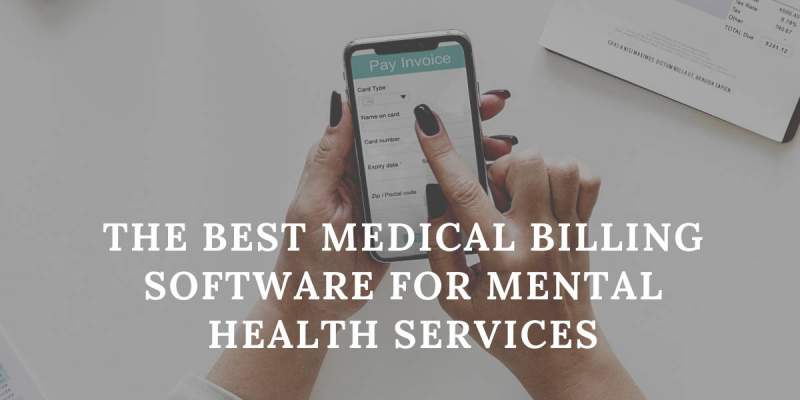
The Best Medical Billing Software for Mental Health Services
What constitutes the best medical billing software for mental health services? Is it an excellent user interface? Or Is it the ability to perform all tasks like scheduling, appointment booking, tracking payments, and billing automatically? Ask this question to a mental health practitioner, and the answer would be all of the above.
And why not? Why not have software that is not only easy to use but also relieves doctors and practitioners from the hassles of everyday billing and payments.
Keeping this frustration in mind, DENmaar set on a journey to bring the mental health industry a medical billing software that would work to rid mental health practitioners of their payment-related hassles. Our billing software comes with an easy to comprehend user interface that would fit right in with your daily medical choirs.
With a hard-earned reputation, DENmaar specializes in professional and facility billing for insurance claims and patient responsibility. Our clients receive our RCM and provider phone apps to easily create charges, which we later submit to insurance and bill patients. All associated expenses are included with our software, billing services, credentialing, text and email messaging, eligibility verification, and patient billing systems.
DENmaar’s fully automated and highly advanced software was developed to bring our clients the benefits of both professional and institutional billing. And that’s not all. Our software also allows for 24 hours claims submission, to ensure you submit your claim on time always.
Our system also allows for the tracking of your claim status. If due to some unfortunate circumstances, your claim does get rejected and denied, then our experts are at your service to take the necessary actions needed for the approval of your claim.
What makes DENmaar’s Medical Billing Software Special.
Improved Patient Payment System
DENmaar’s P2P program is HIPAA compliant and integrates PAYPAL with our RCM to create a conveniently seamless way for patients to make their payments. For providers, it automates the entire payment tracking system. Patients can now make payments without an account. They can pay at the office or through an email link in a matter of a few minutes.
Claim Issues Resolved
Claims which have been denied and rejected are immediately followed up on by DENmaar’s team. We leave no room for such claim issues to occur. That is why DENmaar has a very high first-time claim submission pass through. Payments come in a timely. This allows for cash flows to be maximized, thus making an organization witness its highest revenue generation period.
Staff Claim Tools
All of our apps and software modules, which include intake forms, therapy notes, scheduling, treatment plans, and soon to be released elemental therapy app, are all free to use. We take care of all your setup requirements. This enables companies to make a seamless transition to DENmaar’s system.
Choosing DENmaar
DENmaar has been working in the behavioral health industry and understands the challenges of a practitioner engaged in that practice. Our medical billing software was designed and constructed, keeping mental health medical billing in mind. With our software now launched for both Android and iOS devices, we hope to bring our billing application to all practices which seek a solution to their billing hassles.
Learn More
Letter of Interest for Insurance Credentialing -Tips To Mind
A letter of Interest is practically a letter you send to an insurance company of your Interest in hopes of getting paneled with them. Now, a letter of Interest in many ways is similar to a cover letter with one significant difference.
A cover letter is what you send before applying for a job at a specific point of time, whereas a letter of interest can be submitted at any time. Now, a letter of Interest with respect to credentialing should be sent keeping specific requirements in mind.
You are making an appeal to be welcomed as an in-network provider with an insurance company. Hence, it is essential to know how to approach a letter of Interest to make a compelling appeal to an insurance company.
Click here to get started with Credentialing
Tips for Writing a Letter of Interest.
When a letter of Interest is written compellingly, it can become a powerful tool to persuade a payer to offer access to their network.
1) Identifying Information
As a provider, you must provide information that matches the enrollment application. Information like Name, NPI number, Tax ID, CAQH Number, the specialty and services provided by your company are all vital information to disclose in the letter of Interest.
2) Special Attributes
Don’t forget to mention any unique attributes associated with your practice. Any defining features like whether your business is family-owned or corporation, whether it is a minority or women-owned small business. Small details like these can be instrumental in enhancing your appeal.
3) Unique Services
Highlighting a service, your practice offers that your competitor doesn’t is also a good addition to your letter of Interest.
4) Geographical Locations
Specify your practice’s geographical location. State whether you work in rural or urban areas.
5) Patient Demographics
It is essential to define the kind of patients your practice caters to on a regular basis. Bunch them to include patient groups by age, income group, gender, etc.
6) Referring Services
You can also mention the services you offer which are available for referral. Services such as durable medical requirements, home health, and hospice care.
7) Competitive Rates
Mention your competitor’s rate in comparison to yours as well. Mention if the competitors provide a rate slightly less than the competition. This bit of information can make you more appealing than to the insurance company.
8) Information on Test Programs
Panels are always at a risk of being full. They won’t accept a new practitioner to their already crowded network unless you entice them with something like test or trial programs of your services.
Click here to get started with Credentialing
The other information you need to mention in a letter of Interest are as follows:
- IRS Form W9
- Applicable Licensure
- Marketing material or brochure
- Top billing codes or desired rates.
- Sample claim forms
- Invoice on products.
While writing the letter of Interest, do some due diligence, and find out the name and address of key decision-makers. Address the letter to them. Once you the information you need to send them the letter along with the application and any other attachments.
Make sure to address why you, as a provider, are unique and different from others in the market.
Learn More
Challenges in Nurse Practitioner Credentialing
Insurance credentialing for nurse practitioners is as vital as for other practitioners in the field. However, the dynamics of credentialing is quite different for nurse practitioners than others. Its challenges are different and can cause a lot of distress for the uninformed.
In this article, we will look at some of the challenges faced by nurse practitioners that are exclusive to their faction. It is essential to know the hurdles you face, so when the time comes, you can jump over them with ease.
Challenges with Insurance Credentialing For Nurse Practitioners
Restrictions with License
Nurse practitioners throughout America have to go through various forms of restrictions when it comes to licensure. It varies from state to state. Some states allow Full Practice license to nurse practitioners. This means that they are allowed to evaluate, diagnose, interpret diagnostic tests, initiate or manage treatments and prescribe medications in accordance with the exclusive licensure authority.
Read More: Importance of Nurse Practioner Credentialing for Nurses and Healthcare Organizations
In reduced practice states nurse practitioners require a regulated collaborative agreement with a physician. The collaborative agreement is mandatory if NP’s wish to offer patient care in these states. Without the above formalities, there is no chance for a nurse practitioner to ever get credentialed to undertake practice. It is highly recommended for nurse practitioners in these states to have the necessary collaborative agreements in place when the need arises.
And finally, we have “Restricted.” This kind of practice states requires thorough supervision, delegation, or team management by an outside health discipline for nurse practitioners to practice health care.
Admitting Privileges
Many insurance plans require practitioners to have to admit privileges at an in-network facility. If a practitioner does not have the required admitting privileges then he/she need to prove an “admitting relationship” with another provider.
The requirement can be frustrating for many practitioners who work in a setting that does not have situations that require admissions requirement. As we mentioned, the “admitting relationship” should be in the form of a letter, on the letterhead of the concerned physician who states that the physician in question will handle all inpatient admissions for the patients when necessary.
There is no way you can skip this requirement. Nurse practitioners must keep this requirement ready when undertaking the credentialing process.
Credentialing File
It is highly recommended for nurse practitioners to keeps their files ready. All the credentialing documents and copies that will be required need to filed and available. Documents will always be needed for assessment, whether it is for credentialing or re-credentialing.
Here is a list of documents that you need for credentialing
- State License
- Current CV
- Professional liability insurance
- Current Drivers license
- Collaborative Agreement
- DEA/CSR
- Board Certificate
- Admitting Arrangement Letter
- Prescribing Arrangement letter
- Copy of diploma from the highest level of education.
Get Ahead of the Curve
Credentialing is not a piece of cake and can go on for a better period of a year. If you are starting a new practice or hiring nurse practitioners for your practice, then be ready with all the necessary documents and copies needed. Prepare a credentialing packet for your nurse’s so that they can arrange for the required documents without any confusion.
Learn More

Bankers Life Insurance Credentialing – Getting on the Panel
Let’s discuss the process of Banker’s life insurance credentialing.
Bankers Life insurance credentialing is a subsidiary of the very popular CNO financial group. CNO is a part of the fortune 1000 company list. As of 2019, Bankers life has around 1.4 million policyholders. It offers a variety of different insurance products like long term care, and life insurance, annuities, Medicare products including supplement lines, Medicare advantage plans, and Medicare part D prescription coverage and critical illness insurance.
Bankers Life Insurance credentialing has also partnered with Humana to provide vision and dental plans to their clients. They sell their plans with assistance from a network of over 5000 insurance agents based in over 320 offices throughout America.
As we mentioned, Banker’s life has over 1.4 million policyholders. Practitioners who want to tap into its client base need to get in-network with the credentialing process.
So let’s discuss the process of Bankers Life Insurance Provider Credentialing
1. Getting Your Information in Order
As we mentioned before, Bankers Life insurance credentialing requires a lot of information and documents from the practitioner. They are:
- Licensure Information
- NPI Number
- Resume
- Proof of Malpractice Insurance
- Taxonomy Code
- Proof of Liability Insurance from Landlord (Applicable on if you are renting)
- Credentialing Paperwork
2. Fill Out Your CAQH
You will find many companies who use the Council of Affordable Quality Healthcare for the purpose of credentialing. Before filling out the CAQH form, you are required to hold an authentic resume with no gaps in employment. The application is supposed to be completed online via the CAQH hub.
The entire process can be extremely confusing to follow, but we at DENmaar assist you till the end.
3. Contact provider Relations
Once you have gone through the CAQH process, you are now afforded the liberty of choosing which insurance panel you want to be on. The insurance companies you choose may vary in the department of reimbursement rates, provider friendliness, payment speeds, etc.
Some companies may have their own sets of rules and requirements to apply. Now here you might face an issue of rejection, or not being accepted because the panel is full.
In such cases, you can do the following to build relationships with networks to gain access for future openings:
- Evening and Weekend Availability
- Experience with special populations
- Crisis services
- Handicap accessible facilities
- Being located in an underserved area
- Multilingual fluency
- Having an in-network referral source.
4. Submit Application
Once you have taken care of the documentation and decided on which insurance panel to join, it’s time to submit the application and wait. The entire process of getting paneled is relatively swift, culminating within 9-10 hours.
All you have to do now is a follow-up. You have to keep tabs on the status of your application. Chances are it might expire while still in the process if taken too long, and you don’t want to start again. The insurance companies have to be notified every time you submit a document to ensure it has reached them.
5. Review after Approval
Once you have received approval, it is still not an appropriate time to celebrate. Do the following to be on the safer side.
- Review your contract carefully before signing
- Keep a file with the agreement and any addendums ready for future reference.
- Learn more about the insurance provider’s portal on its official website.
- Collect a list of phone numbers for the claims department, pre-authorization department, and provider relations.
Being a Bankers Life in-network provider can be a very long and tedious process. The entire process requires at least 90 – 120 days to be completed and approved. There is a lot of paperwork, which makes the whole process quite frustrating for medical practitioners who want to accept clients with medical insurance.
Bankers Life’s network is extensive and harbors other insurance companies as well. You can get Meritain insurance credentialing, Coventry insurance credentialing services, etc. with the help of Bankers Life. That is where the professional assistance of DENmaar comes into play. With the help of our credentialing experts, we can walk you through the entire process without complications and hassle so that you can work on other core areas of your medical practice.
Learn More
Top Insurance Companies to Be Credentialed With
What are the top insurance companies to be credentialed with?
It wasn’t long ago when practitioners considered credentialing to optional. You could start your own practice and derive profits from it without ever caring for credentialing. Plus, insurance companies weren’t even allowing certain medical practices like mental health clinics a place on their panels.
Fast forward to modern time, and things are not what they were just a couple of years ago. Credentialing has become crucial for medical practices to survive in an increasingly volatile and competitive industry.
Most American citizens today are covered by an insurance plan provided by some company or the other. If a budding practitioner fails to get credentialed with the insurance companies, then he will lose clients to his competitors.
Hence, having the knowledge of the top insurance credentialing companies is essential in a practitioner being able to thrive in the industry.
So let’s look at some of the top insurance companies to be credentialed within the USA.
So, there are a few ways to determine which top insurance companies in the USA are the biggest in terms of a client base. Their popularity can be due to the following factors:
- Companies Goodwill
- Lives Covered
- Company revenue
- Accessibility etc.
Based on the above factors, we were able to list down the following behemoths. If you are a provider looking to get credentialed, you might want to get in touch with them.
1) United Health Group
Our first name on the list is ranked 3rd on the 2019 fortune 500 lists. United Health Group is a for-profit healthcare company based in Minnesota. As of 2019, it is one of the largest healthcare insurance companies in the world with total revenue of $226 billion, along with 115 million customers. It is divided into four divisions that together provide health benefit plans and services for large national employers, to individuals age 50 and older, to serve state programs that care for the economically disadvantaged, and medically underserved.
2) Anthem
Anthem INC is also one of the largest providers of health insurance in the United States. As of 2019, the company has over 40 million customers under its belt. It is one of the largest for-profit healthcare companies in the Blue Cross Blue Shield Association. Today it operates as Empire blue cross blue shield in the state of New York and as Anthem Blue Cross Blue Shield in 10 other states.
3) Aetna
Aetna is recognized as one of the leading providers of health insurance in the United States. Aetna continues to grow stronger, with millions of users enjoying its medical plan. Hence many physicians and medical practitioners want to become participants in the Aetna healthcare network. The company’s extensive network includes over 22.1 million medical members, 12.7 million dental members, 13.1 million pharmacy benefits management members, 690,000 primary care doctors, 1,200,000 healthcare professionals, and 5700 hospitals.
4) Humana
Humana Inc is a health insurance company based in Kentucky, Louisiana. Over the years, it is responsible for amassing over 13 million Americans into its healthcare program. With revenue of $41.3 billion, Humana was ranked 56 on the Fortune 500 list.
Now, Humana credentials and re-credentials all licensed independent practitioners including physicians, facilities and non-physicians who fall within its scope and authority.
5) Cigna
Cigna is a popular American health service organization based in suburban Bloomfield, Connecticut, and Philadelphia, Pennsylvania. Their insurance subsidiaries are major providers of mental, dental, accident, and life insurance to American citizens.
Cigna is known to provide Medicare and Medicaid programs to an individual in the US and some international markets. Hence many physicians and medical practitioners want to become participants in the Cigna healthcare network. To become a participant, however, healthcare services need to apply for Cigna Insurance Provider Credentialing.
According to Market Share, US News and World Report rated the following top insurance companies to be the most popular in the US.
- United Health
- Kaiser Foundation
- WellPoint INC.
- Aetna
- Human
- Independent Blue Cross Group
- Highmark
- Cigna
- Blue Shield of California
How Denmaar Can Help you Get On these Panels
Getting on insurance panels has never been as crucial as it has been today. With many American citizens now covered under an insurance program, it would be foolish not to get credentialed with an insurance company. However, credentialing has also become a challenge because most panels are almost full and are not taking in new providers.
Denmaar knows the credentialing world from top to bottom. We have assisted many practitioners, both group and private through the entire credentialing process and continue to do so till date. We are the insurance credentialing experts you need to crack the overwhelming process of credentialing for the best of your merits. At Denmaar we do the heavy lifting, so you can concentrate on tending to your clients.
Learn More
Insurance Credentialing and Contracting-Their Merits
When it comes to insurance credentialing and Contracting, you have to understand that they are two sides of the same coin. Both need to seamlessly go hand in hand for an individual or group practice to get on insurance panels.
In this article, we’ll try to simplify the concepts of both Insurance Contracting and credentialing and find out how the two concepts intertwine with each other.
Insurance Credentialing
Credentialing is a process providers need to mandatorily undertake if they seek to serve clients covered by the federal insurance program. The applying provider needs first to verify his/her professional records to get credentialed.
This includes NPI, CAQH, professional licenses, diplomas, certifications, attestations, references, etc. All of these documents are essential to verify the accuracy and reputation of the concerned provider.
The same process applies if the Individual provider is applying for privileges in a group practice such as hospitals and surgery centers. They will be asked to submit a completed application which would be later sent to the credentialing entities for verification.
They will request the provider’s professional documents which may include National Data Bank records, credit card records, and criminal background searches.
They will also indulge in what is called primary source verification, which basically means verifying the source of the provider’s diplomas and educational certificates. There is no way to avoid this as hospitals are mandatorily required to check the above-mentioned documents to protect their patients from bad actors.
The Entire Credentialing process can be summed up as follows:
- Getting Information in Order
- Filling out the CAQH form
- Contacting Provider Relations
- Submit Application
- Reviewing Contract after Approval
As you can see, Insurance credentialing is a lengthy process. It is advised to seek help from third-party service providers like Denmaar to efficiently carry out the overwhelming process. The entire Insurance Credentialing and Contracting process culminates with the approval of the contract by the insurance company.
Contracting
If credentialing was the process of gathering and submitting information, contracting is the process of submitting the information and obtaining credentialing approval. This is where the provider finally obtains participation on an insurance panel. This means he/she can now take in clients that are covered by the health insurance coverage of that particular company. We often see providers enroll in these plans, only never to renew them again.
It is almost as if they forget that their application with a said insurance panel comes with an expiration date. A lot of time may pass by, and insurers may not review your contract, thus failing to reflect on the provider’s reimbursement rates. This spells a recipe for disaster as it can lead to thousands of dollars lost and payments interrupted.
Denmaar’s Insurance Credentialing and Contracting for Providers
Although time-consuming, there is a reason why credentialing requires such a high level of scrutiny. The affordable care act has raised the standards of such scrutiny to reduce fraud and abuse when it comes to Medicare and Medicaid enrollment.
The same applies to the contract. It is essential to be aware of the information contained in the contract of approval. Attention needs to be paid on when the period of credentialing may expire, to apply for re-credentialing quickly.
Denmaar is a mhBilling company that helps providers with both credentialing and re-credentialing. We offer a fully automated system to our clients that keep them updated in real-time with updates regarding their application. At Denmaar we are not just concerned with verifying your forms. We also ensure you are always in touch with your process to ensure your credentialing process is as smooth as possible.
Learn More
Oscar Insurance Credentialing – Getting on Insurance Panel
Let’s understand the process of Oscar Insurance Credentialing
Oscar insurance company is a technology-focused healthcare company that was founded in 2012.
Headquartered in New York City, Oscar provides its services in 9 states across the USA. These 9 states include New York, New Jersey, Ohio, Texas, California, Tennessee, Arizona, Michigan, and Florida.
The company has been popular for using advanced technology to engage with their clients. They use telemedicine; healthcare based technological interfaces, and transparent claims pricing systems.
Oscar began selling insurance the same year the affordable care act exchanges and individual mandates went into effect. In the first year, Oscar managed to secure 16000 members, and it has progressed into even more significant numbers ever since.
As of today, there are at least 25000 members covered under Oscar’s insurance program. They have not only partnered with 3500 nationally ranked doctors, but also work with 20 top health systems in the US.
Hence credentialing with Oscar is crucial if your practice falls under their jurisdiction. This will allow you to tap into a client base that is covered under the Oscar insurance program. So without much further ado, let’s look at the process Oscar Insurance Credentialing for providers.
Oscar Insurance Corporation Provider Credentialing – The Process
1. Pre Application
Before applying, Oscar requires practitioners to submit the necessary information to confirm that the applying practitioner is meeting basic guidelines of insurance credentialing with OSCAR. An Oscar representative is assigned to the practitioner who informs whether the applying party meets all the mandatory guidelines or not.
2. Submit Your Application
Once the practitioner is deemed compliant with Oscar’s guidelines, they send an e-mail containing all the information the provider needs to initiate the process.
If the application information already exists on the CAQH aka Council for Affordable Quality Healthcare, then OSCAR will with the provider’s permission, proceed to access it electronically.
The following information is essential from the provider, depending on :
- Basic Personal Information
- Education and Training Information
- Specialties and Board Certification
- Malpractice Insurance Information
- Work History and References
- Disclosure and Malpractice History
Here are some materials you’ll need:
- CV or Resume
- Malpractice or Insurance Policies
- Drug Enforcement Administration Certificate
- State Licenses
- W9’S
- Various applicable ID numbers
3. Follow Up
Once Oscar Insurance Credentialing receives the application packet, they will start the credentialing process. The entire process will take 45 to 60 days to culminate.
During this time, the provider will receive e-mails regarding:
- Confirmation of Application received
- Request any missing documentation or application information. If any fundamental document or information is found to be absent during the process, Oscar will send a notification, notifying about the closure of that particular application.
- Constant updates about the status of an application, including delays if any.
4. Oscar Approval
If Oscar approves a particular practitioner’s application, the practitioner becomes an in-network provider with OSCAR. Oscar health Insurance Credentialing will updates the provider information in their database within the next 10 business days.
Being an Oscar in-network provider can be a very long and tedious process. The entire process requires at least 90 – 120 days to be completed and approved. There is a lot of paperwork, which makes the whole process quite frustrating for medical practitioners who want to accept clients with medical insurance. That is where the professional assistance of Denmaar comes into play.
With the help of our credentialing experts, we can walk you through the entire process by accomplishing tasks without any complications and hassle so that you can work on other core areas of your medical practice.
Learn More
Insurance Credentialing Specialists – Its Importance
You are probably thinking of whether to hire Insurance Credentialing Specialists or undertake the entire process solo if you are an individual or group practice. If you are even remotely aware of the workings of a typical credentialing process, then you know that going solo is probably not a good idea.
The credentialing process is long, and time-consuming, which can interfere with the efficiency of your practice. As medical professionals, that is something you can’t allow to happen. Hence, hiring credentialing specialists for health insurance payments becomes a wise decision.
What is an Insurance Credentialing Specialist?
The primary role of an Insurance credentialing specialist is to work with group, private or other such medical practices. Hence, helping ensure their medical professionals are complying with government credentialing standards. Insurance Credentialing specialists take it upon themselves to verify the legitimacy of medical professionals with regards to their background, work experience, and education.
An Insurance credentialing expert will have an intricately organized database of the training, education, licensing, and experience information. They ensure that the data thus collected from a healthcare professional is complying with staff policies, government laws, and regulations.
Importance of Insurance Credentialing Specialists
Hiring credentialing experts like Denmaar, helps healthcare organizations in a variety of departments including, of course, the process of credentialing itself. We just discussed the role of insurance credentialing specialists with regard to credentialing. Now let’s dive deep to know why they are absolutely essential players to aid providers in the process of credentialing.
Hiring Qualified Healthcare Professionals
Credentialing specialists can help hospitals and medical organizations hire only those professionals that are qualified and meet all of the credentialing standards set by the government. Specialists extensively verify documents to check whether they are compliant with rules and regulations. This helps hospitals and health care enterprises maintain a staff of competent professionals.
Getting In-Network with Insurance Companies
Getting on insurance panels is what credentialing is all about for many providers. They want to serve clients who are covered under a particular or federal insurance program. Without the necessary credentialing requirements, that is not possible, and the practice loses valuable clients. Third-party credentialing specialists like Denmaar, walk you through the entire process without any hassle so that medical practitioners can concentrate on their practice.
Denmaar also helps in speeding up the process with Medicare, Medicaid, and other commercial insurers, allowing you to now see patients faster and get paid for them sooner.
Credentials Management
The entire application process, diligence, and constant follow-ups can be overwhelming for a provider. However, credentialing specialist relieves providers of such a burden. They keep providers up to date on their application and expedite the process that would usually take months to complete.
Most credentialing specialists now use robust softwar9e’s to manage the credentialing process for their clients. We at Denmaar use a fully automated system that inputs all the relevant information from the provider. The system also provides automated updates on upcoming expiration dates to ensure credentialing is done on time, and providers can continue to accept patients.
Why We Need Credentialing Specialists Today
With a significant portion of the nation’s population already covered under a federal or commercial insurance program, credentialing has become vital. Without it, providers will continue to lose clients. On the other hand, we realize that credentialing is a complex process.
Hence Denmaar has a team of credentialing experts ready to deliver on our promise of efficient credentialing services. Our specialists meet the qualifications that any insurance credentialing specialist job description needs.
With our experts and an advanced system, we promise an efficient credentialing process, unlike any other in the market.
Learn More
CAQH Insurance Credentialing-It’s Benefits in Credentialing
Let’s understand what CAQH insurance credentialing is and how to complete the CAQH profile
efficiently.
CAQH, aka Council for affordable quality healthcare, is essentially an online database that contains vital provider information. It is through the CAQH portal that providers grant insurance companies access to their documents, thus making the entire acquisition process quite efficient.
As of 2019, Almost 90 % of all National Health Insurance Companies use CAQH as their primary database for provider information. This includes over 900 health plans, hospitals, and healthcare organizations.
Benefits if Insurance Credentialing with CAQH
The CAQH was founded with a simple objective in mind, to simplify the data gathering process and allow physicians and other healthcare providers with a single source to submit their information. Without CAQH, a typical physician would have to apply separately to multiple insurance companies, each with their own time-consuming process.
However, with CAQH insurance credentialing, this process is simplified, and the time taken for the processing of applications is significantly reduced.
Another benefit of CAQH insurance credentialing is the security the portal offers its users. The CAQH database resides in a secure network operations network. All information here flows to and fro through redundant firewalls. Strict measures like secure internet access, use of passwords, electronic signatures, SSL certificates ensure that the data is only accessed by authentic users.
No cost is incurred by the providers to use the database, whereas health plans and other healthcare providers pay a certain fee per provider to access information.
Completing The Insurance Credentialing CAQH profile.
Completing the CAQH profile is a crucial step in achieving the credentialing process.
There are three steps to get acquainted with the CAQH system. They are as follows.
1) Getting a CAQH Number
There is a higher chance that the insurance company a provider wants to get into a panel that uses CAQH as its provider information database. Check the list of participating organizations on the Council for affordable quality healthcare website to make sure. If your insurance company does use CAQH, then you will receive a CAQH ID number via mail.
Alternatively, you can also self-register with the CAQH portal to get the CAQH number before applying for credentialing.
The number is significant and should not be lost as it will come in handy while re-attesting the information later down the line.
2) Keeping Information Ready
It is recommended to have all the information ready to complete the CAQH profile. The following are the information required:
- Basic Personal Information
- Education and Training Information
- Specialties and Board Certification
- Malpractice Insurance Information
- Work History and References
- Disclosure and Malpractice History
Here are some materials you’ll need:
- CV or Resume
- Malpractice or Insurance Policies
- Drug Enforcement Administration Certificate
- State Licenses
- W9’S
- Various applicable ID numbers
The information on your CV/ Bio Data needs to be perfect and devoid of any errors. It is mandatory to use dates in the CV complying with the following format – MM/YYYY. There should be no gaps in employment. If your date isn’t formatted correctly, or the gaps in your employment are not filled, then your application will be rejected.
3) Completing the Profile
Once we have all the information required to complete the CAQH profile, it’s time to complete it. It is recommended to undertake this process online. The paper-laden method is simply too chaotic to be conducted with efficiency.
It is not mandatory to finish the CAQH profile in one sitting. The application can be saved to be completed on a later date. Once the information is provided, the website will ask you to review the application and attest to its validity.
Once completed, you will have to choose who gets to access it. CAQH portal gives you two options.
- Allow any insurance company that indicates they would like to allow you on their panel to have access to it.
- Manually choose which panels you would like to have access to your information on CAQH portal.
Although the process is complete, you mustn’t lose your approved information. You will be required to re-attest to the information quarterly.
CAQH Insurance Credentialing With Denmaar
To complete the CAQH profile efficiently, you need a third-party provider you can trust. Denmaar with years of experience to its credit can help you complete the CAQH profile to make your credentialing experience as convenient and hassle-free as possible.
Learn More
Affordable Insurance Credentialing Services-Cost Efficiency
Given the lengthy, tedious nature of Insurance Credentialing Services, the question that most physicians and medical practitioners are left with is if there is such a thing as affordable Insurance Credentialing. Typically, the cost of credentialing with insurance companies is directly related to the time that physicians spend in the process.
The typical duration of the entire process is around four months. During these four months, the medical practice has to go through a variety of steps to get the credentialing process right. Frankly, it varies according to various factors.
Physician Credentialing Services Cost may vary based on:
- • Current Credentialing Service
- • The number of physicians needed to be added
- • How quickly you grow your practice
- • Changes in insurance contracts
- • Additional services rendered by the credentialing service provider
So coming back to the original question – how much does it cost to get credentialed with insurance companies? That answer will vary from physician to physician, based on how much time they spent on the process. To get some clarity on provider credentialing services cost, we must first understand why the process takes so long to conclude.
Why is the Insurance Credentialing Process So Long?
Thanks to credentialing, any newly hired health professional cannot start work at their new facility for the initial few weeks to six months. Normally, it shouldn’t take providers more than 3 hours as all they have to do is gather all necessary documents and submit them.
For the facility staff, however, this process can be excruciatingly long. They are responsible for executing several crucial tasks, which include:
- • Launching a Background Check
- • Gathering and reviewing the health professional’s credentials, past reputation, and case history.
- • Reviewing claims, board history, and privileging
- • Check sanctions with OIG (Office of Inspector General)
- • Perform primary source verifications such as medical boards, education history, etc.
- • Present files to facility stakeholders, credentialing, and executive committees.
The process has to be repeated every time a new provider is to be credentialed. This makes insurance credentialing extremely frustrating. Communication is often a problem during the execution of these processes and the fact that each facility has its own way of spearheading the credentialing process, makes it even more challenging.
Other factors, like incorrect or missing information in the application, can delay the process even further. If the credentialing board has a stuffed schedule, then you can expect further delays. As such, you can now understand why many health professionals and institutions consider credentialing to be a never-ending headache.
How Much Does Credentialing Cost?
One way to estimate Insurance Credentialing Services costs is by calculating the time a physician would spend on the actual credentialing process. On average, that would be 43 minutes per day.
Now, if we assume that a physician works on $100/hr, that’s approximately $20000/year in credentialing work per physician. This is excluding any paperwork; of course, you lose more money if you lose relevant documents.
In hindsight, you are spending way more than $20000/year. Medical Insurance Credentialing costs way less when outsourced to a third party like DENmaar. Refer to the below breakdown to understand – how much does physician credentialing costs?
Credentialing Cost Breakdown
Individual Physician Cost – 100-200$ per physician
CAQH Database
Initial Setup Costs can go up to $200-$500
Panel Application Cost
Physicians should expect to pay $100 per panel
So, the average cost to credential a physician is somewhere between $2000-$3000/per year. The average cost to credential a nurse practitioner will be more or less the same as well.
Why does Credentialing Cost So Much?
Most of the cost incurred in the process of credentialing is because of its lengthy nature. You lose money if you lose your documents. You lose money if you fail to follow up with the insurance companies, resulting in the expiration of your application. The entire process has too many pot-holes for medical practices to crash and burn.
An average physician can lose thousands in income due to this process. Let’s say that a physician makes $299,000. Waiting to render their services for a few weeks due to credentialing will cost them around $25000. Even worse, waiting for six months could cost them an income of around $150,000.
The problem isn’t limited to a few healthcare professionals. In fact, the entire healthcare industry loses billions every year in the USA due to an inept credentialing process. Fortunately, there is a way to avert this disaster and make the credentialing process more cost-effective.
Perform Credentialing in a Better way with DENmaar
Credentialing doesn’t have to be as time-consuming or costly as it has been for a long time. All you need are the right credentialing experts shouldering the responsibility on your behalf. This is where DENmaar’s insurance credentialing services come into play.
DENmaar is home to the credentialing experts, resources, and insight needed to expedite and execute the entire credentialing process in an effective and efficient manner.
DENmaar offers a fully automated system that provides practitioners with end-to-end solutions to credentialing. You are automatically updated about the status of your application. You get automated re-validation alerts, are assisted throughout the CAQH form filling process, and are alerted of your status application in real-time.
Affordable medical Insurance Credentialing Services cost is possible only when you outsource them to companies like DENmaar.
Fill out the form below or call now on 1-888-595-5100 to get a free estimate.
Learn More
Credentialing Doctors to Your Group Practice
You have just started a new practice, and you now want to learn about the process of Credentialing Doctors to your group practice. There are many questions that storm the mind before the inception of such a process. Where to begin? Whom to approach? What insurance panels to choose, or how to panel with an insurance company?
The question can be baffling and complex, but not as complicated as the process itself. Those who have undertaken the process know-how stretched out and overwhelmingly complex it actually is. With lots of paperwork, constant follow-ups, and increased risk of loss of documents, it is one hell of an undertaking; many practices wish they would never have to go through. Thankfully, there are third-party Insurance credentialing service providers that can help you immensely with the entire dreadful process by avoiding all of its hassles.
Let’s look at some of the main questions that practices have with regards to insurance credentialing for physicians.
How to Know Which Insurance Companies to Panel With?
You start by asking your colleagues in the same field, or the providers in your own locality about which insurance they are using. Find out all the pros and cons of the insurance companies from them like their rates, promptness of payment, etc. Know which physician credentialing insurance companies are popular in your locality, and which have the most clients’ coverage.
Should You Set Up a Group Contract with Insurance Company?
Some insurance companies allow group contracts, and some don’t. It varies from one company to the other. What is more important to consider is that your clinicians get credentialed using the practices NPI2 and tax ID, and not their own social security numbers. You don’t want to chase all of your clinicians for the checks that were supposed to come to you. Let your clinicians fill out their w9 form with your name, TIN, and address, so insurers know to send the checks to you and not them.
Another benefit of applying as a group is that it is easier to negotiate rates this way than it is to negotiate to be a solo provider. Also, the process of adding clinicians is easier and less time-consuming.
What to do once clinicians have completed their application to participate?
Documents get lost all the time during the process of credentialing. In such a scenario, it is important to follow up with the provider relations departments regarding the receiving of a document. Follow up every week, but do not do it constantly so as not to annoy the already irate officials.
Like we said before, the entire credentialing Doctors process is not without its hassle. We would suggest putting together a Credentialing packet for all your clients with all the credentialing Doctors related information they will need. This will make the entire process easier as every entering therapist will have the knowledge needed for their individual credentialing requirements.
With the help of Denmaar’s credentialing experts,we can walk you through the entire process without any complications and hassle so that you can work on other core areas of your medical practice. You deserve the best physician insurance credentialing services, and we know how to deliver it.
Learn More
Humana Behavioral Health Credentialing Services
Humana Provider Credentialing & Contracting Services
Join Humana as an in-network healthcare provider and expand your services to a wider base of patients with our Humana Insurance provider credentialing services.
Let’s discuss the Humana Health Insurance Credentialing Process.
Humana Inc is a health insurance company based in Kentucky, Louisiana. Over the years, it is responsible for amassing over 13 million Americans into its healthcare program. With revenue of $41.3 billion, Humana was ranked 56 on the Fortune 500 list.
Now, Humana credentials and re-credentials all licensed independent practitioners including physicians, facilities, and non-physicians who fall within its scope and authority.
The following elements are crucial for a practitioner to be credentialed by Humana:
- Applying provider is in good standing with state and federal regulatory bodies.
- Applying Provider has been reviewed and approved by an accredited body.
- Every three years is still in good standing with state and federal regulatory bodies and is reviewed and approved by an accredited body.
- Liability insurance coverage is maintained.
- Copy of facilities State License.
- CLIA certificates are current.
- Completion of a signed and dated application.
As mentioned, Humana has at least 13 million Americans covered under its insurance program. Hence, it makes sense for Humana health insurance provider credentialing to get in-network with humans to tap into what could potentially be a lucrative market. The process, however, is overwhelmingly tedious with too many moving parts. Thankfully, DENmaar’s team of experts will help assist you throughout the Humana credentialing process.
Check out Credentialing Process Checklist.
The Process to Apply for Humana Health Insurance Credentialing
The provider credentialing process for Humana is as follows:
1. Pre Application
Before applying, Humana physician Credentialing requires practitioners to handover some necessary information to confirm that the applying practitioner is meeting the basic guidelines of Insurance Credentialing with Humana. A Humana representative is assigned to the practitioner who informs whether the applying party meets all the mandatory guidelines or not.
2. Submit Your Application
Once the practitioner is deemed compliant with Humana’s Health Insurance Credentialing guidelines, they send an e-mail with an application packet containing all the information needed to get started.
If the application information already exists on the CAQH aka Council for Affordable Quality Healthcare exists on the CAQH or One Health-port website, then Humana will with the applying parties’ permission, proceed to access it electronically.
The Following application information is required from the applying party, depending on:
- • Active and Unrestricted License in the State
- • Drug Enforcement Agency Certificate (If Applicable)
- • Good Standing With Medicare and Medicaid, Medicaid Number
- • Humana participation in-hospital clinical privileges
- • letter of interest for insurance credentialing for Humana
- • Board Certification Status
- • Professional and Educational Training
- • 5 Year of Work History
- • Malpractice Claims History
- • Adequate Malpractice Insurance
- • Prior Sanctioning Activities
3. Follow Up
Once Humana receives the application packet, they will start the credentialing process. The entire process will take 45 to 60 days to complete.
During this time, the applying party will receive e-mails regarding:
Confirmation of Application received
Request any missing documentation or application information. If any fundamental document or information is found to be absent during the process, Humana will send a notification, notifying about the closure of that particular application.
Constant updates about the status of an application, including delays if any.
4. Humana Approval
If Humana approves a particular practitioner’s application, the practitioner becomes an in-network provider with Humana. Humana will update the provider information in their database within the next 10 business days.
Being a Humana in-network provider although tedious, is essential for providers to get clients who are covered under the Humana Insurance program. We at Denmaar, understand that medical practices would rather focus their energies on treating their patients rather than focus on the tedious task of credentialing. Hence, we offer a robust end to end credentialing solution that assists you throughout the process.
DENmaar’s Insurance Credentialing Services and its Benefits
The following are the major benefits you can enjoy by availing of our Humana Provider credentialing services.
1. Access to Credentialing Specialists
We are home to highly skilled credentialing specialists who are with you from start to finish to make sure your credentialing process with Humana goes smoothly, without any hiccups.
2. Expiring Document Alerts
We arm you with personalized credentialing software that promptly alerts you of expiring documents so you can take the necessary steps before the set deadline.
3. Up-To-Date CAQH
CAQH is an integral part of the healthcare credentialing process. At DENmaar, we help you create, update, and keep your CAQH relevant.
4. Automated PAR Status Updates
Be up-to-speed about your application’s status at each and every step of the Humana credentialing process with DENmaar’s special RCM portal.
Who We Help with Insurance Credentialing & Enrollment?
We simplify the insurance credentialing & contracting process for the following entities.
- • Physicians
- • Physician Assistants
- • Nurse Practitioners
- • Urgent Care Facilities
- • Audiologists
- • Behavioral Health Providers
- • Physical, Occupational, and Speech Therapists
Join Humana as an In-Network Provider with DENmaar
Humana contracting and credentialing is no child’s play. At DENmaar, however, we are home to Humana credentialing specialists who possess the experience, skills, and resources needed to help you get credentialed with Humana in a quick and efficient manner. We make sure all of your documentation is taken care of to make sure your submitted application has a chance of being rejected. If by any chance your application is denied, you rest assured that our specialists will do the necessary and resubmit the application in time to boost your chances of getting credentialed with Humana.
Learn More
Addiction Treatment Credentialing – Benefits
Addiction Treatment Credentialing have become absolutely necessary for medical practices who have taken it upon themselves to combat the crisis of substance abuse disorder.
The Addiction fighting workforce today is represented by at least 100,000 counselors, healthcare professionals, and educators. These professionals help in the treatment, recovery, and support of individuals suffering from substance issue problems.
However, rendering of such treatment and recovery process becomes impossible for medical professionals if they fail to get credentialed with government or private medical agencies like Medicare, Medicaid, Aetna, etc. Private and group practices cannot offer addiction treatment or collect payments from patients who are covered by the federal insurance program.
Addiction Treatment Credentialing – What is it?
Credentialing is the process of assessing the legitimacy and background of a medical practitioner and establishing the qualifications they require to become licensed professionals. The concept is simple and is designed to protect ailing individuals from being exploited by fraudulent practices.
With the help of Addiction treatment Insurance credentialing, healthcare professionals have the necessary license requirements to legally serve new patients and get paid by these patients for the services they perform.
Why Get Addiction Treatment Insurance Credentialing
Rising Substance Abuse Disorder (Crisis)
The crisis of addiction our nation faces today is the stuff of nightmare. In 2017 alone, 70,000 Americans died of a drug overdose. This includes prescription opioids, heroin, and illicitly manufactured fentanyl abuse. The death rate has gone up from 6.2 per 100000 people in 2000 to 14.2 per 100000 people in recent years.
The numbers signal the imminent demand for Medical practitioners who have the skills and qualifications needed to provide medical attention to a population of people suffering from Substance Abuse Disorder.
Consistent Work
Probably one of its vital benefits is how it can get a medical practice onto an insurance panel, or better yet turn them into an in-network provider. This allows for dealing with billing codes, rates, and other reports and deliverables consistently. The overall uniformity this system offers can help healthcare enterprises make essential decisions more effectively and efficiently.
Better Customer Support
As many insurance companies, today have their own team of autism specialists, in-network providers such as licensed medical practitioners have the chance to socialize and build valuable relationships within the organization that can help with faster claim resolution, or helps resolve queries regarding claim issues. This allows for pre-authorization, re-authorization, and claims information online. All of these factors ultimately enable clinics to provide better customer support to their customers.
Electronic Claims
Getting credentialed allows medical practices to send bills to insurance providers electronically. Electronic claims are a faster, more convenient way of receiving payments quickly than traditional paperwork. Unfortunately, this benefit cannot be enjoyed by medical practices that don’t possess the necessary credential requirements.
The Process of Getting Addiction Treatment Credentialing.
The Addiction Treatment Credentialing process is a long and complicated one. The whole process can take between 90 and 120 days to culminate. It is highly recommended that the credentialing process be started as soon as possible, especially for new medical practices.
You also have to be ready to take 45-minute calls every day while your application is under process. Hence due to its length of time and complicated nature, it is highly advisable to seek the help of third-party support like denmaar who can get the job done for you.
The following is the process to get Addiction Treatment Credentials.
1. The first step towards getting credentialed requires medical firms to apply for an NPI aka National Provider Identifier. An online application requires the input of information like social security number, BCBA certificate number or BCaBA certificate number, Taxonomy code for behavioral analysts, and BA license number if applicable. The NPI is usually acquired within a day and is essential to receive reimbursements for ABA services with any carrier.
2. After the acquisition of NPI, the next step is to become a member of The Council for Affordable Healthcare. A medical practice can only become a part of CAQH. The medical practice needs an invitation from the insurance provider. Once the firm can log in to the CAQH system, they are required to submit a plethora of information such as employment history, references, resume, and W9, BCBA, or BCaBA certificates, educational history, information about medical practice.
3. After the application is completed, insurance companies will have access to the information provided. They will use the information to verify it with their agency.
Stop Losing Patients with Insurance
Medical practices need to be privy of all the plans and terms of coverage offered by insurance companies. Almost all Americans are enjoying the benefits of some of the other health insurance programs. Without the necessary credentialing requirements, there is no point in even starting a medical practice that treats addiction, no matter how noble your intentions may be.
Addiction Treatment Insurance Credentialing is essential for medical practices to continue to accept new patients and receive payments to justify their services. The process to get credentialed can be tedious, a problem that can be alleviated by hiring third party professionals like denmaar who can do the heavy lifting for a medical practice.
Learn More

Affordable Insurance Credentialing Services-Cost Efficiency
Given the lengthy, tedious nature of Affordable Insurance Credentialing Services, the question that most physicians and medical practitioners are left with is if there is such a thing as Insurance Credentialing. Most of the cost incurred during the Insurance Credentialing is directly related to the time that physicians spend in the process.
The typical duration of the entire process is around four months. During these four months, the medical practice has to go through a variety of steps to get the credentialing process right. Frankly, it varies according to various factors.
The Affordable Insurance Credentialing Services may vary based on:
- Current Credentialing Service
- The number of physicians needed to be added.
- How quickly you grow your practice.
- Changes in insurance contracts
- Additional services rendered from the credentialing service provider.
One way to estimate the Affordable Insurance Credentialing Services cost in calculating the time a physician would spend on the actual credentialing process. On average, that would be 43 minutes per day.
Now, if we assume that a physician works on a $100/hr, pay, that’s approximately $20000/year in credentialing work per physician. This is excluding any paperwork; of course, you lose more money if you lose relevant documents.
In hindsight, you are spending way more than $20000/year. medical Insurance Credentialing cost way less when outsourced to a third party like Denmaar.
Credentialing Cost Breakdown
Individual Physician Cost – 100-200$ per physician
CAQH Database
Initial Setup Cost can go up to $200-$500
Panel Application Cost
Physicians should expect to pay $100 per panel
So, on average, the general cost of Affordable Insurance Credentialing Services is somewhere between $2000-$3000/ year.
Most of the cost incurred in the process of credentialing is because of its lengthy nature. You lose money if you lose your documents. You lose money, if you fail to follow-up with the insurance companies, resulting in the expiration of your application. The entire process has too many pot-holes for medical practices to crash and burn.
This is why third-party Insurance Credentialing is so essential in getting on insurance panels. Denmaar offers a fully automated system that provides practitioners with end to end solutions to credentialing. You are automatically updated about the status of your application. You get automated re-validation alerts, are assisted throughout the CAQH form filling process, and alerted of your status application in real-time.
Affordable medical Insurance Credentialing Services cost can be availed only when you outsource them to companies like Denmaar.
Fill the form below or call now on 1-888-595-5100 to get a free estimate.
Learn More
Psychologists Insurance Credentialing Services
Psychologists Insurance Credentialing Services and counselors have become extremely important today. Psychologists, just like other practitioners, need to go through an extensive credentialing process to validate their practice.
Mental health specialists have become an integral part of the modern society reeling with record-high numbers of people suffering from a mental ailment of one form another. Psychologists Insurance credentialing Services need to have access to insurance panels to continue to cater to clients covered under the federal insurance program.
Below are some reasons why Insurance Credentialing for Psychologists Services is vital.
Flexibility
If you are a professional working for a firm or a group practice then, of course, you can get away with not getting credentialed as your firm is already an in-network provider. But what if you want to start your own practice? In such a scenario, not having the valid credentials will pinch. Having the necessary Psychologists Insurance credentialing Services requirements helps individual psychologist tend to clients who are covered under the federal insurance program.
HMO’s
Not long ago, it was the norm for psychologists to rely on PPO’s (preferred provider options) being used by their new clients. This allowed psychologists and counselors to avoid the need for being on insurance panels.
However, today, HMO’s are used more extensively than PPO’s, which have become very rare. PPO’s simply isn’t financially viable anymore, and practice will incur fines and penalties for using PPO’s if you are out of their network.
Universal Healthcare
Our times are different than our predecessors. The affordable healthcare act launched by the US has created an amicable environment where everyone can afford to see a counselor. This is excellent news for counselors on insurance panels, and not so much for those relying on the cash-based system.
With cries for more progressive healthcare policies like Medicare for all becoming deafeningly louder, it is beneficial for Psychologists Insurance Credentialing Services to get in-network with insurance panels.
Panels are closing
Many group and private practices are vying for the same panels at the same time. This is leading to many reputed and well-known insurance panels rapidly closing down. The competition is just too intense. Insurance companies cannot afford to be in-network with everyone as it is just not financially viable for them. Hence, jumping at the opportunity sooner than competitors is important.
Just like other practitioners, psychologist credentials with insurance companies need to get in-network. With universal healthcare, they simply cannot afford to lose clients that are on insurance programs. Getting on insurance panels is crucial for Psychologists Insurance Credentialing Services and counselors to accept new clients and expand their practice.
That is where the professional assistance of Denmaar comes into play. With the help of our credentialing experts, we can walk you through the entire process without any complications and hassle so that you can work on other core areas of your medical practice.
Learn More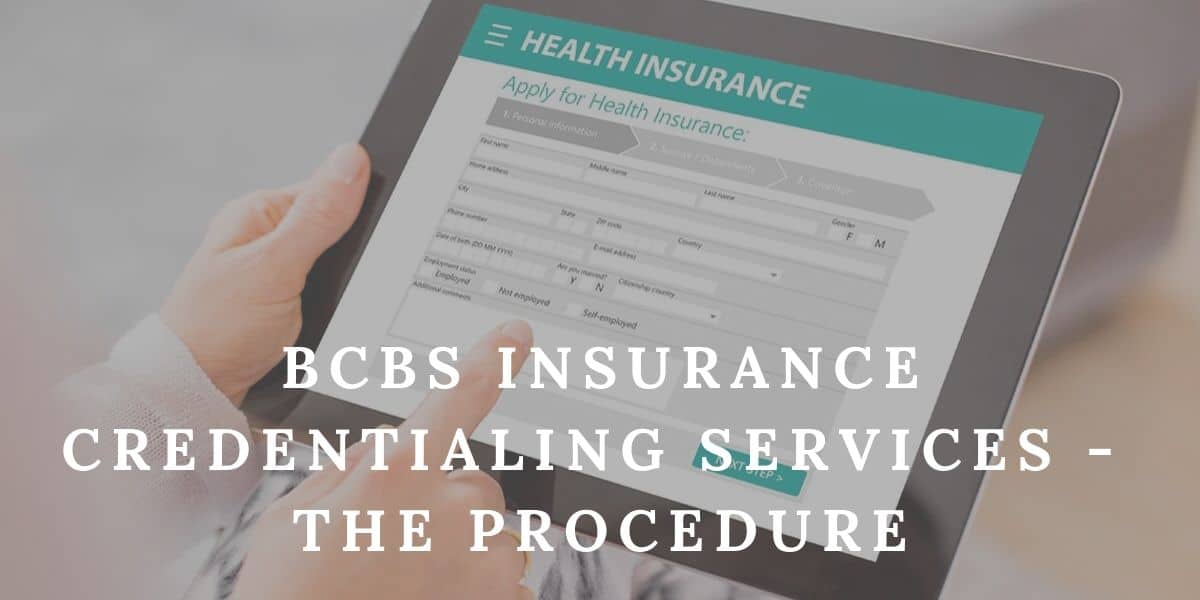
Blue Cross Blue Shield Provider Credentialing & Enrollment Services
BCBS aka Blue Cross Blue Shield Association is a widely recognized federation of 36 separate Health Insurance organizations, and Companies. This association, which includes different well-known insurance providers, covers more than 106 million citizens in America. Publicly traded and privately owned insurance companies like Anthem, CareFirst, Highmark, Premera, Cambia Health Solution, etc. are all part of the BCBS Insurance Credentialing Services.
As such, applying for BCBS Provider Credentialing is crucial for practitioners who seek to tap into the pool of potential clients who are covered by the Blue Cross Blue Shield Association. Now, becoming an in-network provider is a three-part process. It is lengthy and fairly complicated. It is advisable for the group and private practices to seek help from third-party credentialing service providers like DENmaar to simplify the entire process.
Let us look into the BCBS Credentialing Process:
As mentioned before, becoming an in-network provider with BCBS is a three-part process.
- • Getting Credentialed or Re- Credentialed with BCBS
- • Register Your NPI (National Provider Identifier)
- • Have a Signed Contract with BCBS in your state.
1 – Getting Credentialed or Re- Credentialed
BCBS first checks the credentials of medical practitioners who apply for Insurance Credentialing Services. They have to submit their resume, work history, and other vital information for the purpose of background verification. The applying party can send their applications and documents online or manually.
Online application with BCBS Insurance Credentialing Services is only exclusive to providers. The information is sent to the Universal Credentialing DataSource (UCD). BCBS works closely with the Council of Affordable Quality Healthcare, thus making the entire process quite simpler.
BCBS Provider enrollment also requires that facilities that are not providers have to send their applications manually.
2 – Obtain an NPI (National Provider Identification Number)
The NPI, also known as National Provider Identifier, is a ten-digit unique identification number used to replace provider identifiers such as the unique provider identification number in HIPAA standard transactions.
Healthcare providers must obtain an NPI in accordance with HIPAA regulations. AN NPI should be obtained before applying to get into BCBS network.
3 – Get a Signed Contract with BCBS
Before getting a signed contract with BCBS you have to register your NPI Through the enrollment application process. You need to register to be able to access Explanation of Payments (EOP), and sign an EFT to receive claims payment.
The entire process can take 30 – 45 days from the date of NPI enrollment.
As you can probably guess by now, becoming an in-network provider with BCBS can be a very long and tedious process. The entire BCBS behavioral health credentialing process requires at least 90 – 120 days to be completed and approved. There is a lot of paperwork, which makes the whole process quite frustrating for medical practitioners who want to accept clients with medical insurance. There is also a higher risk of application rejection when you go about the BCBS credentialing process alone.
That is where the professional assistance of DENmaar comes into play. With the help of our BCBS Insurance Credentialing Services, we can walk you through the entire process without any complications and hassle so that you can work on other core areas of your medical practice.
Benefits of utilizing DENmaar’s Credentialing and Enrollment Services
The following benefits await those who seek DENmaar’s Blue Cross Blue Shield Provider Credentialing.
- • Get Assisted by Highly Skilled BCBS Credentialing Experts
- • Get Credentialing Assistance from Start to Finish.
- • Our Credentialing experts ensure your applications are submitted to BCBS on time.
- • We regularly follow up with BCBS at your behest to get updates on your applications
- • We will help you update your CAQH profile
- • Get real-time status updates with a real-time RCM portal
- • Stay informed and get alerts on expiring documents on time.
Who We Help with Blue Cross Blue Shield Provider Enrollment
- • Physicians
- • Physician Assistants
- • Nurse Practitioners
- • Urgent Care Facilities
- • Audiologists
- • Behavioral Health Providers
- • Physical, Occupational, and Speech Therapists
Join BCBS as an In-Network Provider with DENmaar
Getting on the BCBS network is no easy task. However, it is essential if you want to accept and care for patients with BCBS-sponsored health insurance. At DENmaar, we offer end-to-end BCBS Credentialing services that help your behavioral health practice expand its reach and provide care to more patients in the process. You can rest easy knowing that our credentialing experts will be working closely with you and guide you throughout the often long BCBS Provider enrollment process.
We are home to credentialing specialists who possess the insight, experience, and resources needed to get you to that credentialing finish line without a hassle. We will make sure your claims filed are clean to avoid claim rejections and accelerate the process of getting you in-network with BCBS.
With DENmaar by your side, you can expect to overcome BCBS’s credentialing challenges effortlessly while making sure that other core areas of your healthcare enterprise receive your undivided attention.
Contact us at DENmaar, to start your journey to becoming an in-network provider with Blue Cross Blue Shield
Error: Contact form not found.
Learn More
Cigna Insurance Credentialing – Getting On the Cigna Panel
Let’s discuss the Cigna Insurance Credentialing Process.
Cigna is a popular American health service organization based in suburban Bloomfield, Connecticut, and Philadelphia, Pennsylvania. Their insurance subsidiaries are major providers of mental, dental, accident, and life insurance to American citizens.
Cigna is known to provide Medicare and Medicaid programs to an individual in the U.S. and some international markets. Hence many physicians and medical practitioners want to become participants in the Cigna healthcare network. To become a participant, however, healthcare services need to apply for Cigna Insurance Provider Credentialing.
As we mentioned, Cigna has an extensive network of people who subscribe to their health insurance. If accepted as part of the network, a medical service provider naturally becomes an in-network provider and people with Cigna plan will be more inclined to use their particular medical service.
The Process to Apply For Cigna Health Insurance Provider Credentialing
The entire process of applying to get into any insurance provider network can be long and complicated. However, it is necessary to tap into those clients who have insurance, thus making the process mandatory to run a successful medical practice.
1. Pre Application
Before applying, Cigna requires practitioners to handover some necessary information to confirm that the applying practitioner is meeting basic guidelines of insurance credentialing with Cigna.
A Cigna health Insurance Credentialing representative is assigned to the practitioner who informs whether the applying party meets all the mandatory guidelines or not.
2. Submit Your Application
Once the practitioner is deemed compliant with Cigna’s guidelines, they send an e-mail with an application packet containing all the information needed to get started.
If the application information already exists on the CAQH aka Council for Affordable Quality Healthcare exists on the CAQH or One Healthport website, then Cigna Insurance Credentialing will with the applying parties permission, proceed to access it electronically.
The Following application information is required from the applying party, depending on:
- State Medical or appropriate professional License
- Drug Enforcement Agency Certificate (Mandatory)
- Controlled Dangerous Substances Certificate (Mandatory)
- Cigna participation in-hospital clinical privileges
- letter of interest for insurance credentialing for Cigna
- Board Certification Status
- Professional and Educational Training
- Work History
- Malpractice Claims History
- Adequate Malpractice Insurance
- Prior Sanctioning Activities
3. Follow Up
Once Cigna receives the application packet, they will start the credentialing process. The entire process will take 45 to 60 days to complete.
During this time, the applying party will receive e-mails regarding:
- Confirmation of Application received
- Request any missing documentation or application information. If any fundamental document or information is found to be absent during the process, Cigna Insurance Credentialing will send a notification, notifying about the closure of that particular application.
- Constant updates about the status of an application, including delays if any.
4. Cigna Approval
If Cigna approves a particular practitioner’s application, the practitioner becomes an in-network provider with Cigna. Cigna will update the provider information in their database within the next 10 business days.
Being a Cigna Insurance Credentialing in-network provider can be a very long and tedious process. The entire process requires at least 90 – 120 days to be completed and approved. There is a lot of paperwork, which makes the whole process quite frustrating for medical practitioners who want to accept clients with medical insurance. That is where the professional assistance of DENmaar comes into play.
With the help of our credentialing experts, we can walk you through the entire process by accomplishing tasks like updating credentialing with insurance Cigna, without any complications and hassle so that you can work on other core areas of your medical practice.
Error: Contact form not found.
Learn More
Mental Health Insurance Credentialing – The Process
Mental health Insurance Credentialing for psychologists and counselors have become extremely important today. Mental health specialists, just like other practitioners, need to go through an extensive credentialing process to validate their practice.
By forsaking credentialing, a practitioner compromises on a good number of clients covered under the federal insurance program. With a clamoring for more progressive ‘medicare for all idea floating in the United States political spectrum, credentialing has never been this urgent for mental health specialists.
Mental Health Insurance credentialing and billing for mental health professionals
Now, if we assume that a physician works on a $100/hr, pay, that’s approximately $20000/year in credentialing work per physician. This is excluding any paperwork; of course, you lose more money if you lose relevant documents.
In hindsight, you are spending way more than $20000/year. Credentialing services cost way less when outsourced to a third health insurance credentialing specialists like Denmaar.
Credentialing Cost Breakdown
Individual Practitioner Cost – 100-200$ per physician
CAQH Database
Initial Setup Cost can go up to $200-$500
Panel Application Cost
Practitioners should expect to pay $100 per panel
So, on average, the general cost of physician insurance credentialing services is somewhere between $2000-$3000/ year.
Most of the cost incurred in the process of Mental Health Insurance Credentialing services is because of its lengthy nature. You lose money if you lose your documents. You lose money, if you fail to follow-up with the insurance companies, resulting in the expiration of your application. The entire process has too many pot-holes for medical practices to crash and burn.
Hence, it is highly recommended to use the help of third-party experts like Denmaar for Mental Health Insurance panel credentialing.
Mental Health Insurance Credentialing Process
1.Getting Your Information in Order
As we mentioned before, credentialing requires a lot of information and documents from the
practitioner.
They are:
- Licensure Information
- NPI Number
- Resume
- Proof of Malpractice Insurance
- Taxonomy Code
- Proof of Liability Insurance from Landlord (Applicable on if you are renting)
- Credentialing Paperwork
2. Fill Out Your CAQH
You will find many companies who use the Council of Affordable Quality Healthcare for the purpose of credentialing. Before filling out the CAQH form, you are required to hold an authentic resume with no gaps in employment. The application is supposed to be completed online via the CAQH hub.
The entire process can be extremely confusing to follow, but we at Denmaar assist you till the end.
3.Contact provider Relations
Once you have gone through the CAQH process, you are now afforded the liberty of choosing which insurance panel you want to be on. The insurance companies you choose may vary in the department of reimbursement rates, provider friendliness, payment speeds, etc.
Some companies may have their own sets of rules and requirements to apply. Now here you might face an issue of rejection, or not being accepted because the panel is full.
In such cases, you can do the following to build relationships with networks to gain access for future openings:
- Evening and Weekend Availability
- Experience with special populations
- Crisis services
- Handicap accessible facilities
- Being located in an underserved area
- Multilingual fluency
- Having an in-network referral source.
4.Submit Application
Once you have taken care of the documentation and decided on which insurance panel to join, it’s time to submit the application and wait. The entire process of getting paneled is relatively swift, culminating within 9-10 hours.
All you have to do now is a follow-up. You have to keep tabs on the status of your application. Chances are it might expire while still in the process if taken too long, and you don’t want to start again. The insurance companies have to be notified every time you submit a document to ensure it has reached them.
5.Review after Approval
Once you have received approval, it is still not an appropriate time to celebrate. Do the following to be on the safer side.
- Review your contract carefully before signing
- Keep a file with the agreement and any addendums ready for future reference.
- Learn more about the insurance provider’s portal on its official website.
- Collect a list of phone numbers for the claims department, pre-authorization department and provider relations.
Once you have taken care of the above bucket list, you are ready to sign. To speed up the process, Denmaar’s will help you submit your claims electronically. This will help you save time, money, and paper.
Learn More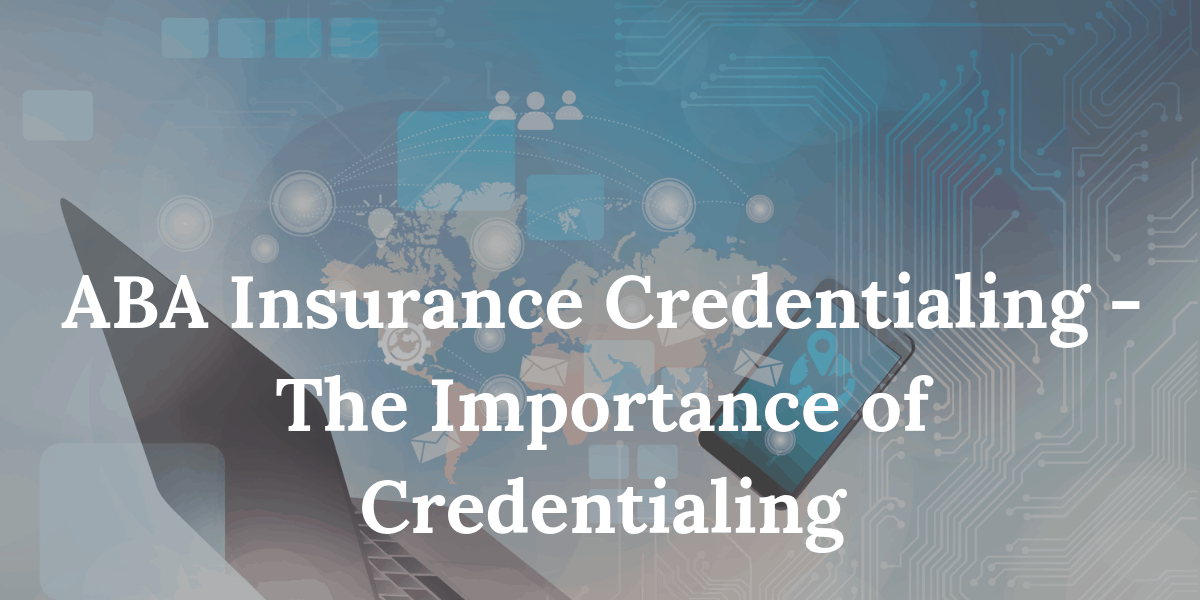
ABA Insurance Credentialing -The Importance of Credentialing
ABA insurance credentialing is one of the many crucial aspects required to run a behavioral therapy clinic. A successful medical practice has many moving parts that define its performance every day. A healthcare organization must meet its credentialing requirements to provide services to their patients. If a medical practice fails, for whatever reason, to get credentialed with government medical agencies like Medicare, they cannot treat patients and collect payments from patients who are covered by the federal insurance program.
ABA Insurance Credentialing Therapy
Credentialing is the process of assessing the background and legitimacy of a medical practitioner and establishing the qualifications they require to become licensed professionals. As ABA therapists are practically board approved behavioral analysts, one cannot be an ABA therapist without meeting the credentialing requirements in their field of practice. With the help of ABA credentialing, behavioral therapy clinics are permitted to legally serve new patients and get paid by these patients for the services they perform.
Stop Losing Clients, Call us now on: 1-888-595-5101
Why Get ABA Insurance Credentialing
A Population Living With Autism Spectrum disorder
It is estimated that at least 3.5 million Americans today live with an autism spectrum disorder. The numbers signal the imminent demand for ABA therapists who have the skills and qualifications needed to provide medical attention to the ailing population.
Consistent Work
Probably one of its vital benefits is how it can get a medical practice onto an insurance panel, or better yet turn them into an in-network provider. This allows for dealing with billing codes, rates, and other reports and deliverables consistently. The overall uniformity this system offers can help healthcare enterprises make important decisions more effectively and efficiently.
Better Customer Support
As many insurance companies, today have their own team of autism specialists, in-network providers such as licensed ABA therapists have the chance to socialize and build valuable relationships within the organization that can help with faster claim resolution, or helps resolve queries regarding claim issues. This allows for pre-authorization, re-authorization, and claims information online. All of these factors ultimately enable clinics to provide better customer support to their customers.
Electronic Claims
Getting credentialed allows medical practices to send bills to insurance providers electronically. Electronic claims are a faster, more convenient way of receiving payments quickly than traditional paperwork. Unfortunately, this benefit cannot be enjoyed by medical practices that don’t possess the necessary credential requirements.
The Process of Getting Credentialed.
The ABA credentialing process is a tricky one. The whole process can take around 90 to 120 days to culminate. It is highly recommended that the credentialing process be started as soon as possible, especially for new medical practices. Because of its length of time, and complicated nature, it is highly advisable to seek the help of third-party support like denmaar who can get the job done for you.
The following is the process to get ABA Insurance Credentials
1.The first step towards getting credentialed requires medical firms to apply for an NPI aka National Provider Identifier. An online application requires the input of information like social security number, BCBA certificate number or BCaBA certificate number, Taxonomy code for behavioral analysts, and BA license number if applicable. The NPI is usually acquired within a day and is essential to receive reimbursements for ABA services with any carrier.
2.After the acquisition of NPI, the next step is to become a member of The Council for Affordable Healthcare. A medical practice can only become a part of CAQH. The medical practice needs an invitation from the insurance provider. Once the firm can log in to the CAQH system, they are required to submit a plethora of information such as employment history, references, resume, and W9, BCBA, or BCaBA certificates, educational history, information about medical practice.
3.After the application is completed, insurance companies will have access to the information provided. They will use the information to verify it with their agency.
ABA Insurance credentialing Medical practices need to be privy to all the plans and terms of coverage offered by insurance companies. It is also worth noting to get crucial information about a company’s ABA coverage. There is no point in the existence of a Behavioral therapy clinic without the necessary credentialing requirements. Credentialing is essential for medical practices to continue to accept new patients and receive payments to justify their services. The process to get credentialed can be tedious, a problem that can be alleviated by hiring third party professionals like denmaar who can do the heavy lifting for a medical practice.
Learn More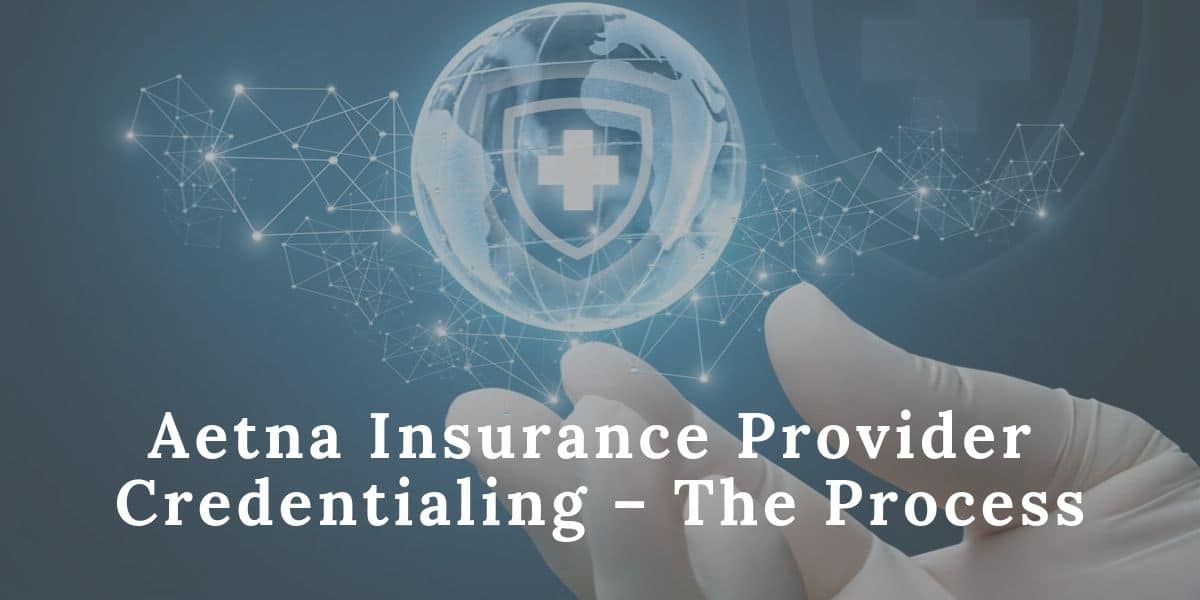
Aetna Insurance Provider Credentialing – The Process
Aetna Insurance Provider Credentialing is recognized as one of the leading providers of health insurance in the United States. Aetna continues to grow stronger, with millions of users enjoying its medical plan. Hence many physicians and medical practitioners want to become participants in the Aetna healthcare network. To become a participant, however, healthcare services need to apply for Aetna Insurance Provider Credentialing.
Like we mentioned, Aetna behavioral health provider credentialing has an extensive network of people who subscribe to their health insurance. If accepted as part of the network, a medical service provider naturally becomes an in-network provider and people with Aetna plan will be more inclined to use their particular medical service.
The Process to Apply For Aetna Insurance Provider Credentialing
The entire process of applying to get into any insurance providers network can be long and complicated. However, it is necessary to tap into those clients who have insurance, thus making the process mandatory to run a successful medical practice.
1. Obtain a National Provider Identifier
The NPI, also known as National Provider Identifier, is a ten-digit unique identification number used to replace provider identifiers such as the unique provider identification number in HIPAA standard transactions.
Healthcare providers must obtain an NPI in accordance with HIPAA regulations. AN NPI should be obtained before applying to get into the Aetna network.
2. Request for Participation
Aetna requires any medical provider with interest in participating in their network to first submit a request for participation before filling up the application. This request is then later assessed by Aetna to determine a need for the participating provider in the area of their practice.
The request can be submitted online on Aetna’s website, or by contacting Aetna provider service center directly. It is crucial to have your medical office’s tax I.D and medical license number in hand during the process. After review, Aetna will send your provider agreement via e-mail for signature.
3. Join CAQH UPD
The CAQH Unique provider data source is an online tool that conveniently gathers information required by health plans to obtain provider credentialing. The CAQH registration process prevents providers from submitting the same information to multiple health insurance plans. The medical practitioners are required to login to the CAQH page to complete and activate the registration process.
4. Completing the Application
Once you have obtained the NPI, and have completed the registration process with CAQH, the next step is to authorize Aetna to gain access to your enrollment application and other information. The entire application now takes place online and can be completed in less than two hours. The Aetna module is designed to save your application form automatically if multiple sessions are necessary.
5. Documentation
All supporting documents required for assessment should be submitted to CAQH. The documents needed are Curriculum Vitae, Medical License, DEA certificate, CDC Certificate, IRS Form W-9, Malpractice Insurance face sheet, etc. Aetna is very particular about who they include in their in-network. Their CVO uses strict guidelines to evaluate each medical practitioner’s qualifications, reputation, and competence.
Whom We Help with Aetna Credentialing & Enrollment
- • Physicians
- • Physician Assistants
- • Nurse Practitioners
- • Urgent Care Facilities
- • Therapists
- • Audiologists
- • Psychologist
- • Behavioral Health Providers
- • Physical, Occupational, and Speech Therapists
Join Aetna as an In-Network Provider with DENmaar
Being an Aetna in-network provider can be a very long and tedious process. The entire process requires at least 90 – 120 days to be completed and approved. There is a lot of paperwork, which makes the whole process quite frustrating for medical practitioners who want to accept clients with medical insurance. Aetna’s network is extensive, and harbors other insurance companies as well. you can get Meritain health insurance credentialing, Coventry insurance credentialing services etc. with the help of Aetna. That is where the professional assistance of DENmaar comes into play. With the help of our credentialing experts, we can walk you through the entire process without and complications and hassle so that you can work on other core areas of your medical practice.
Error: Contact form not found.
Learn More
Adding Therapists to Private Practice Insurance Credentials
Denmaar aids in the process of adding therapists to private practice insurance credentials. Navigating the treacherous process of getting on insurance panels can be overwhelmingly complex. The entire therapist credentialing process takes up to 90 -120 days to culminate. Even while the initial application process is done, you still have to be available on call for 45-minute conversations relevant to your credentialing process.
The process of Adding Therapists is lengthy, with lots of paperwork to manage, and steps to follow. This is where Denmaar comes to the rescue of medical practitioners. We understand how important the time of healthcare professional is, and offer robust credentialing services that take care of the complicated process for you.
To make things simpler, here is the step by step process of getting on an insurance panel for Adding Therapists:
1. Getting Your Information in Order
As we mentioned before, Insurance credentialing requires a lot of information and documents from the practitioner.
They are:
- Licensure Information
- NPI Number
- Resume
- Proof of Malpractice Insurance
- Taxonomy Code
- Proof of Liability Insurance from Landlord (Applicable on if you are renting)
- Credentialing Paperwork
2. Fill Out Your CAQH
You will find many companies who use the Council of Affordable Quality Healthcare for the purpose of credentialing. Before filling out the CAQH form, you are required to hold an authentic resume with no gaps in employment. The application is supposed to be completed online via the CAQH hub. The entire process can be extremely confusing to follow, but we at Denmaar assist you till the end.
3. Contact provider Relations
Once you have gone through the CAQH process, you are now afforded the liberty of choosing which insurance panel you want to be on. The insurance companies you choose may vary in the department of reimbursement rates, provider friendliness, payment speeds, etc.
Some companies may have their own sets of rules and requirements to apply. Now here you might face an issue of rejection, or not being accepted because the panel is full.
In such cases, you can do the following to build relationships with networks to gain access for future openings:
- Evening and Weekend Availability
- Experience with special populations
- Crisis services
- Handicap accessible facilities
- Being located in an underserved area
- Multilingual fluency
- Having an in-network referral source.
4. Submit Application
Once you have taken care of the documentation and decided on which insurance panel to join, it’s time to submit the application and wait. The entire process of getting paneled is relatively swift, culminating within 9-10 hours.
All you have to do now is a follow-up. You have to keep tabs on the status of your application. Chances are it might expire while still in the process if taken too long, and you don’t want to start again. The insurance companies have to be notified every time you submit a document to ensure it has reached them.
5. Review after Approval
Once you have received approval, it is still not an appropriate time to celebrate. Do the following to be on the safer side.
- Review your contract carefully before signing
- Keep a file with the agreement and any addendums ready for future reference.
- Learn more about the insurance provider’s portal on their official website.
- Collect a list of phone numbers for the claims department, pre-authorization department, and provider relations.
Once you have taken care of the above bucket list, you are ready to sign. To speed up the process, Denmaar will help you submit your claims electronically. This will help you save time, money, and paper.
Learn More